
UNLEASHED Building communities through play & recreation Off-leash Dog Park Design Trends & Planning Tips™ For more information on building communities through play & recreation: playcore.com | (877) 765-7563
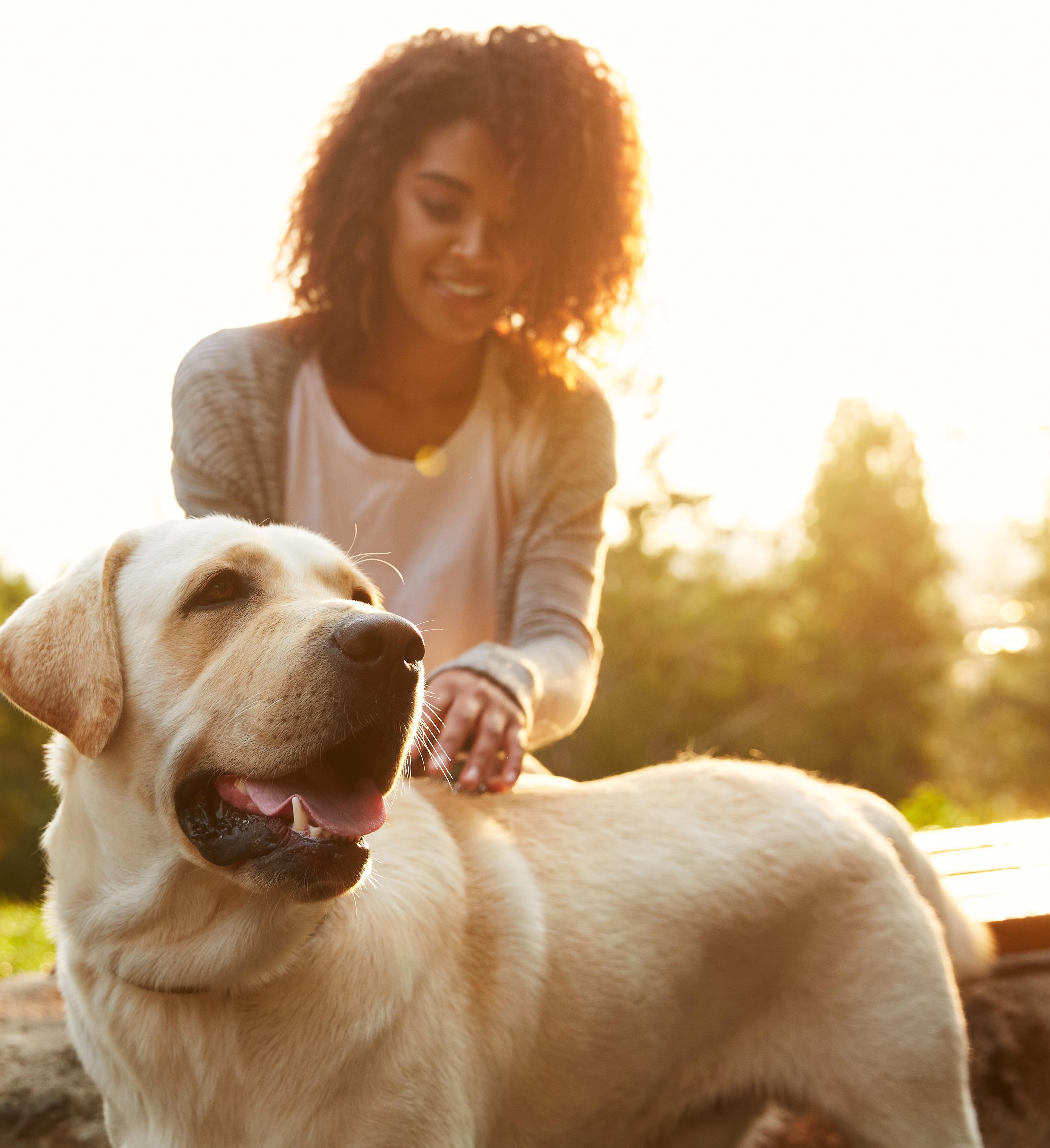

Building communities through play & recreation
Dog Park Design Trends & Planning Tips™
UNLEASHED
Off-leash

The purpose of Unleashed®: Off-leash Dog Park Design Trends and Planning Tips, is to provide education and considerations about incorporating off-leash dog parks into communities. This is not to be considered as an all-inclusive resource. Please refer to manufacturer specifications and safety warnings for all equipment. While our intent is to provide general resources to encourage communities to include off-leash dog parks as a recreational option for dog owners and their dogs, the authors, advisors, program directors, and contributors disclaim any liability based on information contained in this guidebook. Site managers are responsible to inspect, maintain, repair, and manage site-specific elements, and to ensure that trainers and program directors employed on-site are certified in the fields in which they provide programming. PlayCore and its divisions provide these comments as a public service in the interest of building healthier communities through play and recreation, while advising of the restricted context in which they are given.
1 FOREWARD 3 MAKING THE CASE 5 The Value of Dog Parks 5 Health & Well-Being Benefits 7 Social & Community Benefits 9 DESIGNING A HIGH-QUALITY DOG PARK 11 Dog-friendly Settings 11 Location & Context 15 Exercise & Agility Equipment 19 Amenities & Accessories 27 Drainage & Surfacing Materials 35 Plantings & Landscaping 39 Layout & Design Typologies 41 MAINTAINING & SUSTAINING YOUR DOG PARK 45 Protecting Your Investment with Proactive Planning 45 Equipment Inspection & Maintenance 46 Surfacing Maintenance & Replenishment 46 Weed Control 48 PLANNING & COMMUNITY ENGAGEMENT STRATEGIES 49 Planning & Implementation Considerations 49 Partnerships & Fundraising 51 Marketing for Success 55 Programming the Space 58 CASE STUDIES 59 Increasing services for stress-free travel (Buffalo Niagara) 61 Yappy hour and more, putting the FUN in fundraising (Charleston, SC) 63 Transforming an underused floodplain into a PAWpular dog park (Stockbridge, GA) 65 Embracing the needs of residents and donors through conscious planning and land use (Gahanna, OH) 67 PAWineers of the RV park industry (Lake George, NY) 69 A unique partnership for increasing dogs’ and dog owners’ physical activity (Vancouver, Can.) 71 REFERENCES & RESOURCES 73 CONTENTS
Building communities through play & recreation™
2019 PlayCore Wisconsin, Inc. All rights reserved
©


2


3
FOREWARD
Many years ago, when I began hearing about “dog parks,” I was skeptical. As a trainer, it seemed like there were so many ways this idea could go wrong! But as I have witnessed the growth of dog parks and the education of pet owners over the years, I must admit I was the one that was wrong! Dog parks are an integral part of urban/suburban communities that have far reaching implications beyond a place for a dog to “relieve themselves.” Dog parks are not only places where our dogs can enjoy each other but where owners and pet lovers can find kindred spirits. Over the past decade, being involved with the national Bark for Your Park contest and now the Dog Park Dash grant program, I have seen the power of community that dog parks ignite.
For dogs, especially ones whose owners work long hours, regular dog park visits can provide an outlet for the day’s pent-up vitality and energy and most owners will see a reduction in frustration behaviors at home. Dog parks provide socialization – a key component in most dogs’ psyche. Multiple studies have proven that social interaction with other dogs is a genetically wired need (they are pack animals). We as humans can provide a piece of that puzzle, but there are some things we just can’t replicate. Dogs recognize and learn to talk to each other with many overt and subtle cues, some almost imperceptible to us. Being on a leash or behind a fence disrupts this communication and so a dog park can allow our “dogs to be dogs.” The complicated and intricate dance of dogs simply greeting each other is a marvel of body language communication unto itself!
Benefits of the dog park extend beyond canines to their owners (after all, dogs don’t walk themselves to the park —PEOPLE do). Dog parks bring people of all walks of life together, and age, ethnicity, gender, socioeconomic status, etc., all seem to melt away when we talk about our dogs. Friendships, clubs, and even marriages have started at dog parks! They also provide good learning opportunities for owners. You get to see how your dog acts naturally with their own kind and you’ll probably learn new things including how your dog reacts in many different situations. This information is not only interesting but will help you predict reactions when faced with situations outside the park as you expand your knowledge base of your own dog’s independent behavior.
This past year I saw everything from small rural communities to high rise urban neighborhoods rally together in their own unique ways to raise money/make space and do whatever was necessary to bring a dog park to their community. Perhaps one of the best examples of an expanding dog park awareness was a friend of mine in Florida who is a luxury apartment developer. On his newest project they allotted a special dog park space, in addition to a children’s playground area, because the demand for the dog area was so great.

Along with all of these new dog parks comes the opportunity to share learning, knowledge, and innovation. Now is a better time than ever to utilize resources such as this one to create a blueprint for your community and implement a spectacular dog park - not only for your dog - but for your human friends to enjoy for years to come.
 Harrison Forbes Animal Behavioralist, Dog Trainer, Author www.harrisonforbes.com
Harrison Forbes Animal Behavioralist, Dog Trainer, Author www.harrisonforbes.com
4
Making the Case
To better advocate for off-leash dog parks, it is important to understand the demand for these spaces and the benefits for dog owners and the broader community. These areas are sought after by pet owners for multiple reasons. While demand stems from a growing number of individuals owning a pet, the value and benefits of these spaces extend beyond pets and their owners – making a statement about a community’s commitment to offering amenities that attract a richly diverse and active population.
The Value of Dog Parks
According to the 2019 City Park Facts report by The Trust for Public Land,1 parks where dogs can roam freely off-leash are the fastest growing segment of urban parks; the report shows that off-leash dog parks grew 3% since 2015. Others agree that there has been an increase of dog parks, across the U.S. Since 2009, the largest 100 U.S. cities saw a 74% increase in dog parks.
2012 43.3 2017 60.2 Million households own at least one pet
There are more than 1,000 off-leash dog parks in the U.S. and many park districts are considering developing dog parks in their communities.2 The recent Recreation Management State of the Industry Report3 states that 38.8% (a 3% increase from 2014) of parks sampled for the article include dog parks; if they currently did not offer dog parks, 13.5% of respondents stated that they plan to add a dog park to their facilities over the next three years. In addition, Parkology, a partnership among the Trust for Public Land, the National Recreation and Parks Association, and City Park Alliance provides a wide range of tools, guides, and information about parks, including information on amount of dog parks per 100,000 residents once a specific city has been selected. For more information visit www.parkology.org
The development of dog parks is reflected in demographic changes as well. Pet ownership in the U.S. has more than doubled since the 2000’s
28% increase in pet ownership Million households had pets
when approximately 43.3 million households had pets, compared to 60.2 million in 2017, for a 28% increase over 15 years of American households that owned at least one pet.4 According to a report found in the Humane Society of the United States created by the American Pet Products Association (APPA), 48% of households own at least one dog with an estimated U.S. dog population of 89.7 million.4,5 Of those that own dogs, 70% have one, while 20% own two dogs, and 10% own three or more dogs.6 In addition, 50% of individuals own a small dog, 28% own a medium dog, and 35% own a large dog.4 Lastly, the actual sales expenditures in 2017 on pet related products in the U.S. was $69.5 billion.5
There is an array of studies, reports, proposals, and articles regarding the benefits of dog parks; off-leash dog parks benefit not only dogs, but dog owners and the overall community. At the individual level, being outdoors in a dog park offers diverse therapeutic, physiological, psychosocial, and psychological benefits.
5
48%
Dog Parks
89.7 Million
dog population households own at least one dog
Emerging research suggests pet ownership impacts the individual, and that there are “collective benefits that accrue to communities through the presence of pets, benefits that extend beyond pet owners themselves.7” It has been found that owning a pet is directly linked to fewer visits to the doctor and improved overall health.7
Additionally, there are recreational benefits to pet ownership; it has been found that individuals who own a pet are:
• more likely to participate in activities outdoors;
• generally, more active and healthier than other individuals;
• more sociable, even with individuals they do not know well, enhancing the individuals’ well-being.8-11
Even though it has been shown there are countless benefits to physical activity, only 30% of adult Americans report they actually engage in physical activity during their leisure time, while 40% of adult Americans state they do not engage in any physical activity at all.12 Moreover, the Centers for Disease Control and Prevention (CDC) states that fewer than two in 10 Americans get the recommended levels of regular exercise.13 Therefore, providing recreation solutions are extremely important.9
Research also shows that “dog walking is an example of purposive physical activity and has been examined as a mechanism for promoting moderate physical activity.” In addition, authors indicated that there is “evidence suggesting that promoting dog walking could address physical inactivity and obesity.9” Others go even further in stating that dogs and dog walking provides physical health benefits linked to a decrease in risks of cardiovascular diseases such as hypertension and high cholesterol.
Cities with the highest per capita numbers of off-leash dog parks among the nation’s 100 largest cities:
10% own three or more dogs
20%
70%
one dog
$69.5 Billion
actual pet industry expenditures in 20175
6
City Per 100,000 Number of residents dog parks Boise, ID 5.7 13 Portland, OR 5.4 35 Henderson, NV 5 33 Norfolk, VA 4.8 12 San Francisco, CA 4.0 35 Tampa, FL 4.0 15 Las Vegas, NV 3.9 25 Madison, WI 3.9. 10 Oakland, CA 3.8 16 Arlington, VA 3.5 8 Source: The Trust for Public Land, 2019 City Park Facts
own
own two dogs
Health & Well-Being Benefits
It is no surprise that dogs make a difference in the lives of individuals. It has been stated that dogs have been linked to reduced occurrences of psychological conditions, including depression, stress, and grief.7 Dogs are seen as companions and even best friends for some; therefore, dog parks are important outlets for humans, as they provide recreational opportunities and bring together dog lovers of all ages and socioeconomic status.
In recent years, there has been an accumulation of evidence that associates dogs with physical, mental, and social dimensions of human health.7 Dog parks may provide a safe place for older people or people with disabilities who may not be able to walk their dogs. Dog parks provide areas where dogs can exercise and run freely while their owners can socialize. In addition, spending
time with their dogs at the dog park reinforces the dog-owner bond.
According to one study, owning a dog indicated a potentially health improving average effect of 22 minutes of additional time spent walking and 2,760 additional steps per day. Most of that extra walking was done at a moderate cadence, defined as 100 or more steps a minute. The dog owners studied also had significantly fewer sitting events.14
Evidence also supports the healthy effect of dogs on older populations, who often find a lack of motivation, feeling sluggish, unproductive, and even isolated. Since dogs thrive on structure and consistency in daily life, they depend on their owner to be walked, exercised, and loved. For some, having a dog means the difference
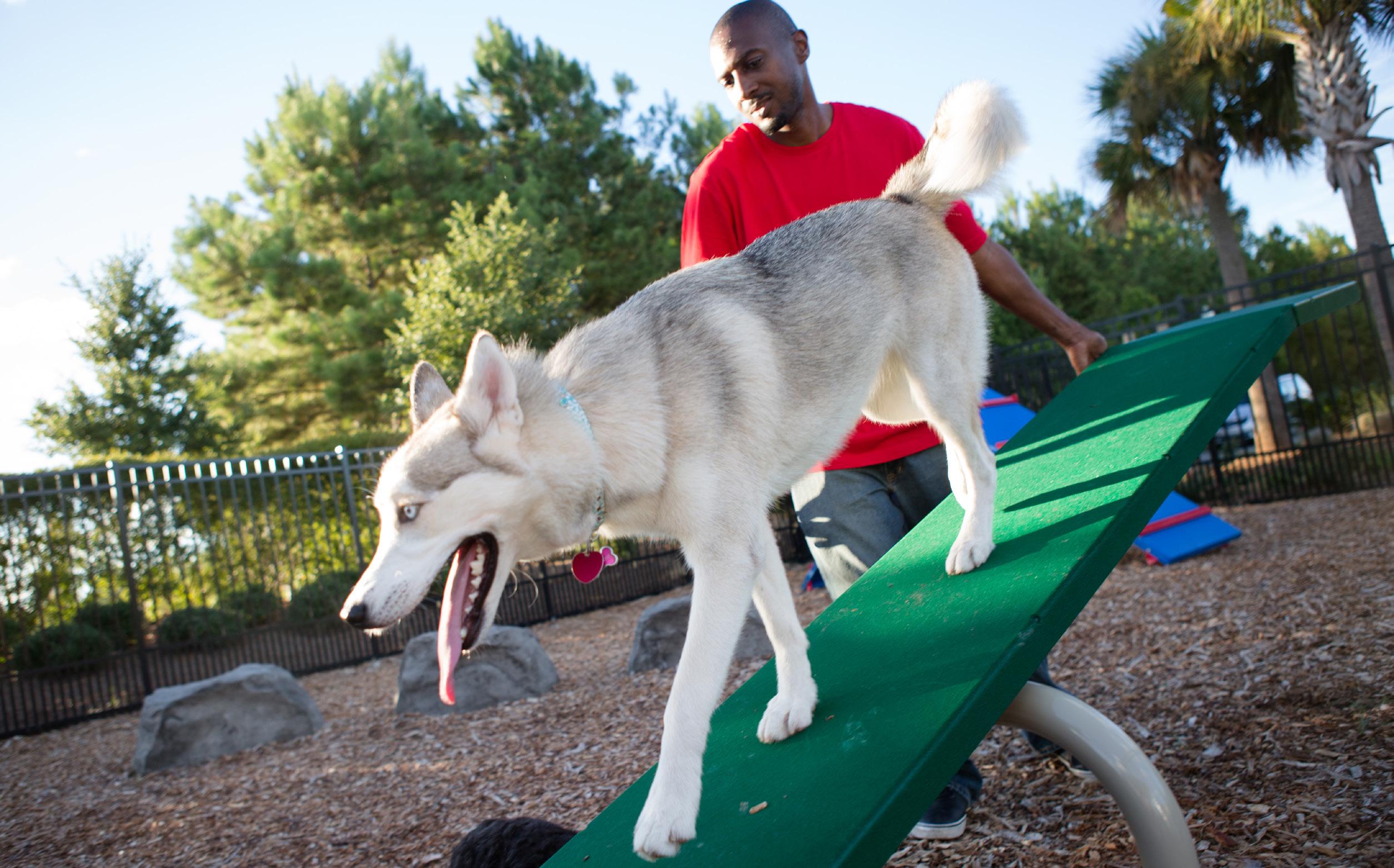
7
“ People say, ‘I never knew my neighbors until I went to the dog park.’ You meet all these wonderful people and the only thing that you have in common is that you have a dog and that you love dogs - you wouldn’t meet these people anywhere else.”
http://www.fetchparks.org/why.html
between a life lived and a life merely endured. Dogs can help a person to find purpose, stay safe and be independent: They can be ears, eyes, and mobility enhancements for people with disabilities as well as an early warning system for danger.15
Health and well-being benefits also extend to the dog itself. As leash laws continue to become increasingly restrictive, many community public leadership committees are seeing dog parks as a way to let dogs run free and get adequate exercise without penalty to pet owners or potential damage to private property. Dog parks also promote safety because the pet owners are not walking on busy streets. Public dog parks allow dogs to get ample off-leash exercise and social activity with other dogs. When dogs get the adequate physical and mental exercise they need, humans are able to notice a decrease in the level of troublesome behavior from their dogs which will benefit society as well.
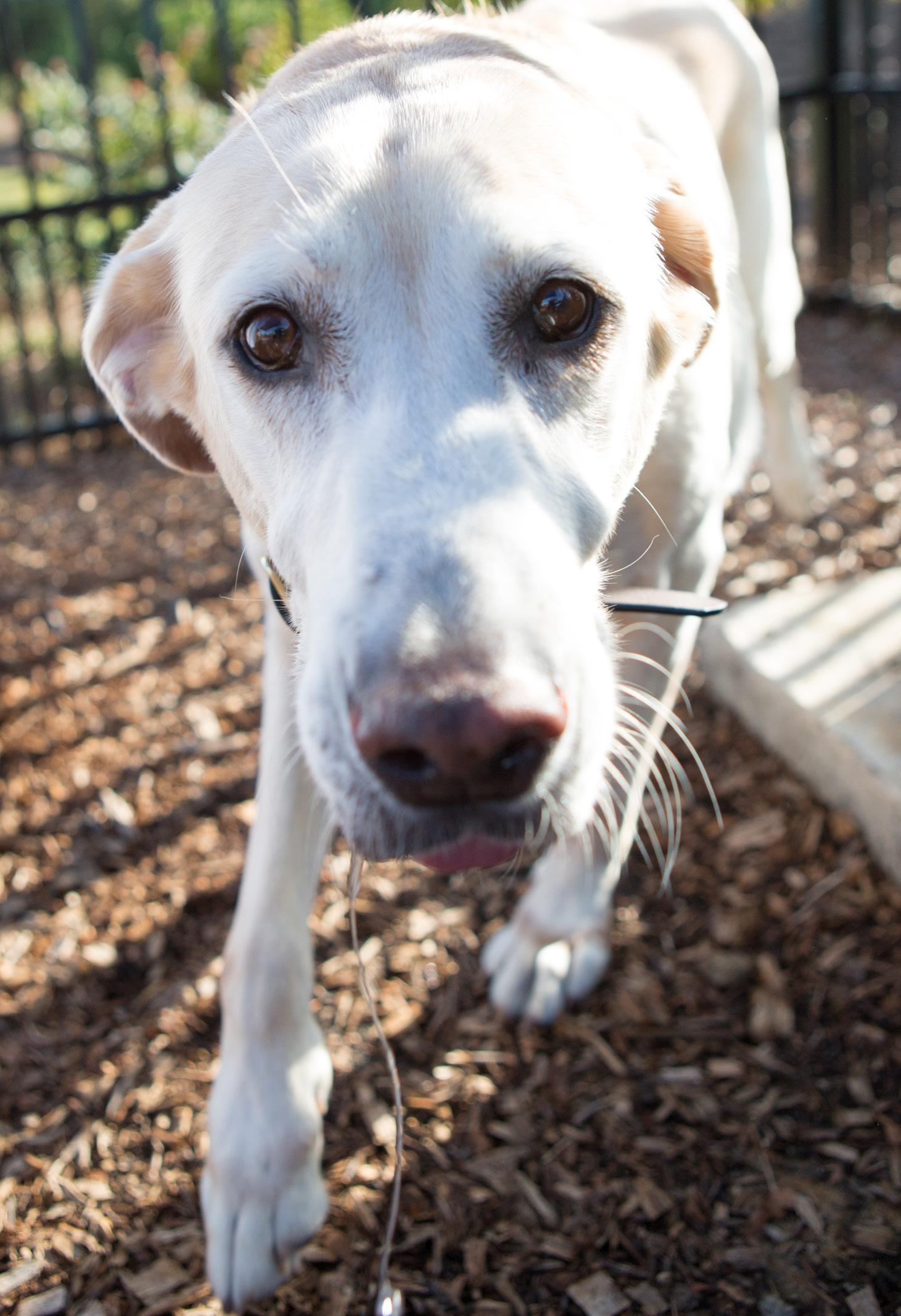
Dog parks can facilitate socialization between a variety of breeds. They can also be a wonderful outlet for adolescent dogs that have lots of energy and no place to release it. Physical
8
Mental
yourself fit and active
yourself friendly
yourself happy
yourself alert
Social Emotional
Keeping
Keeping
Keeping
Keeping
Ali Rutzel, head of Citizens for OffLeash Areas (COLA)
Health and Well-Being Benefits
Social & Community Benefits
Dog parks are social capital catalysts. These green open spaces bring people “out and about” by promoting walkable neighborhoods and an enhanced sense of community. In addition, communities have seen a positive effect on the visible presence of individuals walking with their dogs and the motivation dogs provide for their owners to walk. This generates an increased feeling of collective safety. Further research explains that “animal presence can facilitate human social approach, increase the likelihood of social contact, and serve as a conversation trigger between strangers or casual acquaintances.”7
To further define the social and community benefits, it was found that a total of 40.5% of pet owners indicated that they had become acquainted with other people in their suburb through their pets. Three quarters of dog owners (75.8%) indicated that owning a dog encouraged them to walk in their suburb more frequently. Of
those who walked their dogs, more than fourfifths (83.8%) talked to other pet owners when doing so. Pet owners were more likely to feel that people in their suburb generally say hello to each other, 89.5% of pet owners compared with 79.1% of non-pet owners.7
Dog parks can act as a gathering spot for people. They bring their pets to the park to get exercise and socialize with other dogs, while they often engage in similar behavior. Dogs are natural icebreakers.
In a study published in Leisure Sciences: An Interdisciplinary Journal16, authors Taryn Graham and Troy Glover of the University of Waterloo explore the ways that dog parks may help people build relationships, therefore enhancing their community. The study found that pets serve as a common thread among people at the dog park, allowing owners to meet people and navigate space through their pets.
People who exchange greetings in their neighborhood pet owners
89.5%
40.5%
Get to know other people in their suburb through their pets
79.1%
non-pet owners
75.8%
Walk in their suburb more frequently with their pets
83.8%
Talk to other pet owners while walking their pets
9
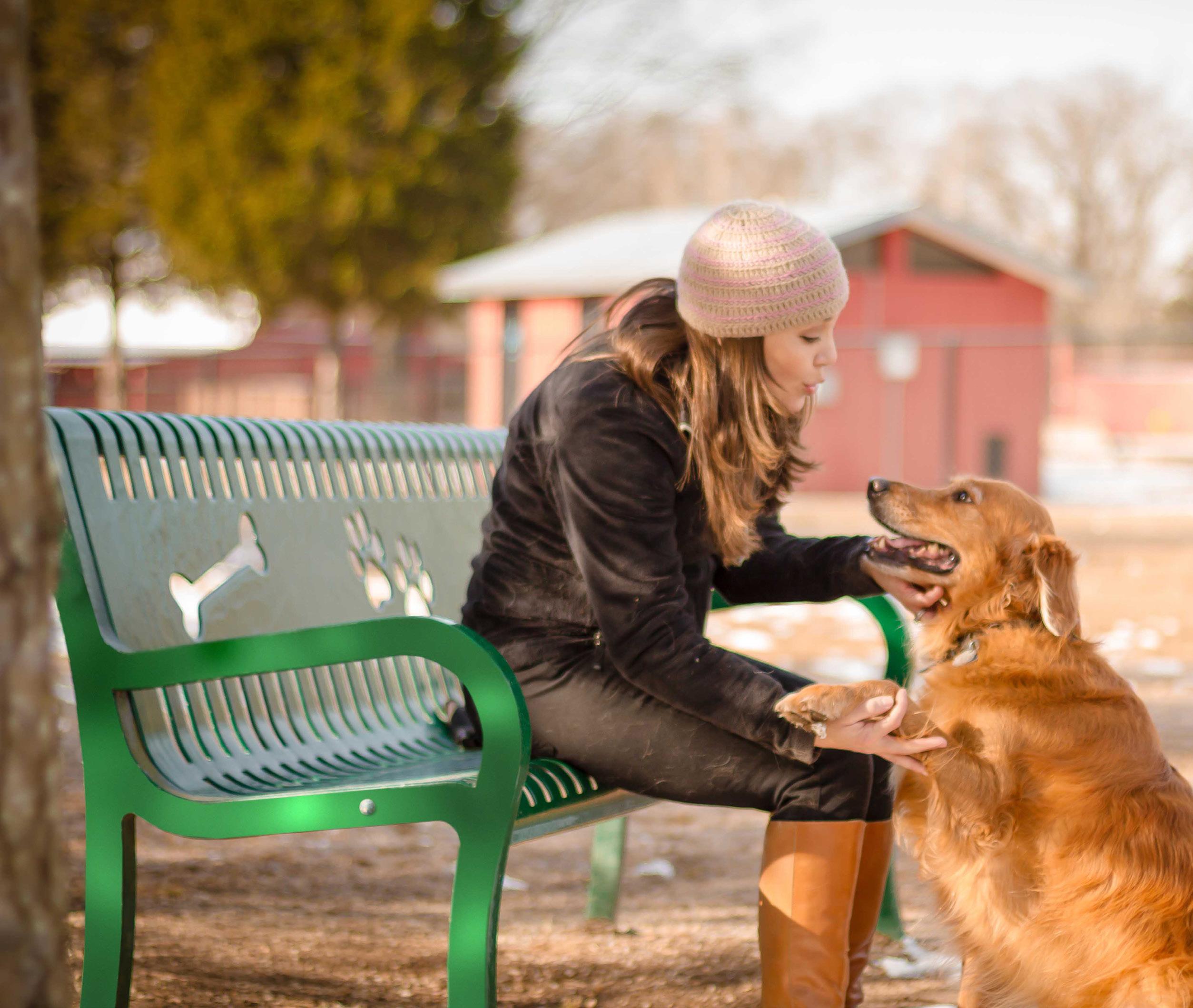
The study also noted that demographics of park visitors do not seem to matter in forming relationships, and that the human interactions appear to be based on how each owner’s dog behaves toward other dogs and people. Another common topic was the need for and recommendation of commonly used pet-centered services. The dog park provided a place for owners to give and receive information about local veterinarians, groomers, and pet stores as well as referrals related to housing and employment. Some owners surveyed have extended their friendship on the commonality of owning dogs, and have shared resources like carpool or tutoring.
The relationships also extended into the realm of social media, as some regulars at one of the parks created a Facebook page so that dog park users could maintain contact while not using the dog park, as well as share photos. In addition, it was discovered that dog owners were occasionally asked by the local government to serve on committees to help address issues such as park maintenance and pet overpopulation.
This study highlights several ways that dog parks may increase social interactions among residents, influence outdoor recreation, and build social and community capital.
10
Sitting areas provide a welcoming environment for social engagement among dog owners and their dogs.
Designing a High-Quality Dog Park
Designing a meaningful dog park involves several steps, including selecting the right setting, ensuring the location and context within the setting is meaningful for diverse users, choosing a good mix of equipment and accessories to ensure usability, and adding landscaping to complete the space. In addition, considering the size of the space in relation to layout and design typology is also important to ensure the dog park is comfortable for both dogs and their owners.
Dog-friendly Settings
Today, dog parks can be found across a variety of settings to meet diverse goals. While parks and recreation departments have historically provided them, others have also started to realize dog owners prefer to engage in activities with their faithful companions. More and more, these areas can be found in what some may call unconventional or innovative locations.
Parks and Recreation
Historically, park and recreation departments have been the ones to first recognize the need for open spaces for dogs. Most park and recreation departments already offer spaces for individuals to enjoy the outdoors including sports fields, trails, playgrounds, picnic areas, disc golf, retreat centers, aquatic centers, and more. Depending on specific rules, dogs may be welcome on-leash at most recreational areas. However, these departments understand owners want their dog to be able to play and run with other dogs. As a response to this need, off-leash dog parks may have been created within or near a larger recreation area to increase crossover usage of facilities.
Housing Complexes
As the pet industry continues to grow, businesses and companies are starting to understand how important dogs are to those that care for them. More organizations are marketing to and
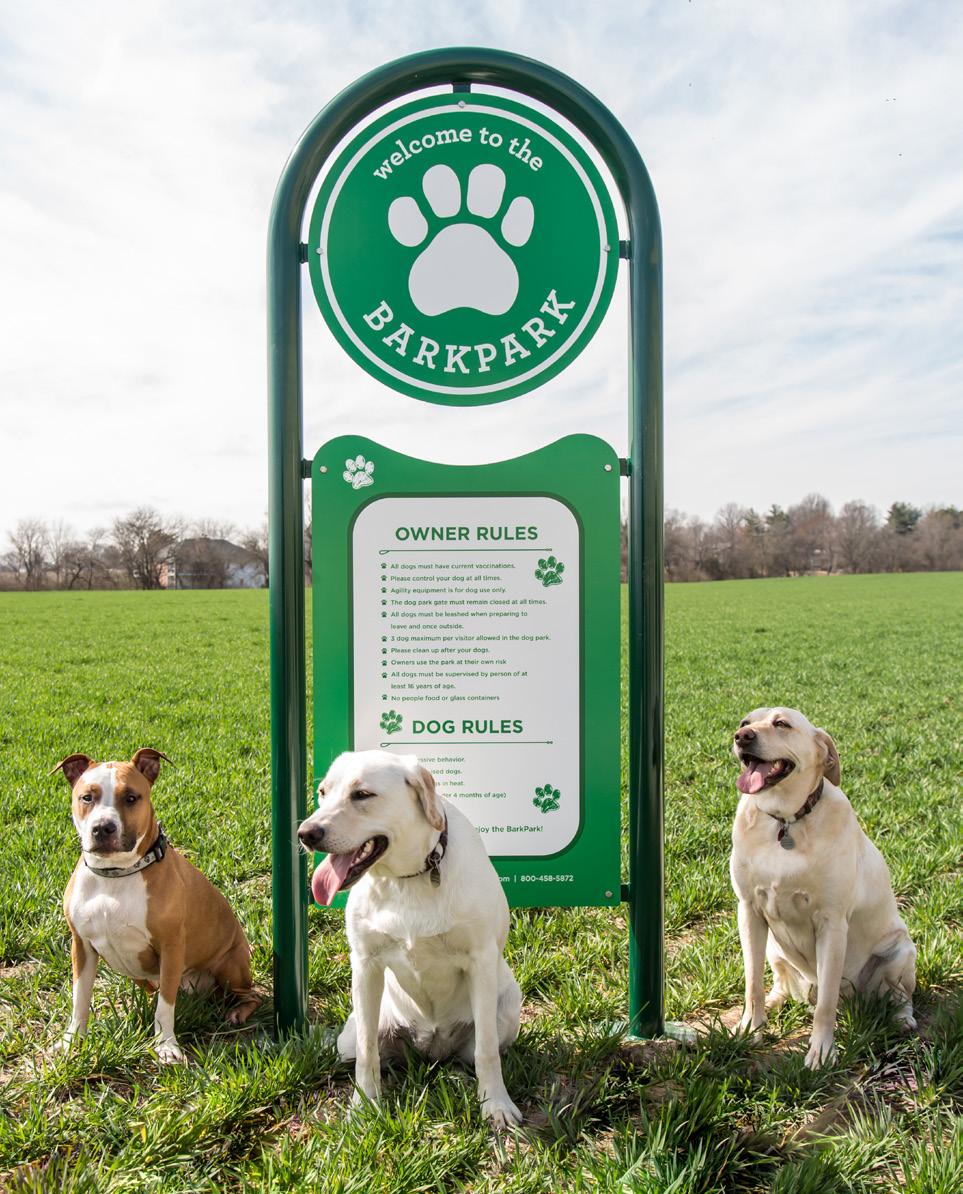
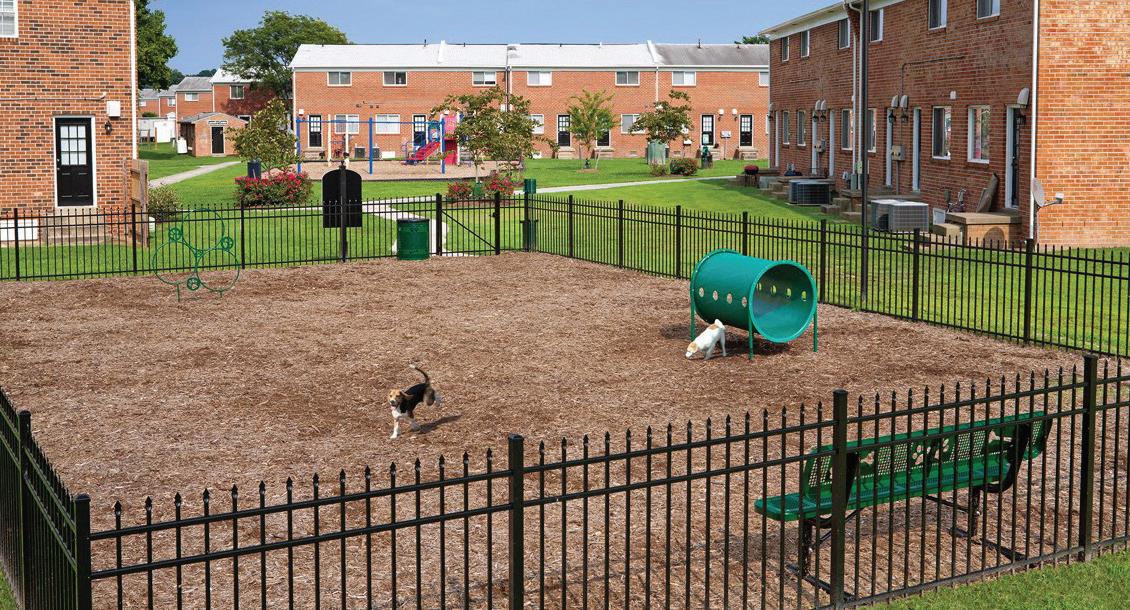
11
planning for this segment of the population. It is not surprising that owners of multifamily housing and neighborhood associations are starting to integrate dog amenities into their properties to add a competitive edge by targeting pet owners.
By offering dog parks or dog-related amenities in housing complexes, they attract tenants who are willing to spend more money to accommodate their loyal companion. Some offer fenced-in dog parks with equipment, while others may offer pet washing stations, doggy pools, agility equipment, discounts at local pet service businesses, or a combination. These accommodations may be most valuable to residents living in complexes with limited access to green space.
Resorts, Hotels, and Motels
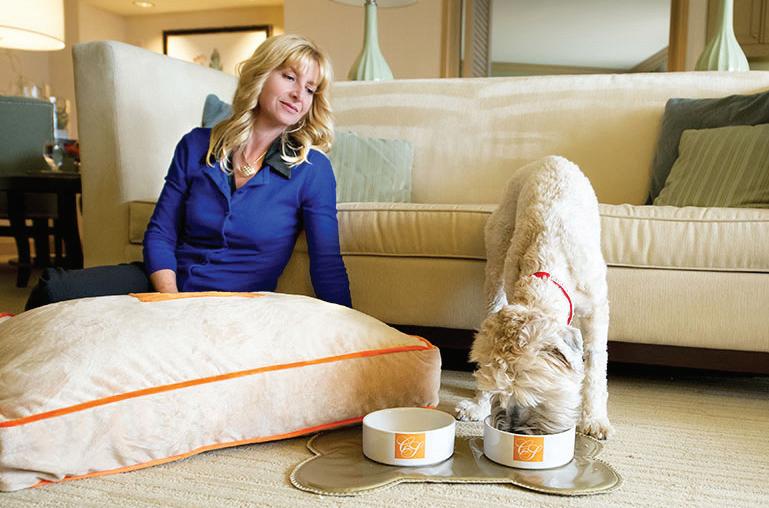
With the increase of dog ownership in the U.S. and many refusing to leave their dog at home while going on vacation, hospitality settings have become more inclined to allow guests to bring their pets for a small fee, and realize the need for communal areas that both people and their companion animals can use. Some of these facilities provide access to off-leash areas on or within their properties.
Resorts and hotels may offer additional pet services, like in-room massages, room service menus, a welcome gift for dogs, and cleanup bags. Gradually, hotels are starting to cater to dogs of all sizes. Resort, hotel, and motel settings are more aware of the need and potential of the market – some may offer luxury accommodations including high-end brand products appealing to both owners and
dogs, and specialized classes at beach resorts like “doggy surfing.” Other hospitality settings that may offer dog-friendly accommodations include: cabins, beach houses, cottages, and condos available for short and long-term rentals.
For more information, visit BringFido.com where you can browse pet-friendly destinations worldwide and chat with a pet-friendly travel expert.
Airports and Airlines
Traveling with dogs takes planning. While air travel can be a fast way to get from one place to another, airlines have varying guidelines about traveling with dogs. Some airlines allow small dogs to travel in the cabin in pet carriers that fit under a seat, although other airlines only allow pets in the cargo area. Fees also vary from free up to $500.
Airlines may allow one or two dogs per flight, but planning in advance is a must. If you decide to travel by plane with your dog, selected airports in the U.S. offer off-leash dog parks on their properties. Atlanta’s Hartsfield-Jackson Airport has established a 1,000-sq. ft. dog park outside the ground transportation area. The space is fully fenced and offers two original art pieces, flowers, grass, rocks, benches, and biodegradable waste bags.
The “Airport Park Dog Park,” operated by the City of Santa Monica, CA, offers separate, fenced-in areas for large and small dogs, as well as impeccable landscaping, wood chip surfacing, and free parking. Maintenance is performed every morning to keep the area tidy and free of odor.
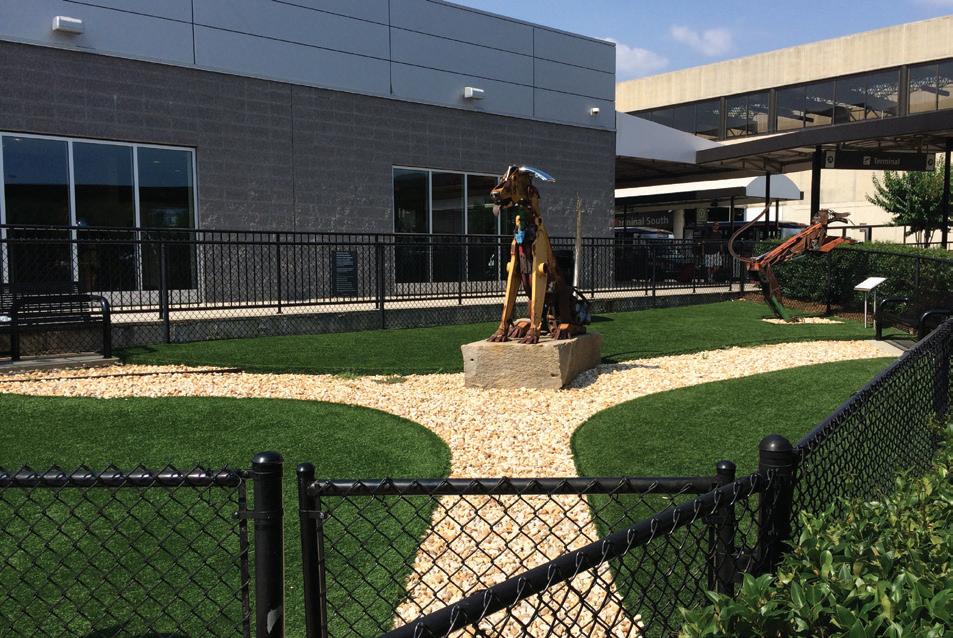
12

Rest Areas
Traveling on the open road can be rather daunting especially if faced with congestion, traffic, accidents, and the like. Add to that an energetic dog in the back seat, and the need for periodic stops is very clear. Finding accommodations may not be as difficult as it was in the past, but finding fenced-in dog parks at rest areas along the highway that welcome drivers and their pets may be challenging. While rest stops may already offer areas to briefly walk your dog, there are a few rest stops that now offer formal dog parks such as:
• Roanoke Rapids, NC, rest area at the Halifax County Visitor Center off exit 173 offers two fenced-in areas – one for small dogs and one for larger dogs – where dogs can stretch their legs while on a road trip.
• The Oklahoma Welcome Center Dog Park is located at mile marker 9 on I-40 in Erick, OK, just past the state line. They provide a divided area for small and large dogs, waste bags, shade, grass, and water fountains.
Restaurants and Eateries
Visiting restaurants can be a fun way to spend some time with friends and family. For those individuals that do not want to leave their dogs behind, coffee shops, brew pubs, and restaurants are also catering to dog owners. Some city rules permit dogs to visit eateries but only in outdoor seating areas. Some eateries are going above and beyond by allowing dogs to have dinner
alongside their owners and choose from a specialized dog menu.
RV Parks and Campgrounds
Other industries are also embracing dog parks. Managers at RV parks and campgrounds are aware dog owners may extend their stays if amenities for their faithful companions are included. Today, many of these facilities are serving people traveling with dogs. RV destinations and campgrounds are realizing that some owners prefer to bring their dogs along with them, especially those that own a dog that may suffer from separation anxiety, or others who simply do not want to board their dogs when they go on extended vacations.
Many RV parks and campgrounds across the U.S. have become pet-friendly as a result of visitors’ needs. Some are establishing specific areas for dogs (fenced and unfenced) and some have built amenities such as dog wash areas and installed dog-friendly vending machines.
Rooftops
As with multifamily housing and neighborhood associations, apartment/condominium buildings located in urban areas are integrating more amenities than ever before to attract tenants or buyers. Some are already offering rooftop dog parks as unique amenities. Some individuals are seeking these spaces as they prefer not to walk on busy streets. In addition, most of these spaces provide views of the city that otherwise would not be available. The dog park helps socialize the dogs, and neighbors can also get to know each other better, forming stronger social bonds as a community within the building.
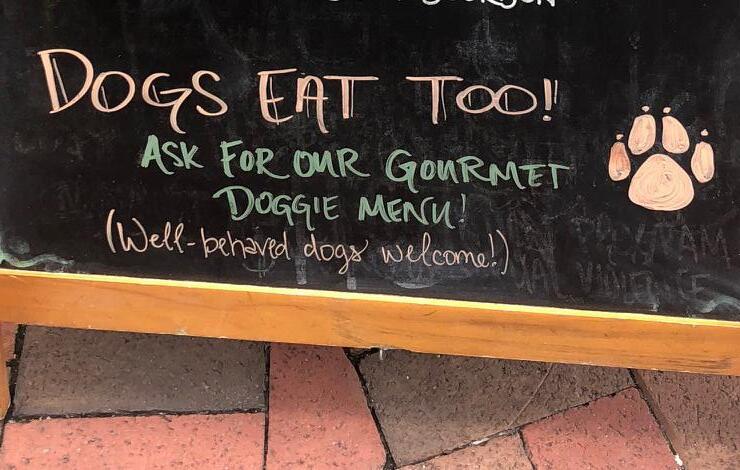
13

Corporate Settings
Considering the many benefits of dogownership, thinking about establishing a dogfriendly work environment may be of importance. More than ever employers and employees are starting to acknowledge the advantages and benefits of allowing pets in the workplace. Even the growing body of research on the topic is supportive of this trend.
According to a recent study conducted at the Virginia Commonwealth University19, employees who bring their dogs to the workplace experience less stress during the day. In this study conducted at a company in Greensboro, NC where 20 to 30 dogs are present daily, it was found that as the work day went on, stress for employees with dogs present declined as it did for those individuals that were not pet-owners. For dog owners who did not bring their dogs to work, the stress level increased significantly during the afternoon and by the end of the day.
Besides designing programs that allow employees to bring their dogs to work, businesses are also designing off-leash areas for them. A national poll of working Americans conducted in 2008 by the American Pet Products Association (APPA) showed that 17% of companies allow pets in the workplace. Visit Trupanion (see resources section) to learn more about establishing general guidelines for dogs in the workplace.
Research has shown that bringing your dog to the workplace decreases stress levels.19
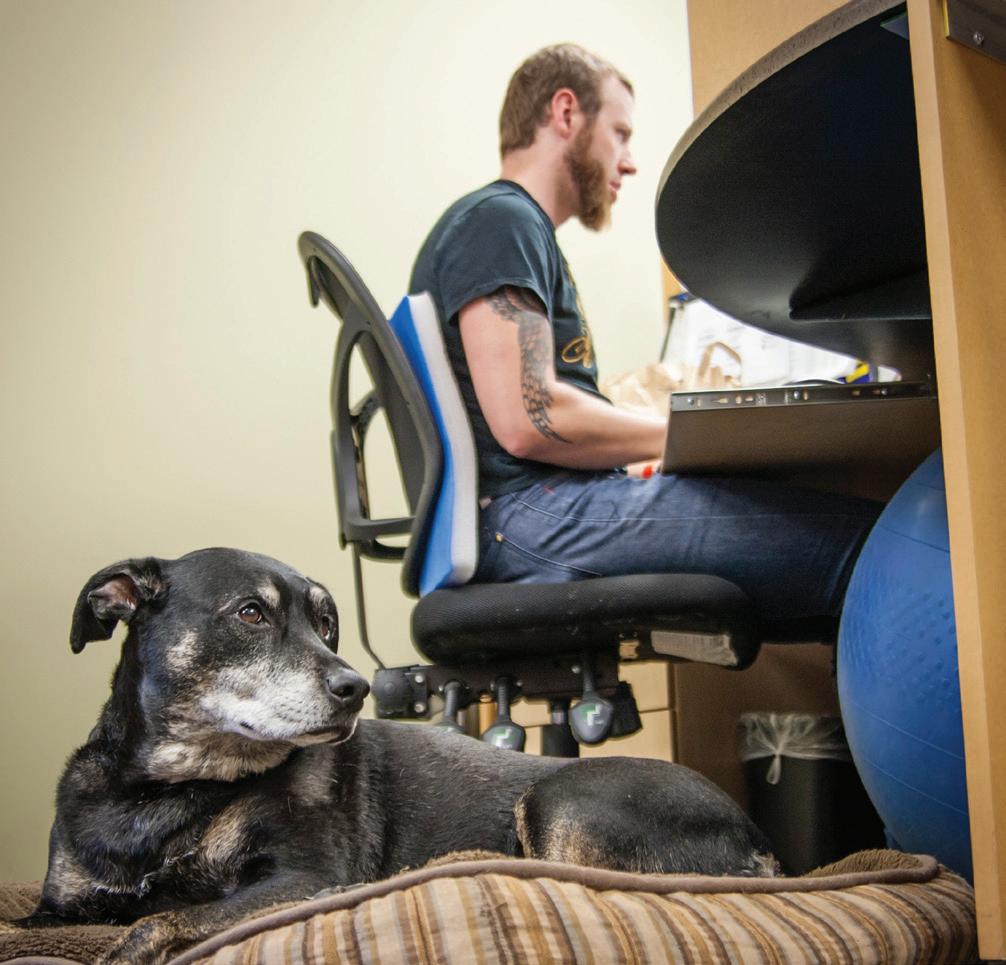
Other locations offering rooftop dog parks are businesses like Amazon. In their Seattle headquarters, they have created an eye-catching office space which includes new corporate space, retail, and public amenities, as well as an area for their dog park. The dog park is open to employees (Amazon is a dog-friendly company that allows their employees to bring their dogs to work –there are a reported 6,000 dogs that “work” there) and also to the public. With an area of about 1,000 sq. ft., the park is usually busy with visitors that enjoy each other’s company and the views of the surrounding area.
Unique and interesting dog park locations continue to evolve as communities expand offerings to serve people and their pets. Businesses are shifting their priorities to be more welcoming, the hospitality industry has expanded dog-friendly services, housing is now more inclusive for tenants with pets, and parks continue to be a critical provider of outdoor activity for them. It is becoming more common and acceptable to go anywhere with your dog and businesses are taking note.
14
Urban areas with limited space are offering rooftop dog parks as a unique amenity that can also provide great views of the city for all visitors to enjoy.
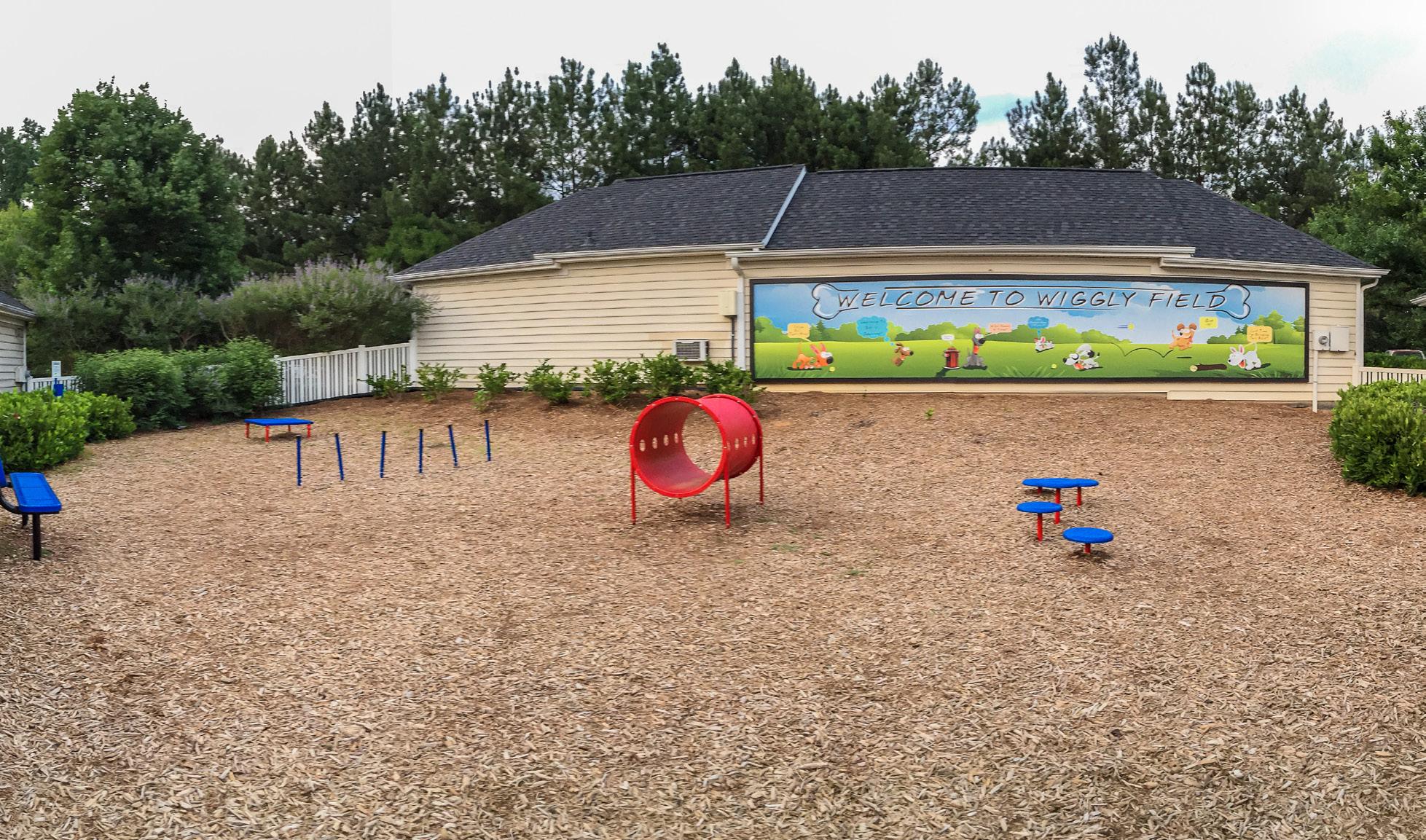
Location & Context
Selecting a location for a new dog park requires careful planning and community input for longterm sustainability. Consider population density, number of pet owners, existing availability of green space where dogs are welcome, and other factors. Dog parks can be located in a variety of pet friendly settings including pocket parks, small or large areas, or within another large space or recreation area that may increase crossover usage of all facilities. To gather community input, consider using surveys, public meetings, emails, social media, and even phone interviews to help identify the most meaningful locations. Design the questions to gain a better understanding of the existing dog population, the desire for, or concerns about dog parks, geographic distribution, and locations where dog parks would not be acceptable. Refer to the Planning & Community Engagement Strategies section of this guidebook for more information on gathering support within your unique community.
Many communities are now including planning strategies across a variety of settings from dense
neighborhoods to open spaces. Dog parks may be more successful if placed in areas that have previously been underutilized in the community, or are empty.17 In some instances, spaces may need to be carved out from existing park land.
As an example, according to the U.S. Census, cities are home to 62.7% of the U.S. population, but comprise just 3.5% of land area. The population density in cities is more than 46 times higher than outside of cities, with 1,593.5 people per square mile, vs 34.6 per square mile outside of urban areas. This population density increases substantially in larger cities; in those with a population over one million, there are 7,192.3 people per square mile.
This urban density implies a decrease in private outdoor space available for exercising dogs within backyards. In an urban setting, therefore, we can expect that there will be a growing trend to exercise dogs outside of the home. It is also reasonable to expect that as urban areas increase in density, there will be an increased requirement within the community for dog-friendly spaces and places, including dog parks.
15
When considering locations, The Humane Society of the United States18 offers the following suggestions which can be helpful when identifying needs and potential location requirements:
• 1-5 acres is a good target as smaller parks may experience overcrowding problems, while larger parks may be too big to be well-controlled*
• Good drainage to prevent muddy conditions that make the area unusable
• 5-6-foot fence to prevent dogs from jumping over the fence
• Double gate system to prevent dogs from escaping when other dogs and their owners are entering or leaving the dog park
• Water fountain for thirsty dogs
• Covered containers for disposal of dog water and dog waste removal supplies to promote clean up
• Shade trees to provide protection from summer heat for dogs and pet owners
• Central, well-lit location to ensure the safety of dog owners and their dogs
• Access for people with mobility devices so that all people can use the dog park
• Benches for pet owners to relax with each other and observe their dogs
• Signs to clearly display rules of the dog park and its boundaries
• Parking lot close by to minimize distance pet owner and dog must traverse to get to the dog park
• Buffer zone, such as hedges, trees, and land forms, between park and neighbors to minimize noise and maximize aesthetic enjoyment
“
No matter how little money and how few possessions you own, having a dog makes you rich.”
– Louis Sabin
Read more at https://iheartdogs.com/our-20-favorite-famousquotes-about-dogs/
 The Humane Society of the United States suggests a 1-5 acre space, however, smaller dog parks can be as successfully designed considering limitations in available space.
The Humane Society of the United States suggests a 1-5 acre space, however, smaller dog parks can be as successfully designed considering limitations in available space.
James Hunter Park
The James Hunter Park in Arlington, VA is an ideal location for a dog park. It features a plaza terrace, open lawn, demonstration gardens, and a water feature in addition to the adjacent dog park. The park is a critical resource for pet owners in the urban oasis of downtown Arlington. The creation of an automated water management system to capture and reuse rainwater on-site, the integration of renewable solar power, and the high tech panels that block sound emanating from the park for surrounding condo owners contribute to the state of the art facility. The dog park is closed for maintenance on Monday, Wednesday, and Friday from 10 a.m. to noon to ensure cleanliness.
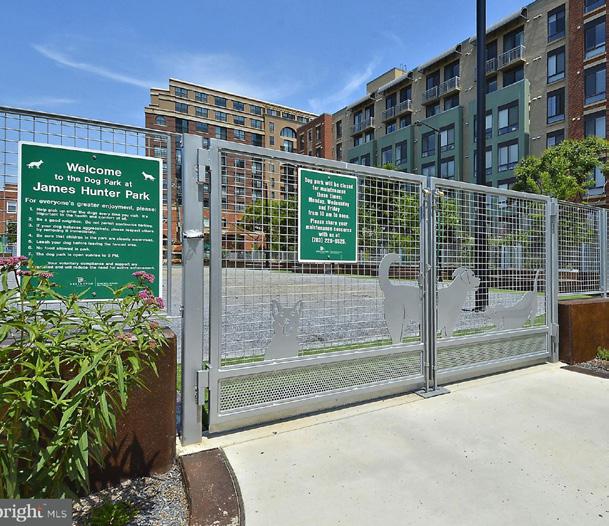

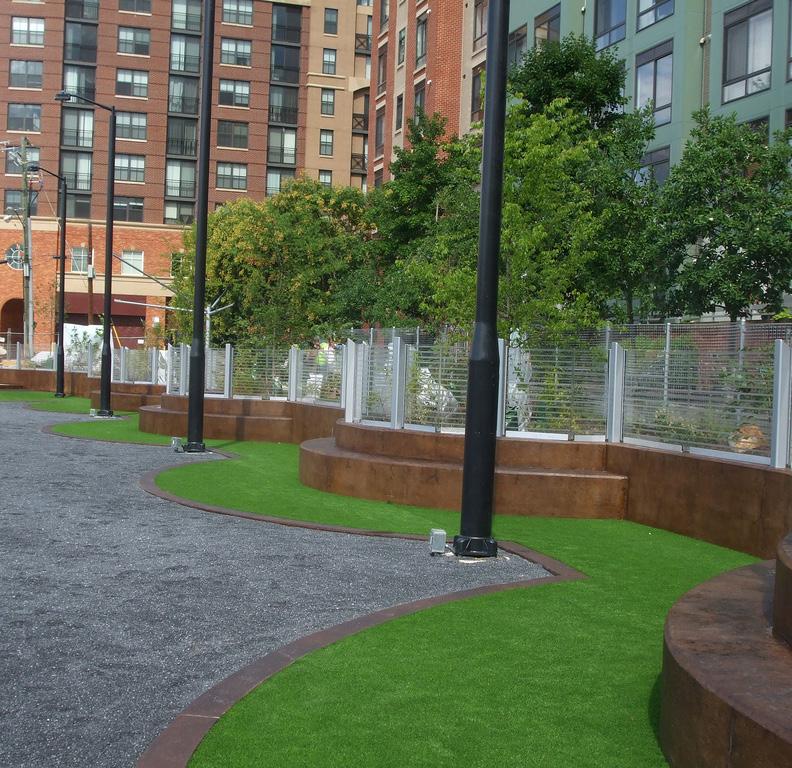

13th Street N.
17
Community access point from two streets
Paved, accessible walkways with grassy areas
Fence with vegetative screening between park & adjacent condominium building
Hartford Condominium Building
Sidewalk
N. Herndon St.
Sidewalk
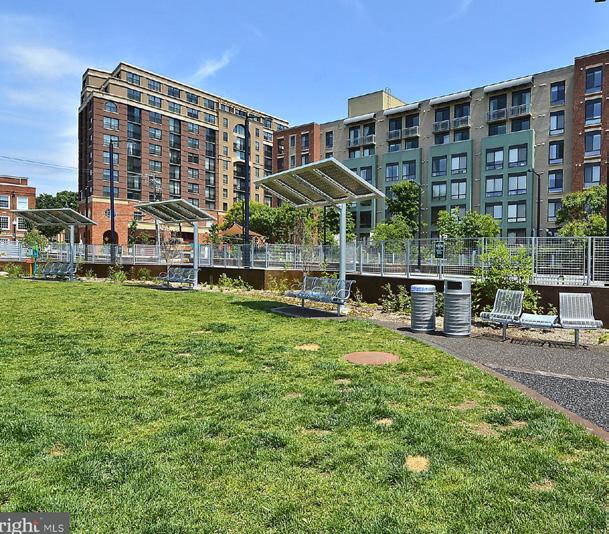


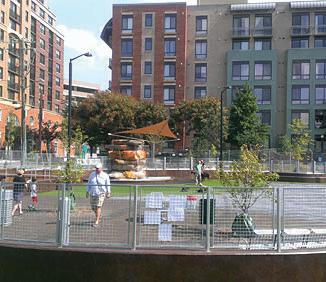
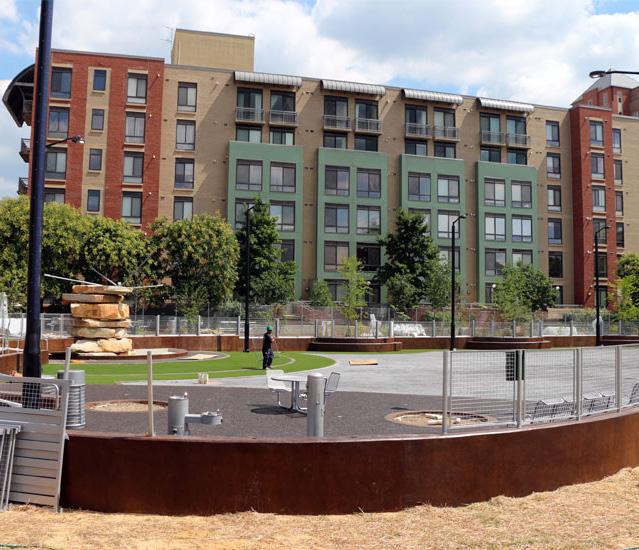
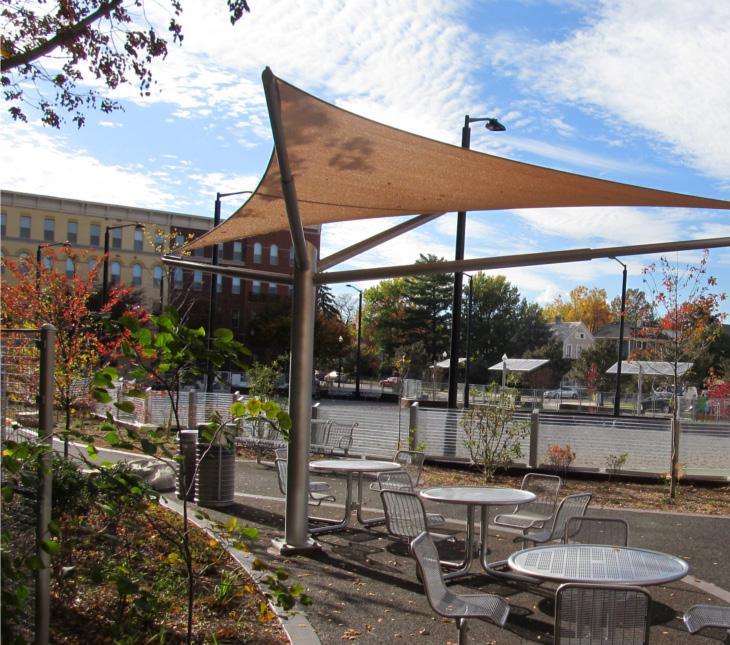
Water feature N. Hartford St.

of James Hunter Park.
18
Open lawn with benches
Woody, herbaceous native plantings
Picnic & game tables, shade structures
Raised walls and fences for dog park area designation
Expansive dog area with benches and water sources
Rendering and photos
Sidewalk
courtesy
Exercise & Agility Equipment
Dogs were made to move, run, and play, and they enjoy, and benefit from, training opportunities and learning new skills. Providing community dog parks can offer spaces for dog owners to help their dogs get the daily movement and activity they need to stay healthy and happy. They also serve as a great space to train and familiarize their dogs with the skills required to master playful obstacles or compete in the sport of agility, with equipment designed specifically for the rigorous daily use and exposure of a public space.
Besides offering the benefit of overall exercise, dog park equipment can help dogs build confidence, strengthen muscles, and build proficiency and ability in unique activities found exclusively at dog parks. Dog park equipment challenges a dog by incorporating quick movement, changes
in direction, elevation change, moving through unfamiliar spaces, jumping, and running, among other physical activities. It challenges them mentally as well as they learn to problem solve and master each obstacle. In addition, dog park equipment helps promote socialization skills, basic commands, and acceptable behavior patterns.
It also helps dog owners get regular exercise as they accompany their dogs through the course. Consider the following dog park equipment and materials for designing well-rounded activities and amenities to keep people and their dogs active physically, mentally, and socially. The equipment is designed to cater to a variety of dog sizes, specific skills, offer a variety of benefits, and create comfort and usability for people and their pets.
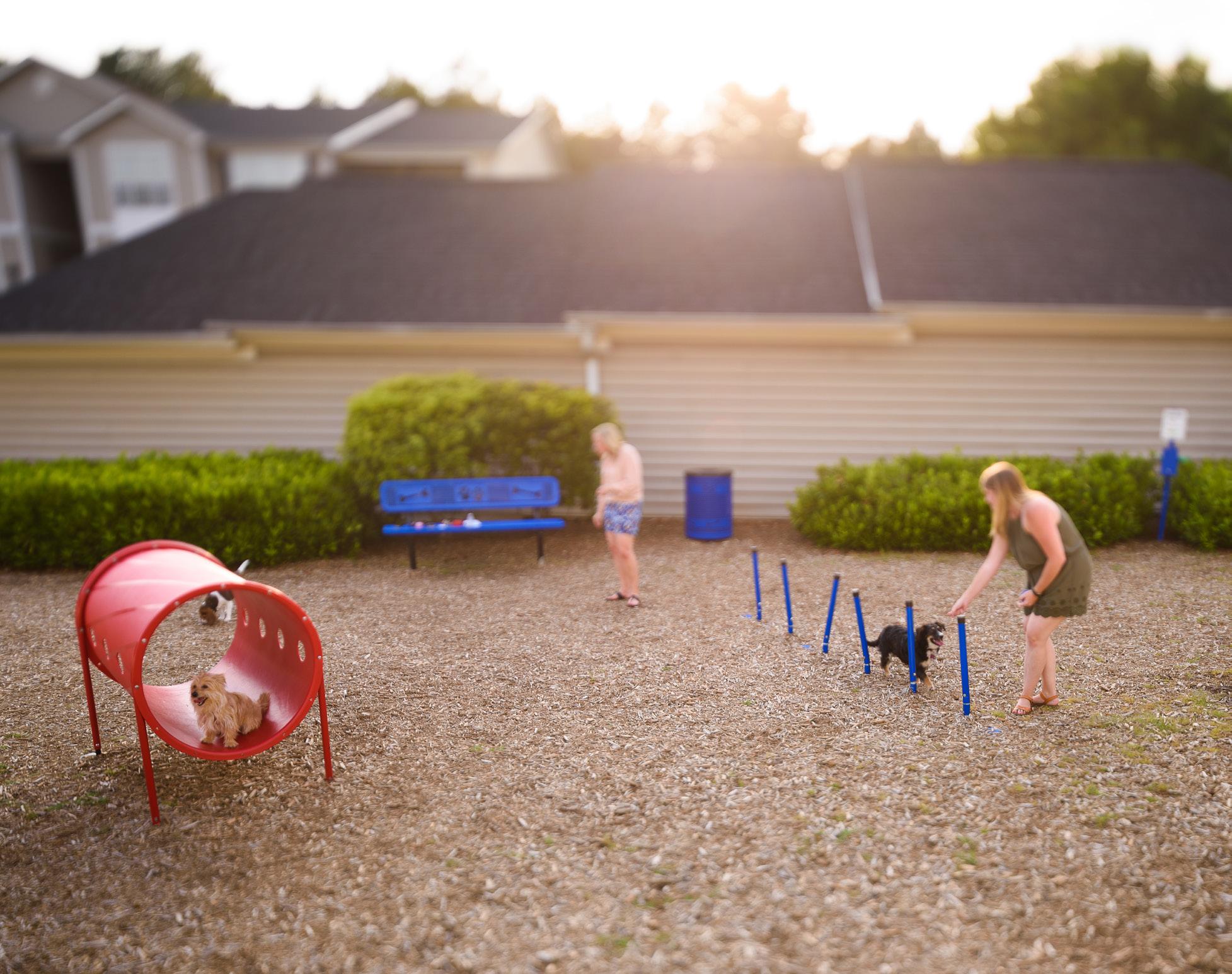
19
Dog Park Equipment Ideas

Hurdle
Suited for larger dogs, the hurdle promotes coordination and body position in space. It also promotes leg strength as dogs jump over the hurdle, avoiding contact with supports.
Solid Vented Tunnel
Tunnels are great for small to large sized dogs, as they build confidence in navigating closed spaces as the dog enters one end and exits the other. Vented holes help the tunnel stay cool, while providing dog owners a way to see their pet while standing to the side of the apparatus.
Ring
Similar to a tunnel but shorter distance, this apparatus helps small to medium dogs get comfortable jumping through a delineated space, and builds overall confidence.
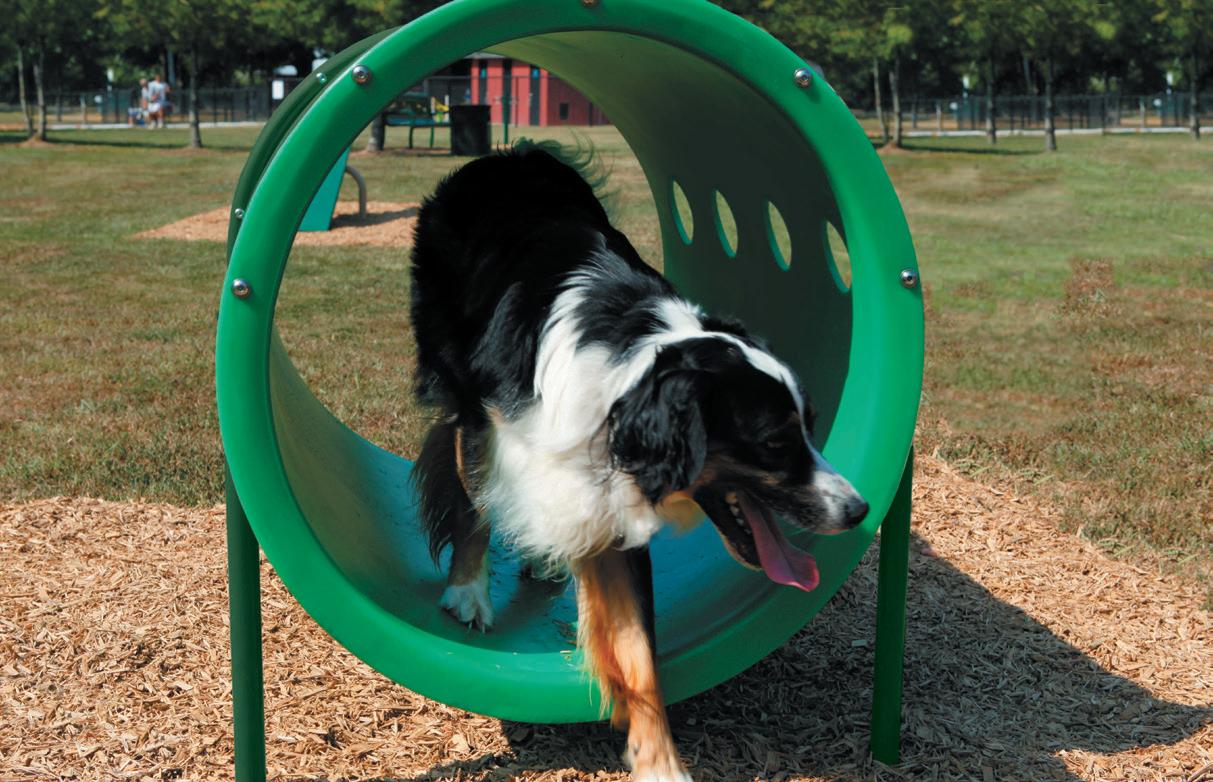
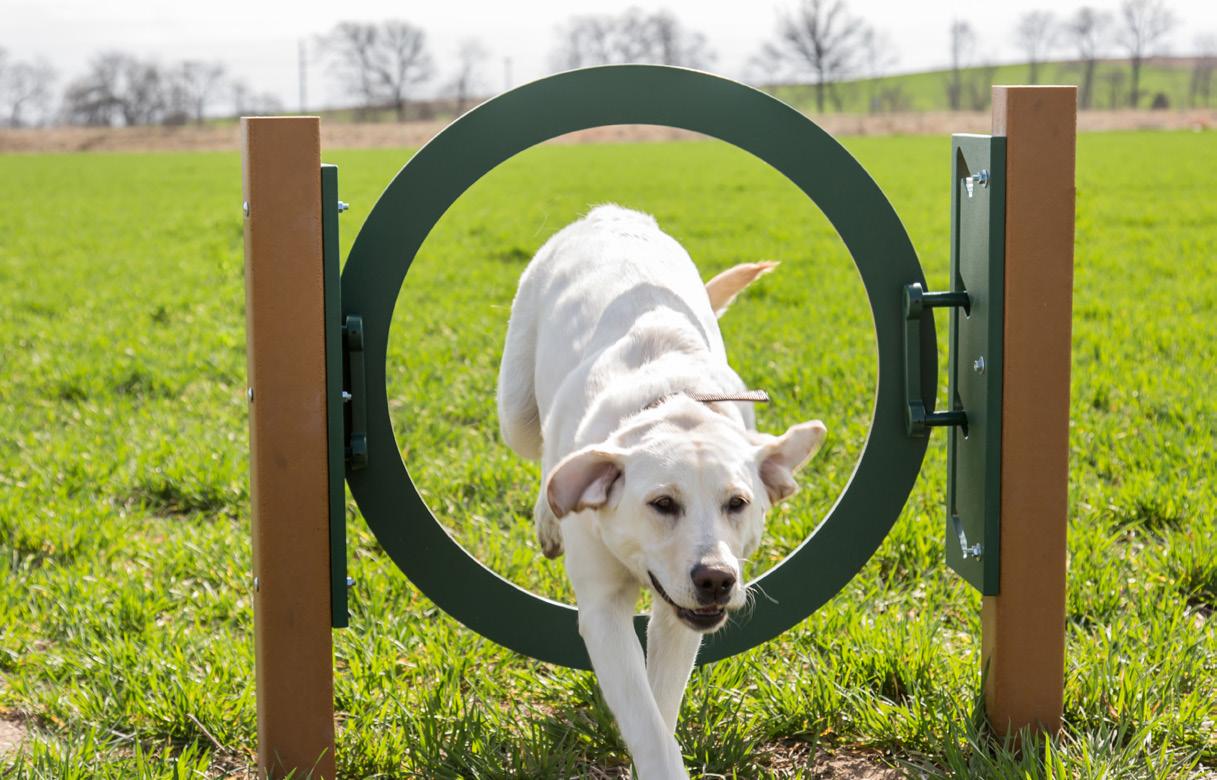
20
Jump
Generally a series of circles, jumps provide a way for dogs of all sizes to jump through the circle best suited to their size and comfort level. Like the Hurdle, they help advance coordination, body position in space, and leg strength.

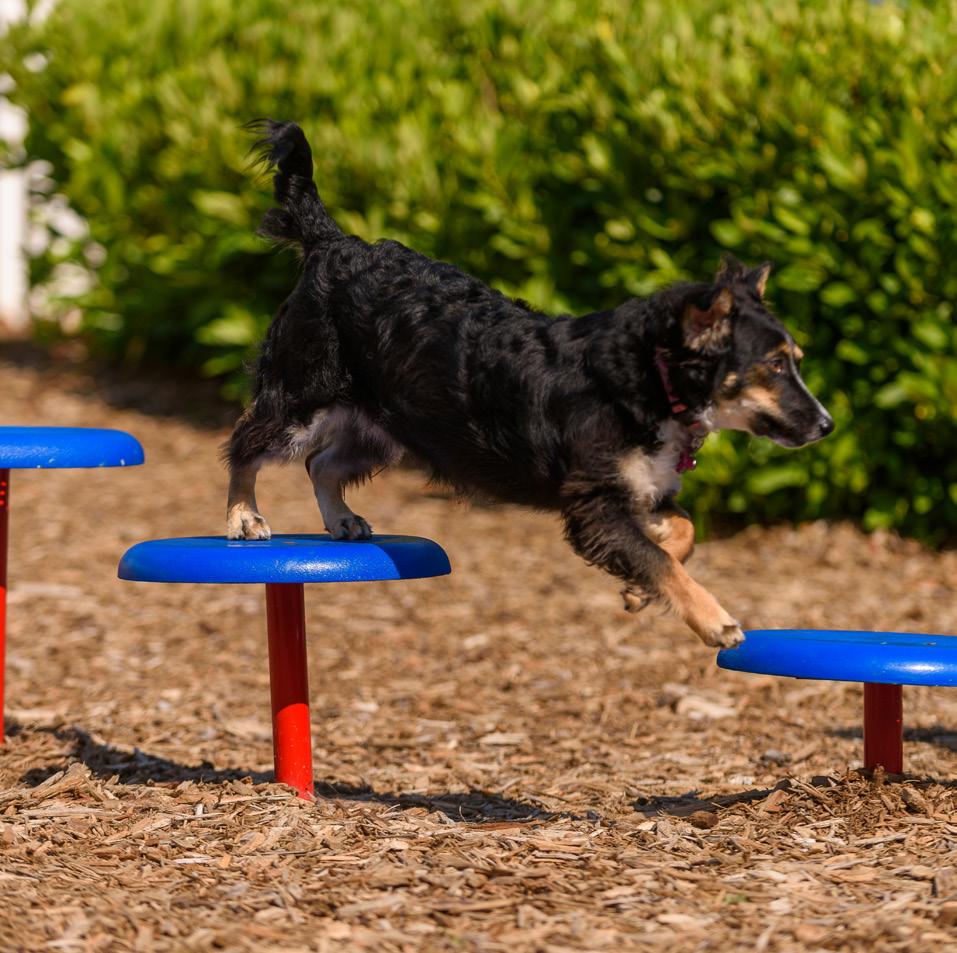
Platforms
Sold in sets, platforms are great for small or large dogs to promote jumping skills, confidence, coordination, and concentration as they jump from one platform to the next.
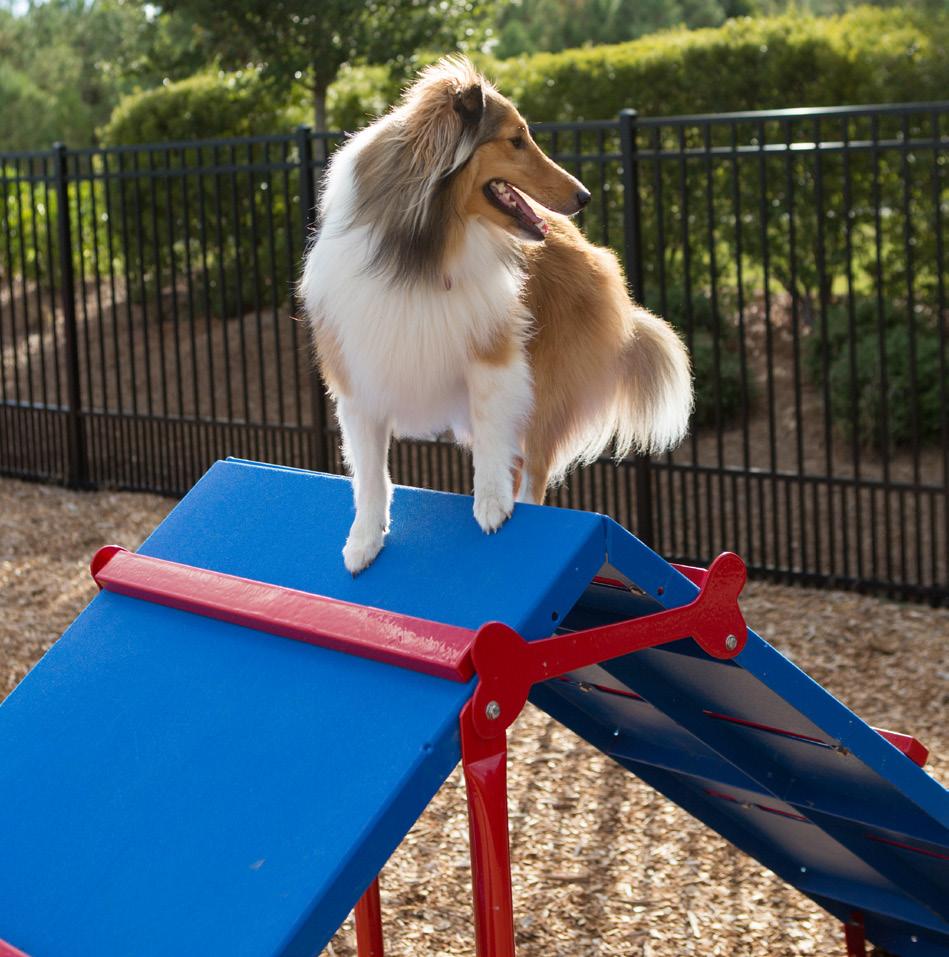

Suitable for all sized dogs, this apparatus encourages the animal to climb one side and descend the other, while maintaining contact with the equipment through the exercise. It develops control, and confidence with a variety of heights.
Best for larger dogs that are heavy enough to move the apparatus at its fulcrum, the teeter totter gives dogs confidence on moving equipment and promotes body control as they climb and descend as the surface changes position.
21
Teeter Totter
A-Frame
Weave Posts
Made for dogs of all sizes, weave posts are a fun way for them to develop speed, agility, balance, and coordination as they weave in and out of the poles. Additional poles can be ordered to create longer sets of weave posts.
Tables
Helps dogs of all sizes develop control, concentration, and patience as they sit and/or stay on the surface of the table for a prescribed period of time. Also a great place to rest when taking a break from the action.
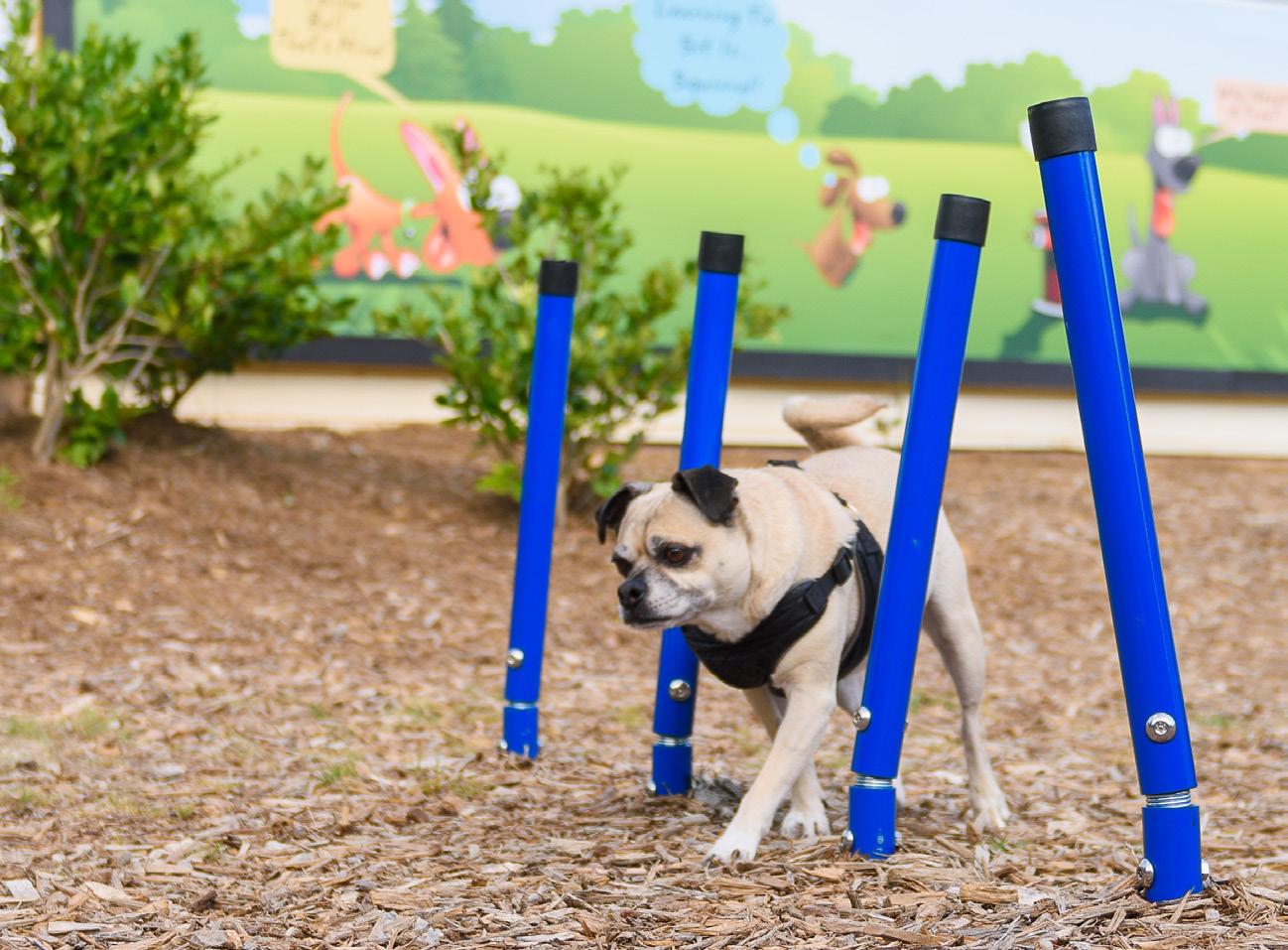
Bridge
Created for larger dogs to develop control, patience, and concentration as they go from end to end, maintaining contact with the apparatus.

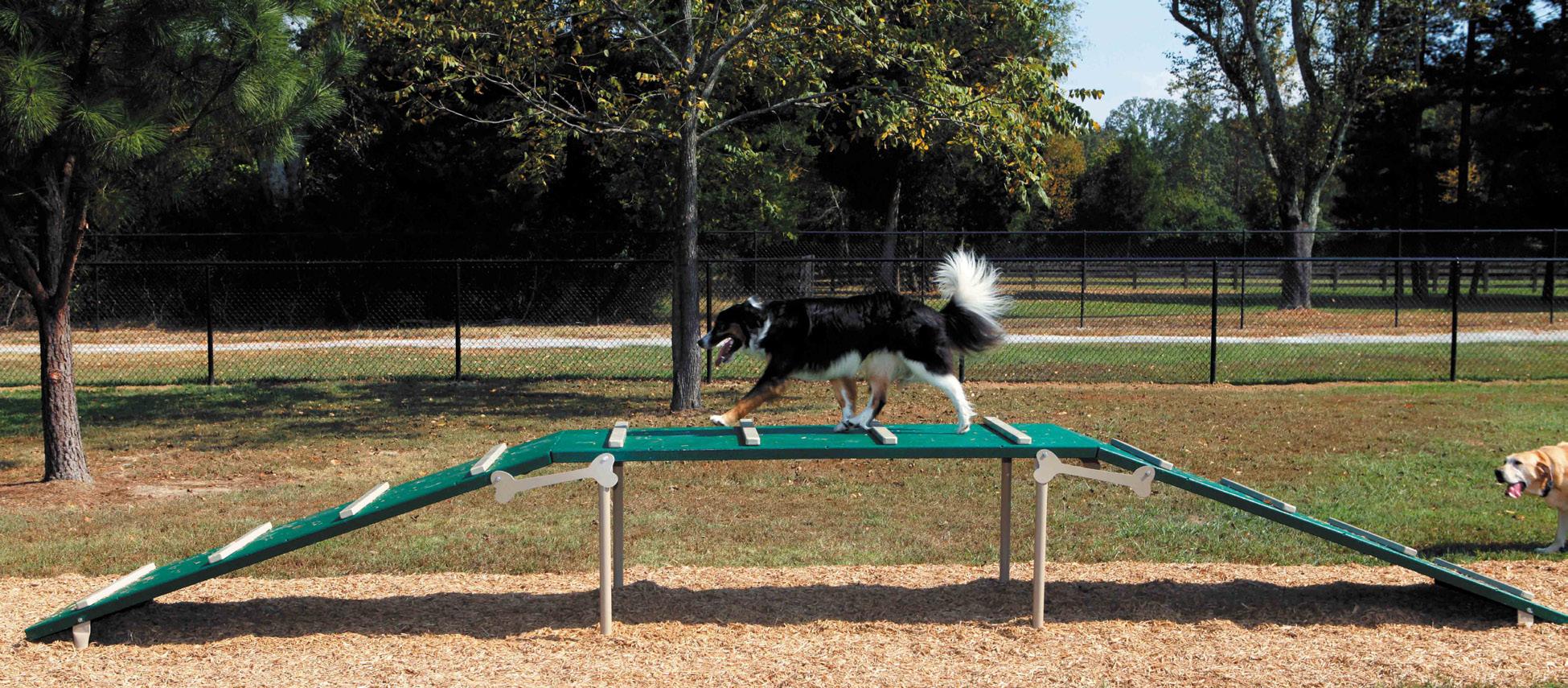
22
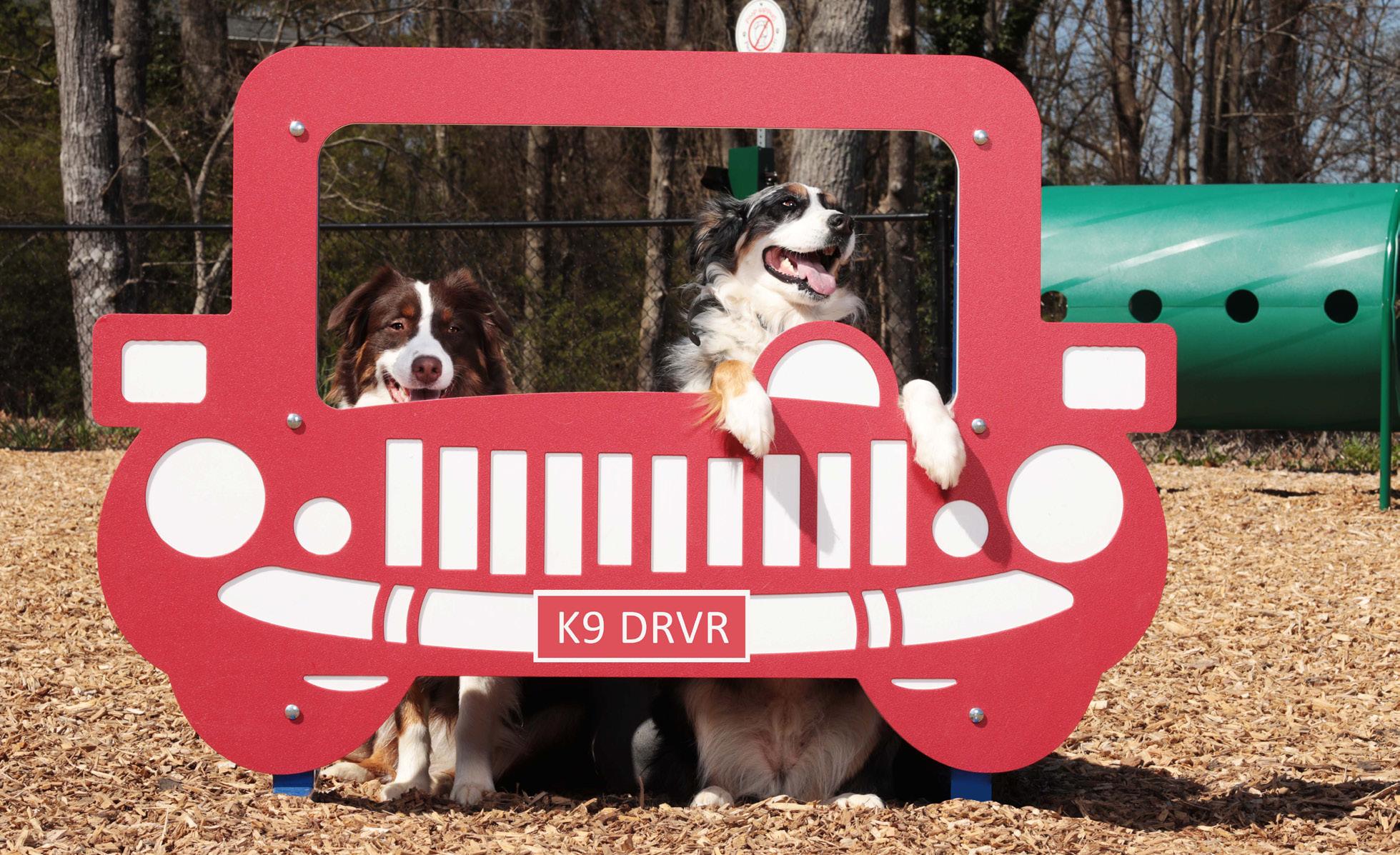
Including a photo booth provides the opportunity for “sit” and “stay” training. Also, owners can snap cute pictures of their pets and is a way to drive a social media presence through hashtags.
Mister
A great way to help dogs stay cool and comfortable while at the dog park, especially on warm days, or after an intense period of exercise. Multiple misters are often installed to ensure rapid cooling for multiple users.
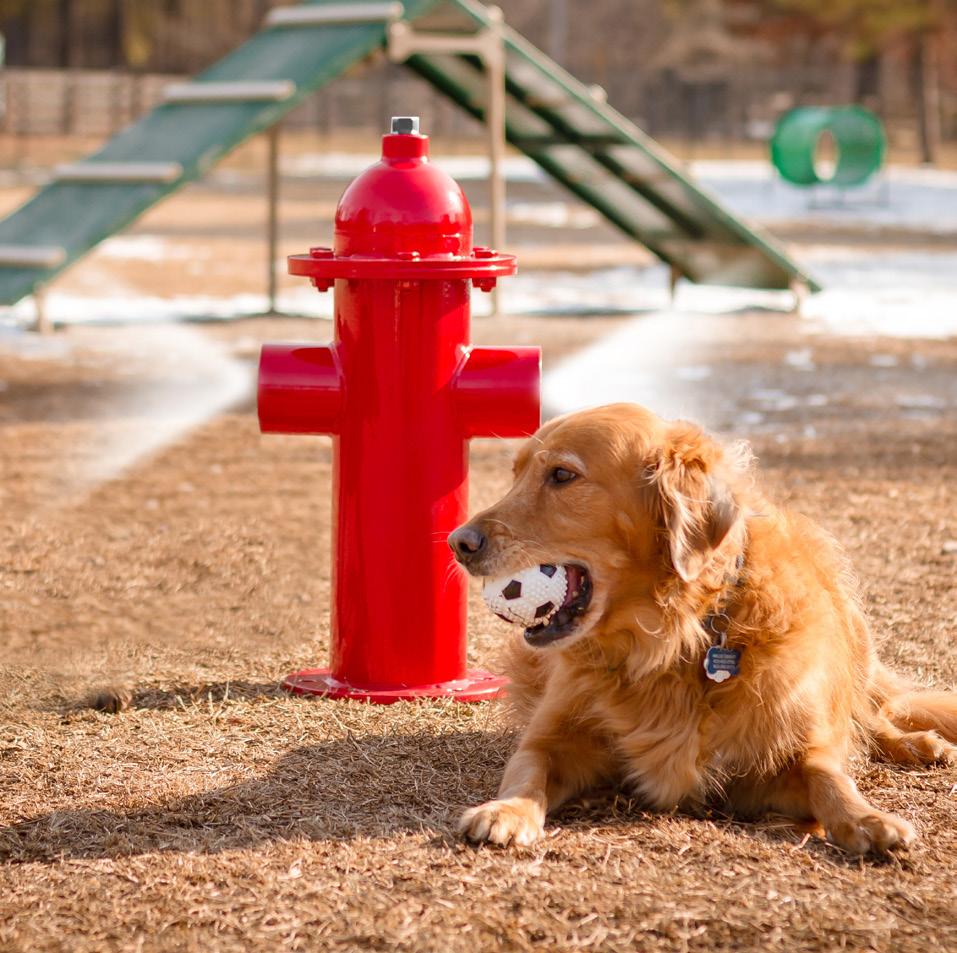
Grooming Table
This raised surface is designed to help owners groom their dogs without excessive or awkward bending. Grooming tables also help encourage the dog to remain still while being groomed.

23
Photo Booth Panel
Agility Standards
Agility courses designed for competition have a very specific set of dimensions depending on the competition program (championship or performance program) where community dog parks that offer agility equipment do not need to adhere to such extensive standards. However, the guidelines below may provide ideas for product assortments for your space.
USDAA Standards
The United States Dog Agility Association explains that agility courses “have prescribed standards in order to assure safety and basic uniformity in the nature of challenges within the sport. These agility obstacles are presented below, along with the minimum requirements for course design in USDAA’s standard agility classes.”
Three winged hurdles, one of which must be a spread hurdle (other additional hurdles primarily of a winged-type may be added to meet minimum obstacle standards for each class level listed below.)
Three contact obstacles, including the A-frame, see-saw, and dog walk
• Set of 10 to 12 weave poles
• One pipe tunnel
• One table
• One tire/hoop jump
The Kennel Club Standards
Number of obstacles per class:
• Starters, novice and veteran classes –14 to 16 obstacles
• Advanced and master classes –17 to 20 obstacles
• Master challenge classes –17 to 22 obstacles
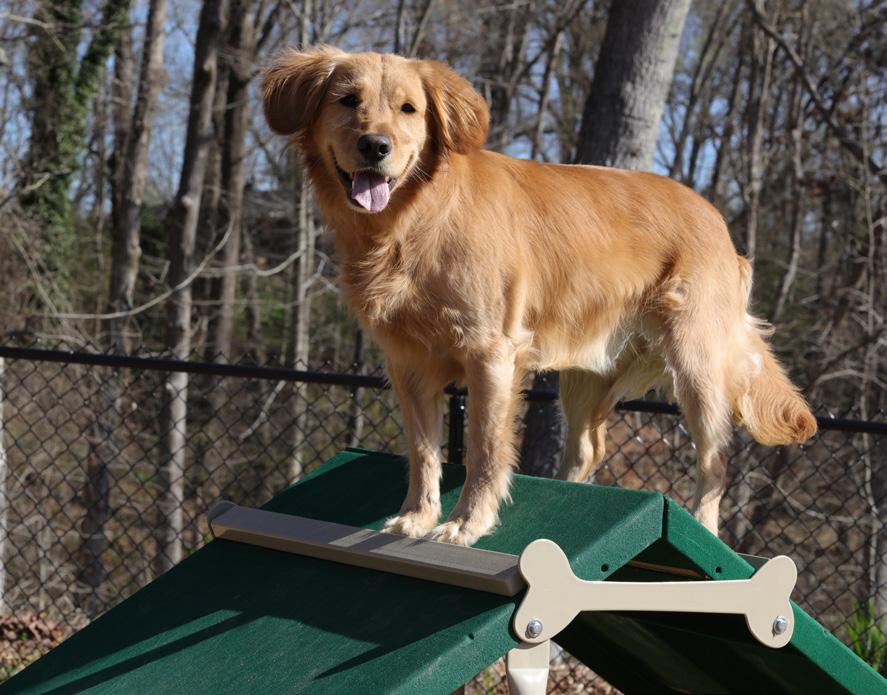
According to the Kennel Club of the UK, an agility competition will have a series of obstacles laid out in a large ring. The organization allows a combination of 15 different obstacles to be used in an agility course. The measurements of each of the pieces of equipment differ depending on the size of the dog – either small, medium, or large dogs. The 15 obstacles have very specific measurements that can be found in their webpage.
Hurdles
(maximum of 2 pieces placed together)
• Rising spread jump
• Brush fence
• Hoop
• Table and pause box
• Long jump
• Water jump
• Wishing well
• Pipe tunnel
• Weaving poles
Contact equipment
• A-frame
• See-saw
• Dog walk

24
Equipment Materials & Finishes
Dog park equipment is available in a variety of materials, to give site owners the option to choose the finish that is most appropriate. depending on the desired color, look, and functionality.
Thermoplastic Coating
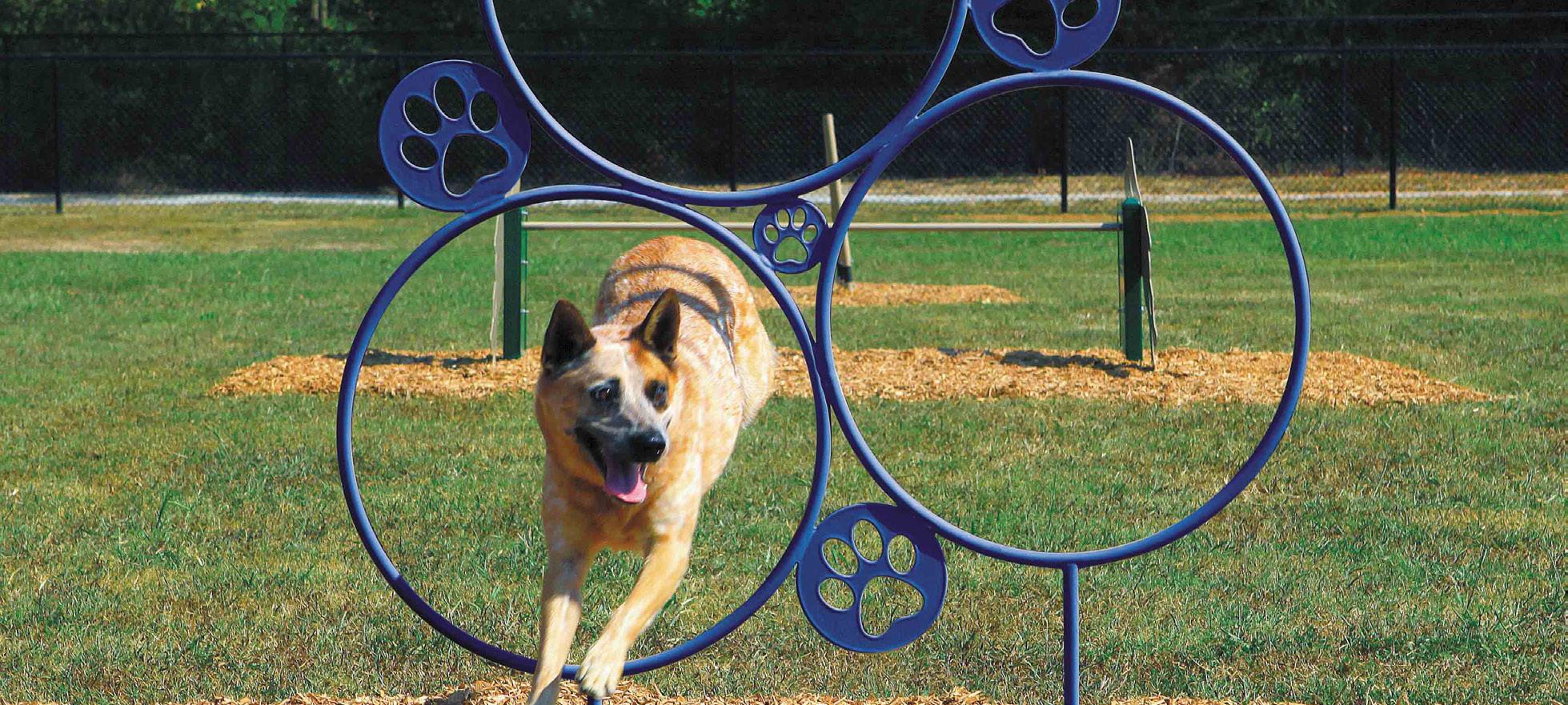
Thermoplastic finishes consist of an oven-fused, polyethylene copolymer-based thermoplastic coating. This coating should meet or exceed the AMA 2004-05 test specifications and provide superior adhesion, resistance to cutting and vandalism, and a smooth finish. It can also be easily repaired. This coating will protect the components from weather and urine that tends to discolor surfaces and other elements in a dog park.
Advanced Thermoplastic Coating
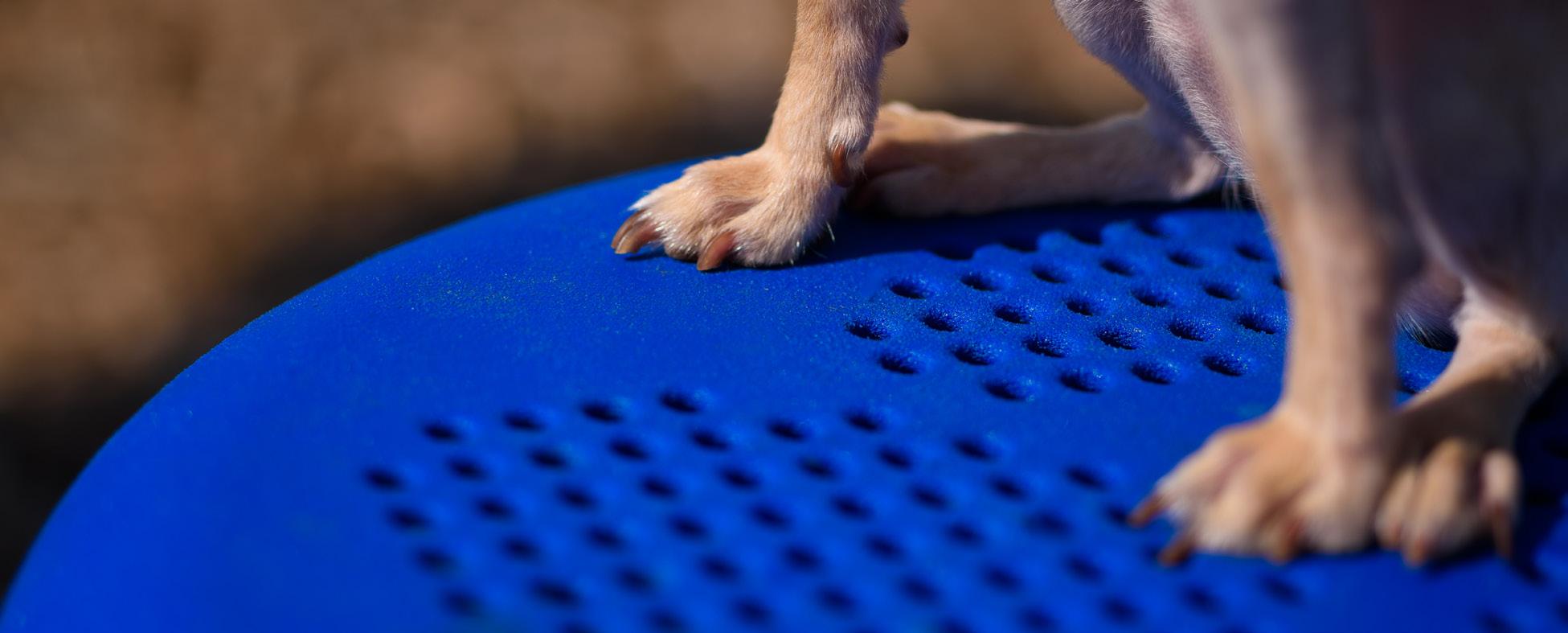
For those elements in the dog park where dog’s paws come into contact with surfaces, a more advanced thermoplastic coating may be suggested. This specially developed thermoplastic coating provides superior traction made specifically with dog’s paws in mind as the textured surface maintains comfortable temperature and is urine and slip-resistant.
25
Powder Coating
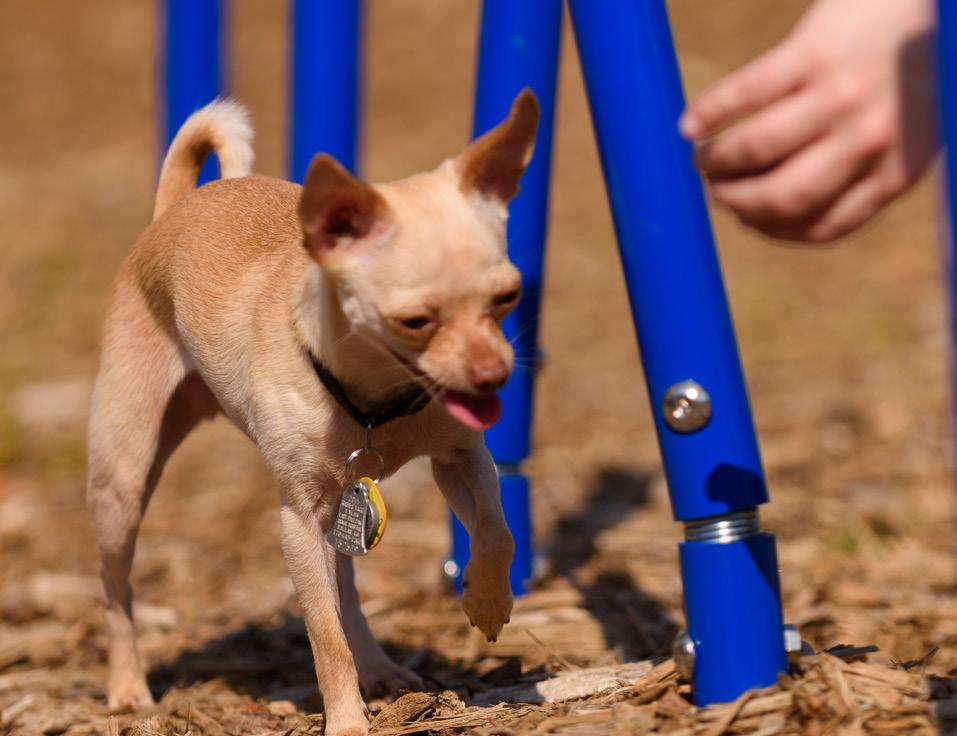
A powder-coated treatment consists of a superdurable three-layer resin system formulated to meet and exceed AAMA 2604 (American Architectural Manufacturers Association) test specifications. The powder coating process should include a zinc-rich epoxy primer, top coated with an electrostatic powder coating system that is oven-cured to ensure superior durability and a smooth, attractive finish. This allows for agility components to feel smooth and withstand weather-related conditions.
High-Density Polyethylene Resin (HDPE)

HDPE panels are precision cut from a single solid sheet of UV-stabilized extruded high-density polyethylene resin with colors molded in. All edges of the panels have radiuses and the corners are rounded for safe play.
Recycled Plastic

In addition to metal, there are materials that dog park equipment is constructed from to promote eco-friendly and natural looking choices. For a more natural aesthetic and for those that are ecoconscious, recycled plastic is a newer material made from 100% recycled plastic with a minimum of 96% post-consumer or post-industrial recycled plastic and up to 4% UV stabilizers and colorspecific agents to prevent fading and obtain desirable material properties.
Glass Fiber Reinforced Concrete (GFRC)
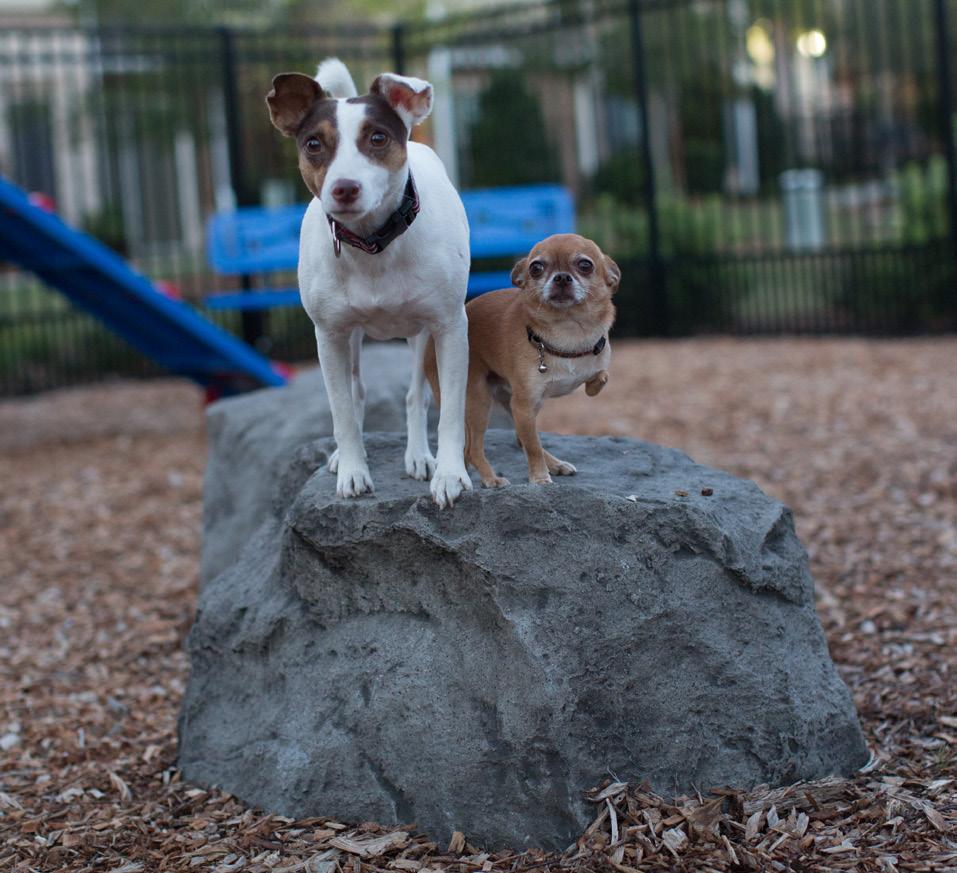
Other more natural elements for the dog park are those that resemble logs, tree stumps and even stones. These are made from Glass Fiber Reinforced Concrete (GFRC) to withstand the roughest of play.
26
Amenities & Accessories
There are a variety of site-specific amenities that should be considered to promote comfort, increase usability, and to support best practice design. While exercise and agility equipment are instrumental for increasing physical activity levels of both dog owners and their dogs, other amenities and accessories are also critical components of the overall design plan. Amenities can enhance the overall dog park design and be added at different phases of the project.
Signage and Message Boards
It is advisable to have permanent signage close to each of the entrances to a dog park stating the hours of operation, rules and regulations for the park, and contact information for the department that oversees the space. Messages should be clear and simple and symbols should be easy to recognize. You might also consider adding a message board to allow visitors to participate in the communication by posting public notices or reciprocal advertising information for dog-related businesses that promote your dog parks.
Dog Park Rules
Usually, these rules are developed by the park department or the affiliated dog park association involved in the oversight of the dog park. These groups are the ones that can enforce reasonable health and safety rules for the park. A successful and wellfunctioning park needs guidelines that are easy to understand and are located in a visible area to help communicate the expectations of dogs and their owners. The following rules and regulations are suggested by the American Kennel Club and the Humane Society of the United States:
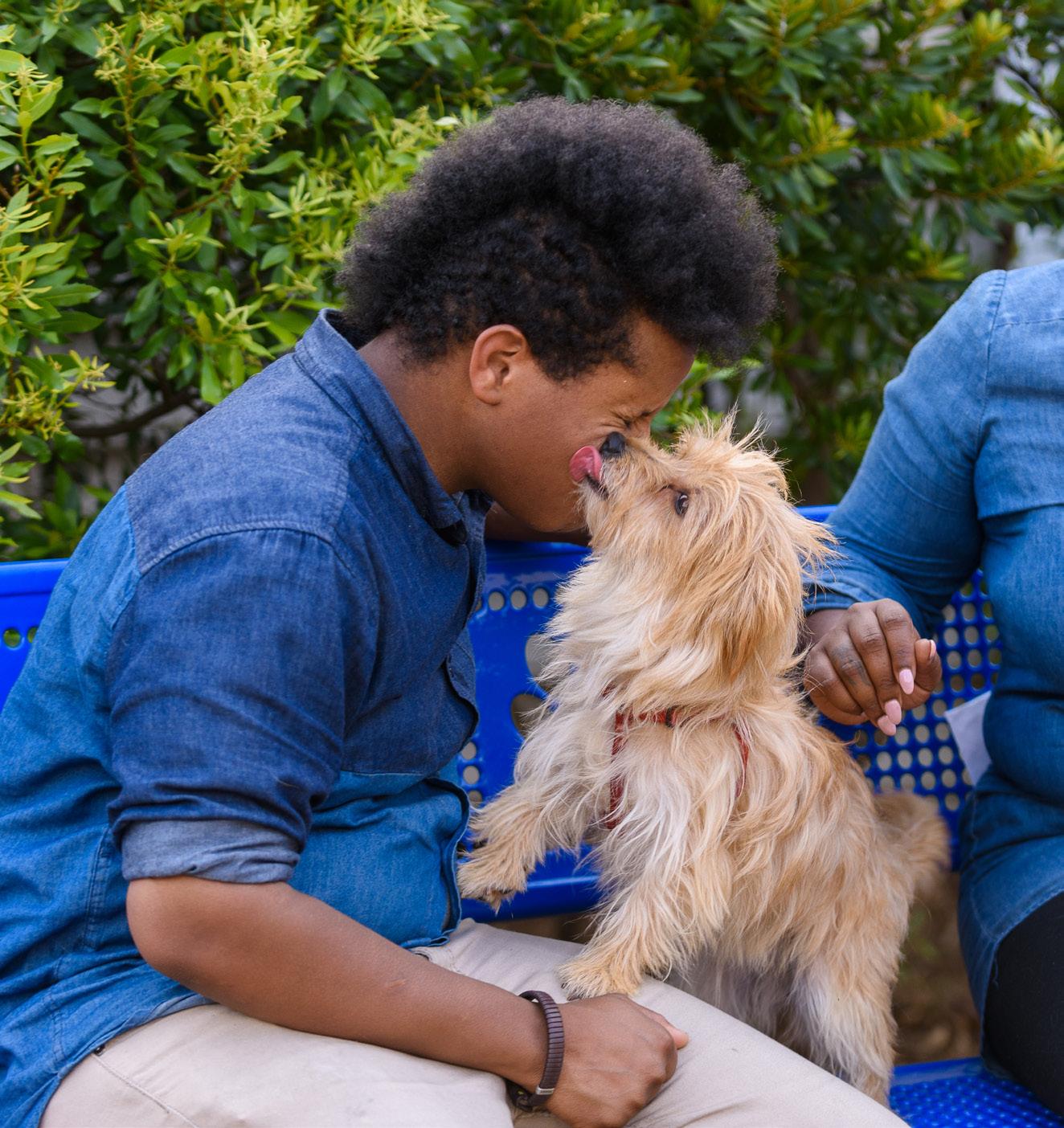

Dogs don’t rationalize. They don’t hold anything against a person. They don’t see the outside of a human but the inside of a human.”
—Cesar Millan (dog trainer)
Read more at http://dogtime.com/dog-health/general/1634425-famous-quotes-about-dogs#e1EUJPh557OXurwe.99”
“
Rules of the Dog Park
As suggested by the American Kennel Club and the Humane Society of the United States18,20
1. Owners are legally responsible for their dogs and any injuries caused by them.
2. Animals should wear a collar and ID tags at all times.
3. Dog waste must be cleaned up by owners.
4. Limit three dogs per visitor. It would be difficult for one adult to monitor more than three dogs.
5. Dogs showing aggression toward people or other animals will be removed from the park. Animals who exhibit a history of aggressive behavior will not be permitted to enter.
6. Puppies using the park must be at least four months old.
7. Owners should not leave their dogs unattended or allowed out of sight. If young children are permitted in the dog park, they too should be under constant supervision.
8. Dogs should be leashed before entering and prior to leaving the park.
9. Owners must carry a leash at all times. This enables the dog owner to remove a dog from the park for any inappropriate behavior. Dog owners must be in the park, within view, and be able to maintain voice control of their dogs at all times.
10. Small children should not be brought into the dog park. Small children can be harmed inadvertently by a playful dog. Chasing may be viewed as a threat to a dog, and running away from and high-pitched screaming may trigger hunting instincts in a dog.
11. Dogs in heat are prohibited from entering the dog park. The presence of a dog in heat may promote fights. This threatens the dogs as well as their owners who must break up the fights. Unwanted pregnancies may also result.
12. Fill any hole your dog digs. Dogs and people in the dog park may be injured if they step into a hole. Designated digging areas within the dog park may help preserve the landscape and train dogs to dig only in specified areas.
13. Do not bring food into the dog park. Fights may occur over food, and dogs may get sick if they eat foods that are not part of their usual diet.
14. Dogs must be properly inoculated, healthy, and parasite free. This protects all dogs and promotes responsible veterinary care.
15. Dogs must be licensed. This promotes rabies vaccination of dogs and their licensing as required by law.
16. Violators will be subject to removal from the park and suspension of park privileges.
28

Gates
All gates should be fitted with a spring for self-closing, particularly for visitors or children who may forget to close the gates. These types of systems decrease the likelihood of dogs escaping. Gates could include a swipe entry or a double gate entry for additional security. Swipe entry systems are convenient as they regulate the access to the dog park and can improve park security. Also, for improved access, consider installing the gate with sufficient clear space for those individuals using mobility devices.

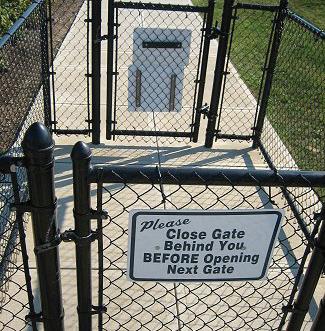
Electronic Access
In addition, a separate gate for exiting can improve some of the crowding that may occur while others are entering the dog park, reducing stress in both individuals and dogs. Keep water bowls, waste disposal, and benches away from gates to reduce overcrowding at entry and exit points. Lastly, when thinking about small versus large dogs, placing gates away from each other for separate sized dogs rather than at corners is recommended as it may decrease the amount of barking and the potential for aggressive behavior.
Several companies provide programmed keys that can be issued for membership-based dog parks. The keys can be deprogrammed if not returned upon expiration of the membership. These systems are preferable to allow access to city- or countywide parks. The annual dues individuals pay for their membership (commonly between $30 to $100) can help raise money for park maintenance and fund future parks and recreation systems. Besides providing security to patrons, electronic access can offer additional benefits such as recording a log of park users, preventing loitering, discouraging irresponsible owners, and protecting park equipment. Electronic access has more recently been found in other settings such as housing complexes and corporate settings to keep the general public from using the space without authorization.
29


Seating
Provide seating options throughout the park in sunny and shaded areas to increase comfort. Seating should not be placed up against fences, as dogs may use it to jump over the fence, or near entrances to avoid crowding. In terms of materials, there is a wide variety including, thermoplastic or powder coated metal and recycled plastic lumber. In addition, be mindful of the design/surface; it should be incapable of allowing a dog’s appendage to get stuck in a narrow opening or slot. Some parks also use seating as a way to bring personality and branding to the space.
Leash Posts
Leash posts can be provided next to gates or adjacent to benches and tables in order to provide a place to hang a leash or park a dog for short periods of time. When selecting a leash post, look for a high-quality steel framed post which will increase durability and continue to be a convenient asset. If using a leash post to park your dog, be sure you
are aware of the temperament of any dogs already parked there. In addition, some off-leash dog park regulations state that owners should carry their dog leash with them while in the park.
Watering and Cooling
Exercising dogs need access to water, and their owners will appreciate it too. Consider providing dog-level drinking fountains alongside humanlevel ones to provide refreshment and hydration. If this is not a possibility, a posted message should alert dog park users to bring their own water.
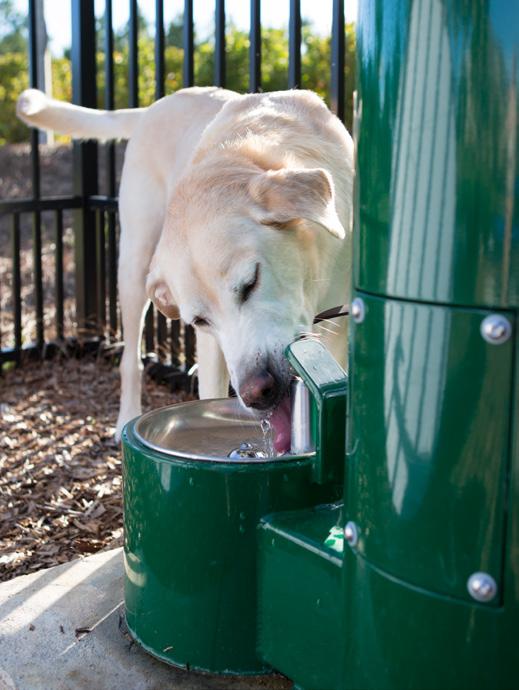
Washing areas may be helpful to reduce heat during the hot seasons, administer first aid, and clean mud from pets. These areas need appropriate drainage and ground cover (e.g., concrete). Some dog parks offer ponds where dogs can swim. These ponds may be fenced in to restrict access and to deter dogs from jumping in without their owner’s permission. In addition, misting features can provide a refreshing experience especially in areas of high heat.
30
Seating areas provide a meeting place for dog owners and their dogs.
Leash posts can be used to help dog owners keep leashes organized and tangle-free.
Shade and Shelter
Shade, whether natural or built, is an important consideration for both dogs and dog owners at the dog park. Trees, which absorb surface moisture by their roots and are aesthetically appealing, may be one solution. Shade structures such as gazebos, shelters, and shade canopies are also good options. Offering a variety of natural and built shade elements helps increase overall comfort as well as seasonal appeal.
Waste Stations and Trash Receptacles
Covered waste stations should be placed at various locations throughout the park and at entrances/exits to provide easy access to individuals for cleanup. Consider incorporating a hand sanitizer station into the design. Offering waste stations will encourage dog owners to clean up after their pets. Providing waste bag dispensers and waste scoopers will also help improve the cleanliness of the area. It is also recommended to have two to three trash cans in common areas and one outside the entrance gate.
Bike Parking and Storage
Access to your dog park is an important consideration and offering well laid out routes for walkers and cyclists can increase usage of the dog park. To help promote connectivity, consider installing bike racks for individuals that prefer to bike to the park. Some communities become very creative by installing bike racks and other amenities with animal or nature themes (e.g., bone-themed elements or a customized rack with the name of the park) to add aesthetic appeal to the overall design of the area.
Parking
Providing adequate parking for the dog park is a critical consideration, as most users (95%) drive to them.22 In addition, locating the off-leash area as close to the parking lot as possible helps promote accessibility and discourage owners from letting their dogs off-leash between the dog park and parking. The parking area could also be used as a buffer between the dog park and adjoining neighbors to minimize noise if that is a concern. Ensure all parking meets ADA accessibility standards.
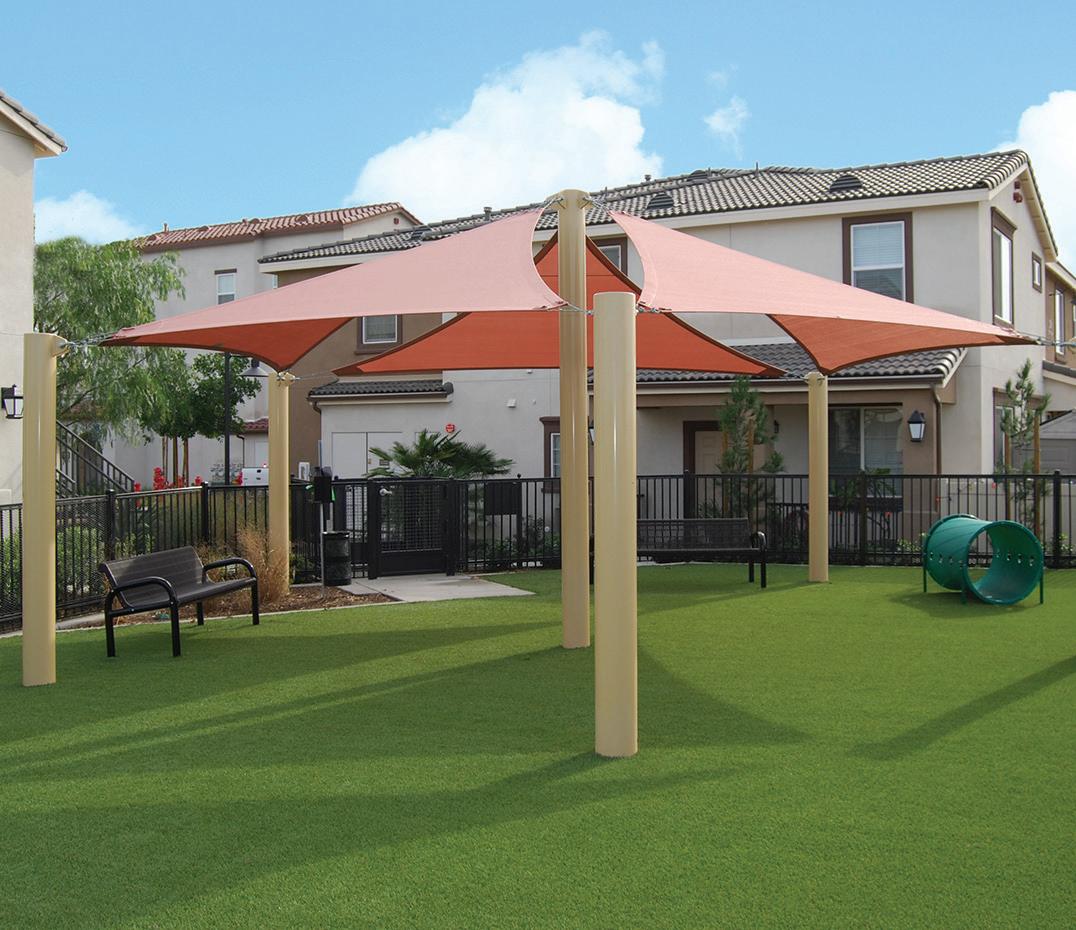


31
As per the U.S. Department of Justice22, an accessible parking space must have space for the vehicle and adjacent space to either the right or left of the space to serve as an access aisle, so a person in a mobility device, scooter, or other device has clear space to get out of their vehicle comfortably. These spaces should be located closest to the accessible entrance and at ground level. In addition, an accessible route must be provided between the parking space and the dog park. This route should be firm, stable, and slipresistant, with no steps or steep slopes.
Trails and Pathways
Trails may be offered to incorporate interesting routes of travel to and throughout the dog park. Ensure the trail path can be used by all by following these inclusive guidelines: Trail widths are 36” with occasional segments at 32” to accommodate existing trees and permanent features, surfaces are stable and firm, and obstacles, surface gaps, protruding objects, and other obstructing details are minimal. Accessible trails are generally barrier free, and have slopes well under 9%. In addition to providing access and optimizing flow, trails and pathways can be important design elements for increasing physical activity for pets and their owners.


Restrooms
If possible, it is ideal for ADA compliant bathrooms to be located at a reasonable distance from the park. A portable toilet could also be acceptable if a permanent facility is not an option, however, these should also be ADA compliant. Visitors to the dog park may appreciate knowing that there are bathrooms available for them if needed, and it may also increase visit time and frequency. A leash post outside the restroom is a great idea to help dog owners use the facilities.
Lighting
To increase visibility and safety (e.g., during the winter months) automatic or timed lighting can help extend the hours of use. Contact a specialist in outdoor lighting that can help design the best lighting solution to the dog park environment to avoid spilling lighting to adjacent neighborhoods. Solar powered and LED lighting have become popular features in dog parks as they are efficient and environmentally friendly.

32
Fencing
Some off-leash areas may be completely fenced; however, larger areas may be unfenced. Dog parks are becoming more strategic on how they use fencing in terms of park operations. In parks with high use, fencing is usually preferred. When deciding on the placement of fencing, be aware that 90 degree angles can cause dogs to corner one another, become aggressive, and make it easier to escape. To prevent potential issues, strategic placements of shrubs or planters can be used, but not avoid benches as they can be used also be as an escape hazard.Be sure to take the surroundings into account when selecting fencing materials and design.
Fence Material Considerations
Woven wire is easy to install and inexpensive. A concrete ledge can be poured under the frame to prevent the dogs from digging.
Stainless steel fencing offers strength and durability, especially in heavily used dog parks.
Interlocking wall stone can be augmented with 2-foot high stainless steel fencing attached to the top of the wall for security and aesthetics.
Chain link fencing is easy to install, inexpensive, and durable. Consider dressing it with landscaping for better visual appeal.
Hedges are attractive, but require more depth than traditional fences.
Pickets can be alternated front and back of support to create more open space. Engraved pickets can be sold as fundraisers for the dog park.
Solid Fencing like concrete or corrugated material may not be a good option as sight lines become minimized, and dogs can become nervous or roused if they feel enclosed. Windows or portals can also be installed to provide viewing areas.
Landscaping may be used to increase privacy while not completely obstructing the view. Berms or platforms can be installed if the dog
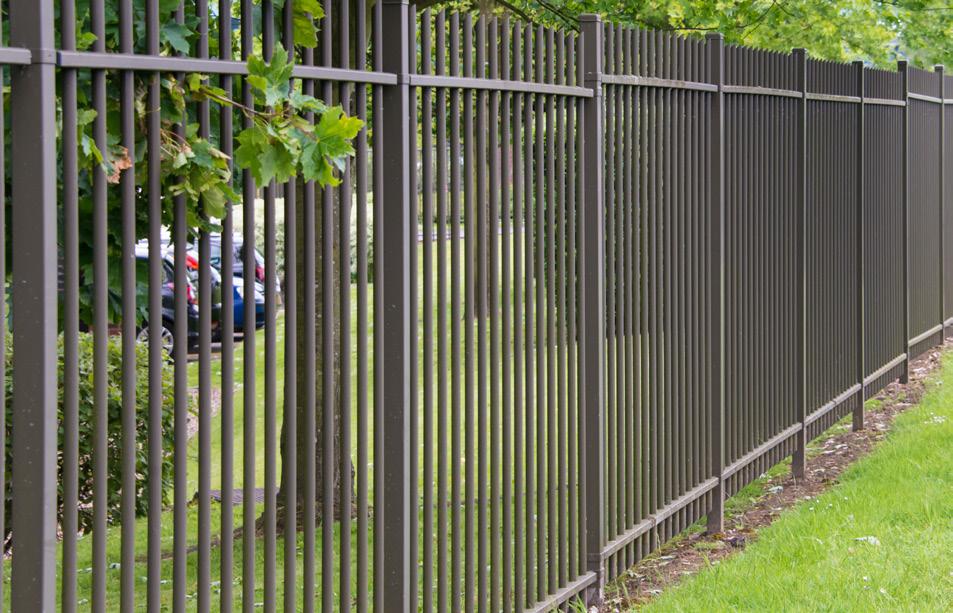
park has a solid fence, so the dog can see over the top of the fence, but not be close enough to jump over.
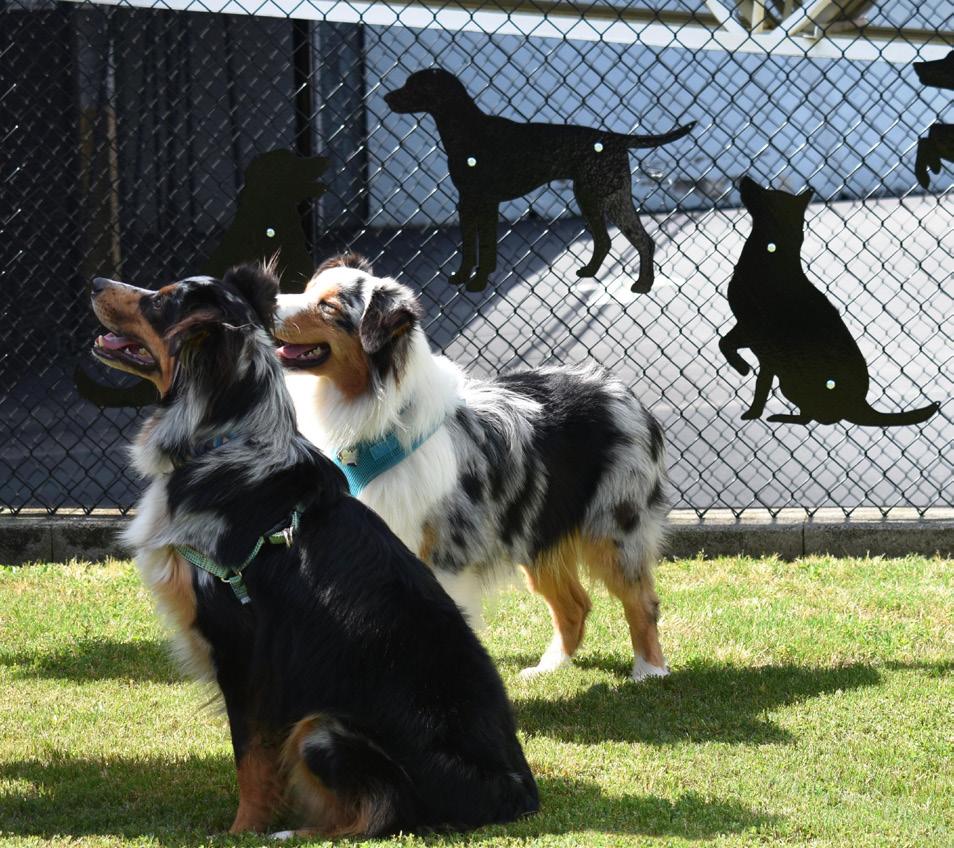
Fence Height
4-5-foot high fencing – will contain most dogs
7-foot high fencing – can help prevent dogs from escaping, especially recommended for larger dog areas. Also suggested if the dog park is near a residential area or adjacent to busy roads.

33
Timber Slats Vertical Steel Rods
Dog Park Equipment Ideas
Equipment Users* Task Benefits
ACTIVITY
Hurdle
Solid vented tunnel
Jump
Set of platforms
A-frame
Teeter totter
Weave posts
Bridge
Tables
AMENITY
Mister
Grooming table
Waste stations and trash receptacles
Leash post
Watering and cooling
Welcome sign
Bench
Jump over the hurdle, avoiding contact with supports Coordination, body position while feet are off ground, leg strength
Enter one end exit the other Build confidence, navigate enclosed spaces
Jump through opening Advanced coordination, body position while feet are off ground, leg strength
Step or jump between platforms of varying height Jumping skill, coordination, concentration
Climb and descend while maintaining contact with equipment Control, confidence with varying height
Climb and descend as surface changes position Confidence on moving apparatus, body position control
Weave in and out through set of poles Speed, balance, coordination
Go from end to end, maintaining contact with obstacle Control, concentration, patience
Sit or stay on top of the table for a prescribed period of time Control, concentration, patience
Cooling off Comfort
Grooming Raised surface promotes comfort for owner and dog
Pick up/dispose waste, keep park clean Hygiene, cleanliness
Hang leashes while dogs are off leash Organization, visual cueing
Hydration Comfort
Promote rules, hours, instructions Clear expectations are expressed
Sit while dogs are at play
Comfort, socialization
Shade Keep users cool Comfort
34
and
Increase hours of use Visibility and safety
Parking For cars
bikes Access Lighting
Remember to consider surfacing, fencing, access, and restrooms in the overall plan. * People Large Dogs Small Dogs
Drainage & Surfacing Materials
Adequate drainage throughout the park is extremely important, especially near special features like water fountains and rinse stations. Good drainage will help prevent accumulation of water, mud, and urine which can stress ground cover. In addition, selecting an appropriate surfacing material will help increase the enjoyment and longevity of the dog park.
Surfacing materials are classified as unitary surfacing or loose-fill. Unitary surfaces include turf, special turf for dog parks, grass, and kennel tiles. Unitary surfacing does not require raking, compaction, or replenishment; however, it requires sanitization and maintenance due to surface debris, vandalism, movement in the tiles, erosion, poor drainage, or worn areas that result from repeated impact. Loose-fill materials include mulch or wood chips, decomposed granite, rock or gravel, shredded rubber, and sand. They require ongoing raking and replenishment to keep the materials in place.
Below is a summary of some surfacing types that may be appropriate for use in dog parks. While the surface is undoubtedly important and correlates with park success, this is often a difficult topic for which to make specific recommendations. It is important to choose an appropriate surface for the location, usage pattern, and resources available for adequate maintenance.23
Turf
Turf, unlike grass, does not need mowing, can handle repeated traffic, and does not discolor from urine. To be suitable for a dog park, the turf should be permeable to allow for drainage, and be installed over a base that also drains well. Shorter pile is more desirable so that dog waste can be more easily seen and removed. Turf that does not require infill is also more desirable, so that it can be vacuumed or raked to remove hair, as this debris can reduce the drainage capacity.
Special Turf for Dog Parks
Some manufacturers have developed turf specifically designed for the unique needs of dog parks. Dog park turf is made of a blended monofilament that is tufted and textured to create a dynamic turf with less matting than other systems. The warp knit primary backing is coated with a special agent that provides extra strength against wear from dog’s paws and claws.
In addition, this more specific type of turf includes a special infill that helps prevent bacteria from spreading. It was designed to be safer to the environment, humans, and dogs alike. This material is optimal when designing for a more natural aesthetic. It is easy to clean as unwanted odors can be flushed away with water or specialized cleaner and it does not require the use of chemicals, fertilizers, or insecticides to maintain the natural look and feel.
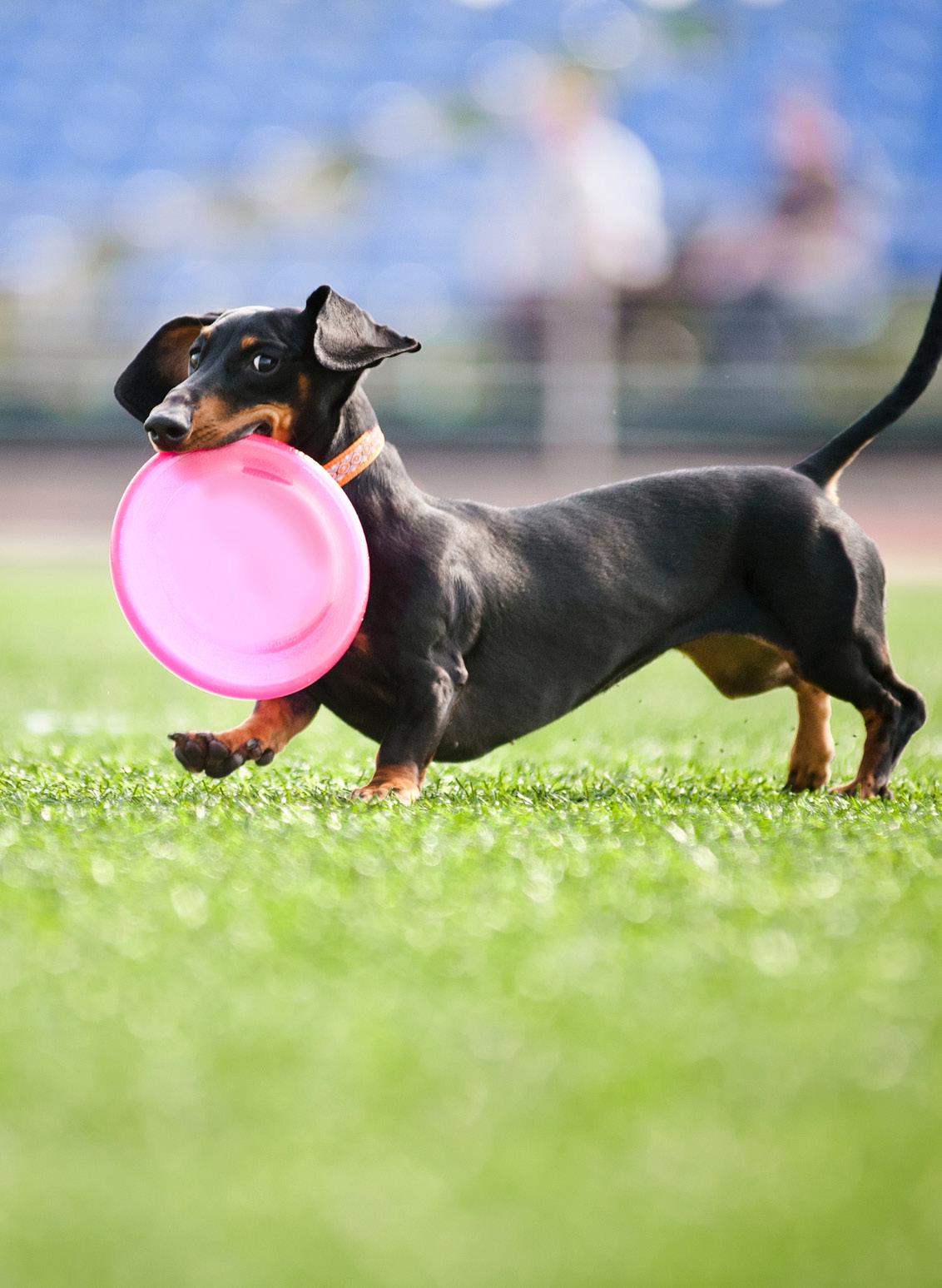
35
Grass
Grass surfaces are soft underfoot, are visually appealing, and can adapt to any terrain. It is important to consider an irrigation system where grass is used, and it will require periodic reseeding in heavy traffic areas and in spots damaged by repeated urination. If allowed to grow tall, it is difficult to identify and pick up dog waste, so regular mowing is critical.
Kennel Tiles
Kennel tiles can be an excellent choice to use as a dog run liner or in surrounding areas where the surface may be overused. The interlocking system provides the flexibility to configure them as needed to fit the space and the tiles have been designed to provide cushion to dogs’ paws. It keeps urine and dog waste from direct contact with their feet as the tiles are raised off the ground and waste falls through the openings of the tiles. Tiles can be easily maintained by spraying with a hose to remove debris.
Mulch/Woodchips
This substrate is easily maintained and usually inexpensive, especially since park departments may have access to free mulch resources. It needs to be replenished periodically due to decomposition, but does afford adequate drainage. Care should be taken when selecting mulch so that dogs do not get splinters. Playground mulch (engineered wood fiber) will


knit together, and may be used on gentle slopes. Since mulch will absorb urine, and may harbor bacteria and fungus that may be harmful to pets, it is best used in limited areas. Also, since they are similar in color, it may be difficult to detect dog waste on mulch.
Decomposed Granite (DG)
DG surfacing has fine consistency, is more sterile, and it is often used to create paths or in areas of heavy activity (e.g., entryways). It may need to be hosed down to prevent dust. It is important to install on a flat surface, as it can migrate downhill. Proper drainage is a must, otherwise fine particles will clog drains and potentially cause flooding. Decomposed granite will not absorb moisture, and does not retain the smell of urine.

36
Heavily Compacted Base Rock or Gravel
Rock or gravel may be an adequate surface for the dog park, but precautions should be taken. Since rock absorbs heat in direct sunlight, it may become hot for the pads on dog paws and the rough texture may cause abrasions. The main benefits of gravel and rock is that they are very low maintenance, they do not absorb odor, and dog waste is more easily detected and removed from this substrate.
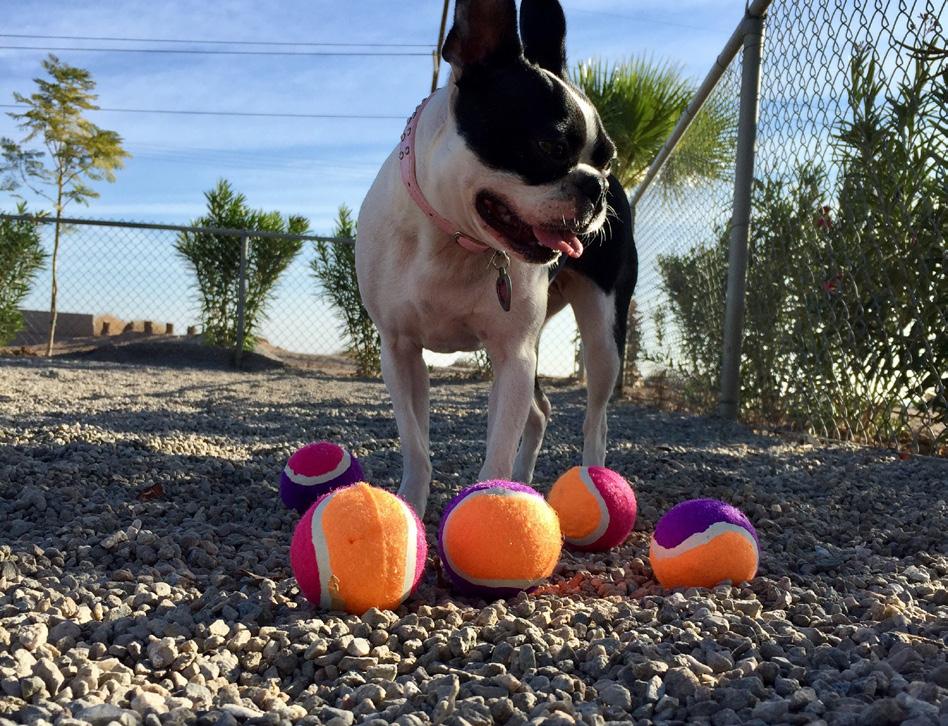
Shredded Rubber
Made out of recycled rubber tires, shredded rubber offers a green option for dog parks. The U.S. Environmental Protection Agency (EPA) found that shredded rubber provides no health risk to people or pets and its soft texture is reportedly safe for dog paws. This surfacing option can help keep away weeds and insects, and does not need to be treated with any toxins that could be harmful to pets and owners. Shredded rubber, unlike wood mulch, can easily be rinsed off to keep it clean. It will not hold water, therefore, it does not harbor bacteria. Dogs should be supervised as ingestion of shredded rubber could lead to intestinal blockage and harmful conditions.
Sand
This is a natural substrate likely found at parks that are situated at waterfronts or on the beach. Holes dug by dogs are not an issue in this surface, unless they are extremely large. Sand affords adequate drainage, and droppings are easily found and removed. However, it may be difficult for park
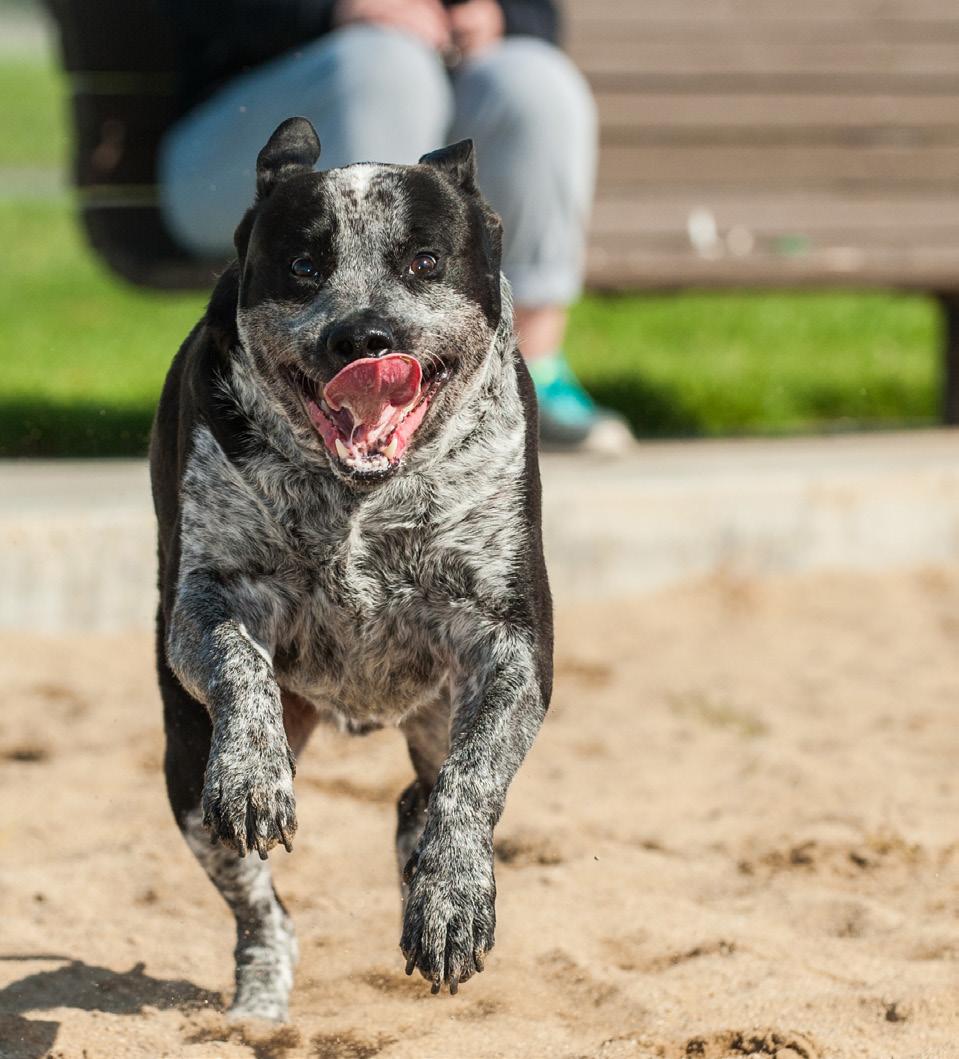
and recreation agencies to maintain and keep clean since this surface may require specialized equipment to rake it. Sand is not accessible to people using mobility devices. Lastly, during the summer months, sand may become very hot for dogs’ paws.
Mixed Surfaces
Since each surface type has its benefits and challenges, mixing surfaces may be an ideal design strategy to help ensure that traffic, seating, “potty,” and planting areas are treated distinctly, while also adding aesthetic value to the dog park. This offers dogs the opportunity to experience different types of footing and explore distinct areas within the park, while also encouraging physical activity and socialization amongst pets and their owners.

37
Dog Park Surfacing Material Considerations
Surfacing Type Advantages Disadvantages
Turf
Special Turf
Grass
Kennel Tiles
Mulch or Wood Chips
UNITARY MATERIAL
• Natural aesthetic
• Does not need mowing
• Can handle high traffic
• Natural aesthetic
• Adequate drainage
• Droppings easy to find and remove
• Less matting than turf
• Special infill that prevents bacteria buildup
• Soft underfoot
• Visually appealing Adaptable
• Good drainage
Very low maintenance
• Do not absorb odor
• Excellent for overused areas
• May require infill
• Debris can impact drainage
• May be more expensive than artificial turf
Lifetime Cost
$ $
$ $
• Requires periodic reseeding
• If tall, cannot identify and pick up dog waste easily
• Can become discolored by urine $
May be more expensive for large areas
LOOSE-FILL MATERIAL
• Easily maintained and inexpensive
• Adequate drainage
• Natural
• Recycled
Decomposed Granite
• More sterile
• Good for paths or in areas of heavy activity
• Does not retain smell of urine
• Needs to be replenished periodically due to decomposition
• Because of good absorption, it can harbor bacteria and fungus
• Difficult to pick up dog waste as it may be similar in color
• Could cause splinters in paws if low grade is used. Playground grade mulch is recommended.
• Proper drainage is required
• Will migrate downhill
• Will need to be hosed down
$ $ $
$ $ $
$ $ $
Heavily Compacted
Base Rock or Gravel
Shredded Rubber
Sand
• Easily maintained and inexpensive
• Good drainage Easy to identify waste
• Soft texture
• Does not attract weeds or insects
• Natural material
• Holes are easy to fill in
• Adequate drainage
• Droppings easy to find and remove
• Risk of ingestion
• Can become very hot during summer months
• Rough texture abrasive for paw pads
• May be more expensive
• Risk of ingestion
• Difficult to maintain and keep clean
• May require specialized equipment to clean
• Not accessible for mobility devices
• Can become very hot during summer months
$ $ $
$ $ $
$ $
Mixed Surfaces A combination of any of the above surfaces can be designed to maximize the benefits, increase the function and beauty, and ultimately, impact the budget.
38
This chart is provided as a basic overview of the various types of surfacing. Specifications can vary based on product, manufacturer, installation, usage, and maintenance
Plantings & Landscaping
Some dog parks may be designed to incorporate the living landscape for aesthetic appeal, sensory offerings, natural shade, and creating natural boundaries and borders. When planning for a new dog park and its landscape, it is important to account for toxic and non-toxic plants. While not all-inclusive, the suggestions here provide a basic compilation of some plants that have demonstrated non-toxic or toxic properties in relation to dog health.23 For additional information on desirable and non-desirable plants, please refer to the resource section at the back of this guidebook.
Non-Toxic Plants
Areca or Golden Palm
Astilbe
Bamboo
Bee Balm
Begonia
Blue Echeveria
Bugbane
Burro’s Tail or Lamb’s Tail
Butterfly Flower
Calendula
Catmint/catnip
Christmas Cactus
Cliff Brake or Button Fern
Toxic Plants
Aloe Vera
Amaryllis
Asian Lily
Asparagus Fern
Autumn Crocus
Azalea/Rhododendron
Baby’s Breath
Begonia
Calla Lily
Castor Bean
Chrysanthemum
Coleus
Columbine
Coneflowers
Coral Bells
Cosmos
Goat’s Beard
Hens and Chickens
Hosta
Impatiens
Nasturtium
New Guinea Impatiens
Pearl Plant
Petunia
Phlox
Pony Tail Palm
Primrose
Queen of the Meadow
Roses
Snapdragons
Spice Orchid
Spider Flower
Turf Lily
Violet
Yellow Corydalis
Zinnia
Corn Plant
Cycads (Sago Palm, Fern Palm)
Cyclamen
Daffodil
English Ivy
Geranium
Kalanchoe
Lilies
Marijuana
Oleander
Peace Lily (AKA Mauna Loa
Peace Lily)
Pencil Cactus
Pothos
Ribbon Plant (Corn Plant, Cornstalk Plant, Dracaena, Dragon Tree)
Schefflera
Tulip/Narcissus bulbs
Tulip
Yew
39





Non-Toxic Plants: Clockwise from top left: Turf Lily, Snapdragons, Petunia, Violets, Blue Echeveria
Toxic Plants: Clockwise from top left: Oleander, Kalanchoe, Geranium, Aloe Vera, Schefflera, Yew, Daffodil







40
Layout & Design Typologies
Providing a good variety of activities and exercise-based equipment is a fun way to promote active behavior for dog owners and dogs alike. Well-designed dog parks can be designated specifically for large dogs, small dogs, leisure play, and even formal training classes.

41
1 2 3 4 5 6 10 11 12 13 14
When including exercise-based activities, look for manufacturers that specialize in dog park equipment and select challenges for dogs of different sizes and abilities. Equipment should be slipresistant, all-weather, UV protected, durable, and resistant to vandalism and urine. These features can help make the park a destination for owners and their dogs, by expanding the recreational experiences, providing physical activity, and ensuring opportunities for socialization. Consider the following amenities to meet the unique needs of the project including location, size, user groups, and budget.
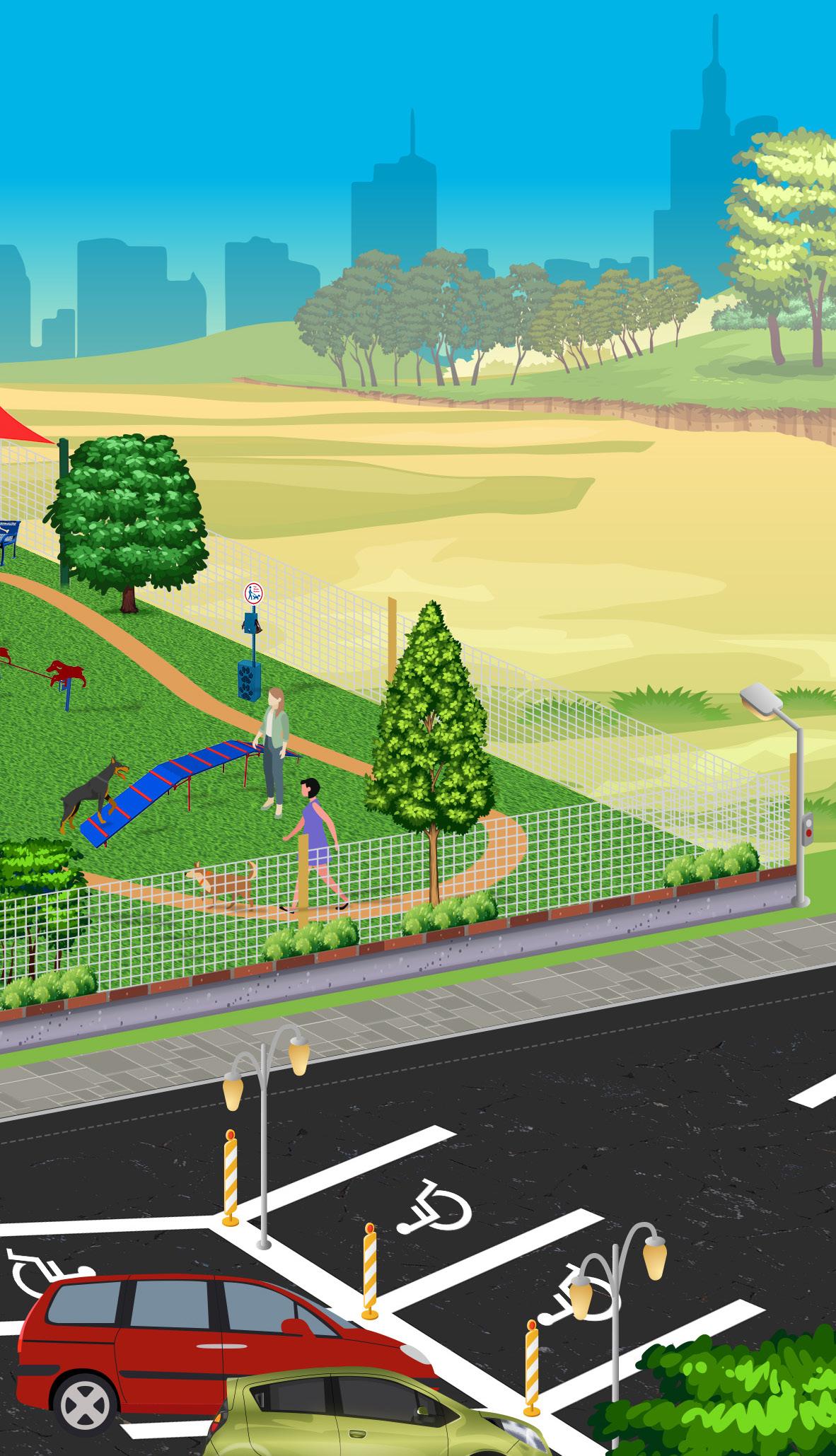
1. Trees and shrubs to provide aesthetics and shade
2. Bike parking encourages alternate modes of travel
3. Dog park rules posted prominently at entrance
4. Separate entrance to park transition area, as well as to small and large dog areas
5. Accessible route of travel from parking lot to and through the space
6. All areas fenced with a solid base to discourage digging
7. Strategically placed lighting for extended hours
8. Size appropriate exercise equipment in each area
9. Dog waste bags and receptacles
10. Shaded benches to encourage socialization
11. A mix of surfacing to emulate nature and offer walking paths
12. Separate areas for large and small dogs
13. High-Low water fountain for both dogs and their owners
14. Trash receptacles to promote park cleanliness
42
7 8 9
Large and Small Dog Combined Space
It is always a good idea to consider dog size, ability, socialization, and age in the overall design. If space allows, its beneficial to have two separate sections of the park. While this is generally thought of as small dogs (usually less than 35 pounds) versus large dogs, there are many characteristics of dogs that may qualify them as a candidate for one area versus the other.
Very young puppies, even of large breeds, may not be aware or coordinated enough for the “big dog” area. Same for dogs with disabilities, senior dogs, or even shy dogs. Ideally, a dog park will have a separate enclosure for those that may not be able or willing to join in with a larger group. Multiple entrance gates can be placed to accommodate this option.
Small Spaces
Large spaces are not always an option. In urban areas, or areas like airports, space is at a premium and minimal maintenance is welcomed. For this design, a bench, pet waste station and 2-3 obstacles are generally adequate. If space allows, a watering station is a valued addition. Dog park equipment manufacturers make ergonomically designed products that resemble natural materials like stumps and logs, but can stand up to the rigors of dog use. These products can help soften the abundance of hardscape found in these environments. They also provide an aesthetically pleasing destination for the dog owners.
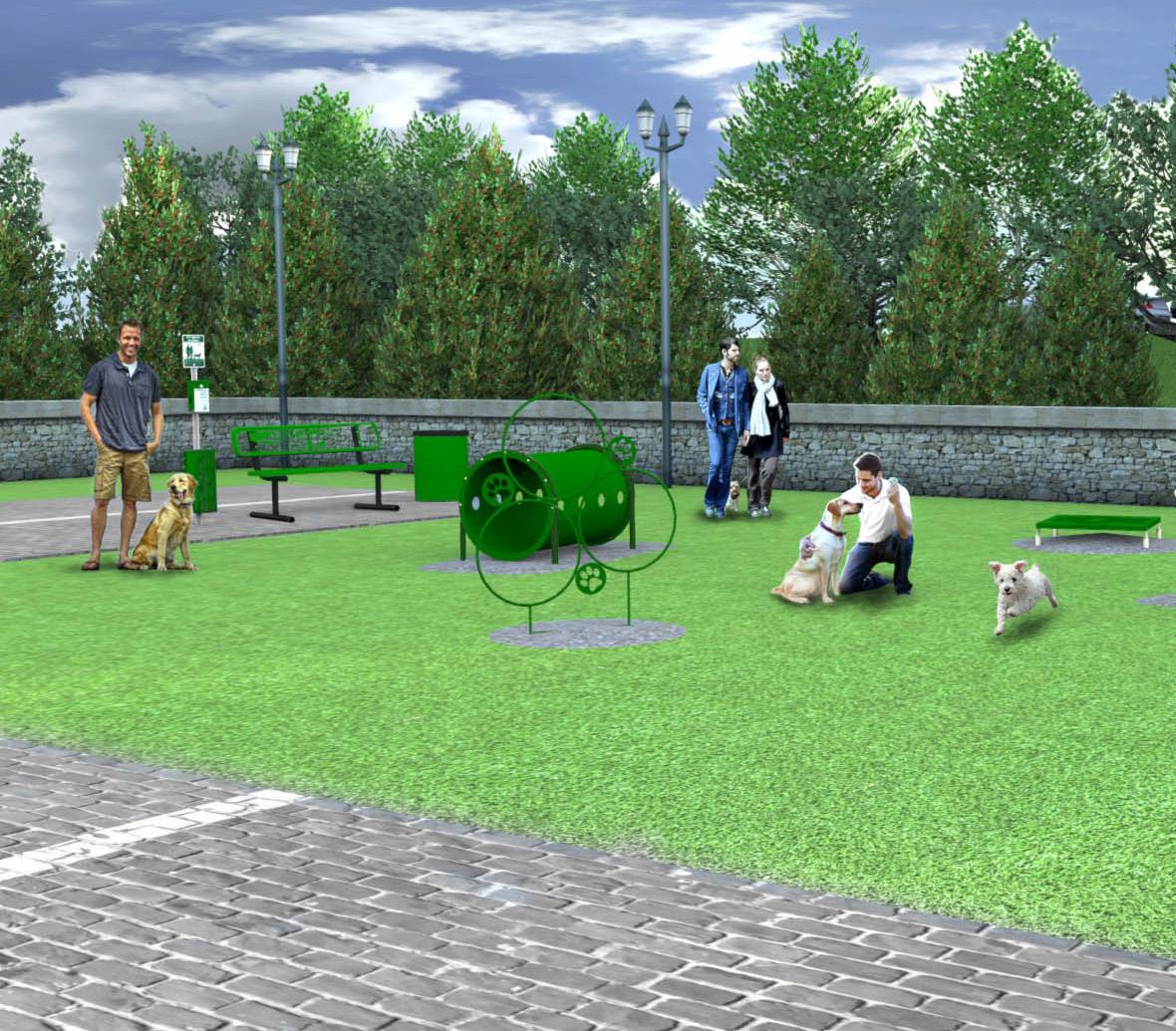
Medium Spaces
Another design option for the dog park is to create a design that encourages more formal training through exercise circuits. In this design, the dog park may be split into several areas so that there are different circuits for owners to take their dog through. This gives the owner the option to complete an entire circuit to resemble a dog show or just train their dog on a specific circuit. When designing this style of park, the main equipment recommended includes hurdles, platforms, and jump hoops.

Large Spaces
Dogs like playgrounds, too. This design is most often found on a larger, open property. Hoops, tunnels, ramps, and teeter totters are just a few of the more common items that you can find in a large space, and the obstacles may not follow a route, as with agility courses, they are laid out throughout the area, with comfortable use zones between obstacles. With this design, dogs not only have a space to run but also have a large space to play. Be sure to include water fountains for both people and pets, since the running and active play encouraged by this typology will demand frequent hydration.
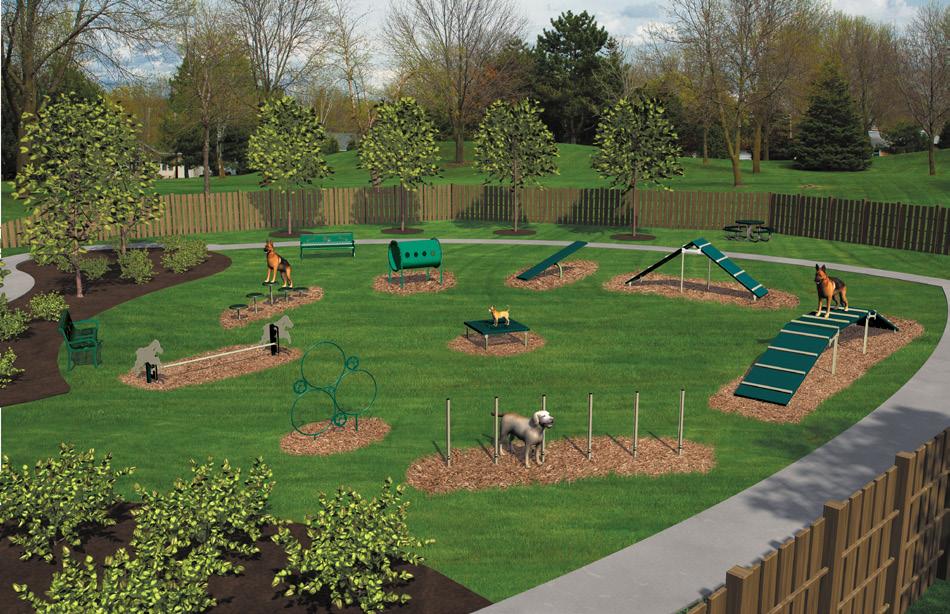
43

Free Range
If the community is fortunate enough to have wide open space available, the free-range design is a great option to exercise both dogs and their people. In addition to exercise equipment for the dogs, wide open spaces to run are part of this design. While fences are usually used to enclose the space, they are not necessary. Be sure to incorporate shady areas through the living landscape or shade structures, complimented by benches and water fountains. Locate the pet waste disposal station on the opposite side of the space, as the smell of waste will make even a cool, shady spot uncomfortable.
Multi-Purpose
In addition to providing areas for large and small dogs, adding a third area may provide additional space for obedience classes, parties, or other events. It may also serve as a temporary alternative to the large and small dog area when those spaces are out of service for maintenance or repair.
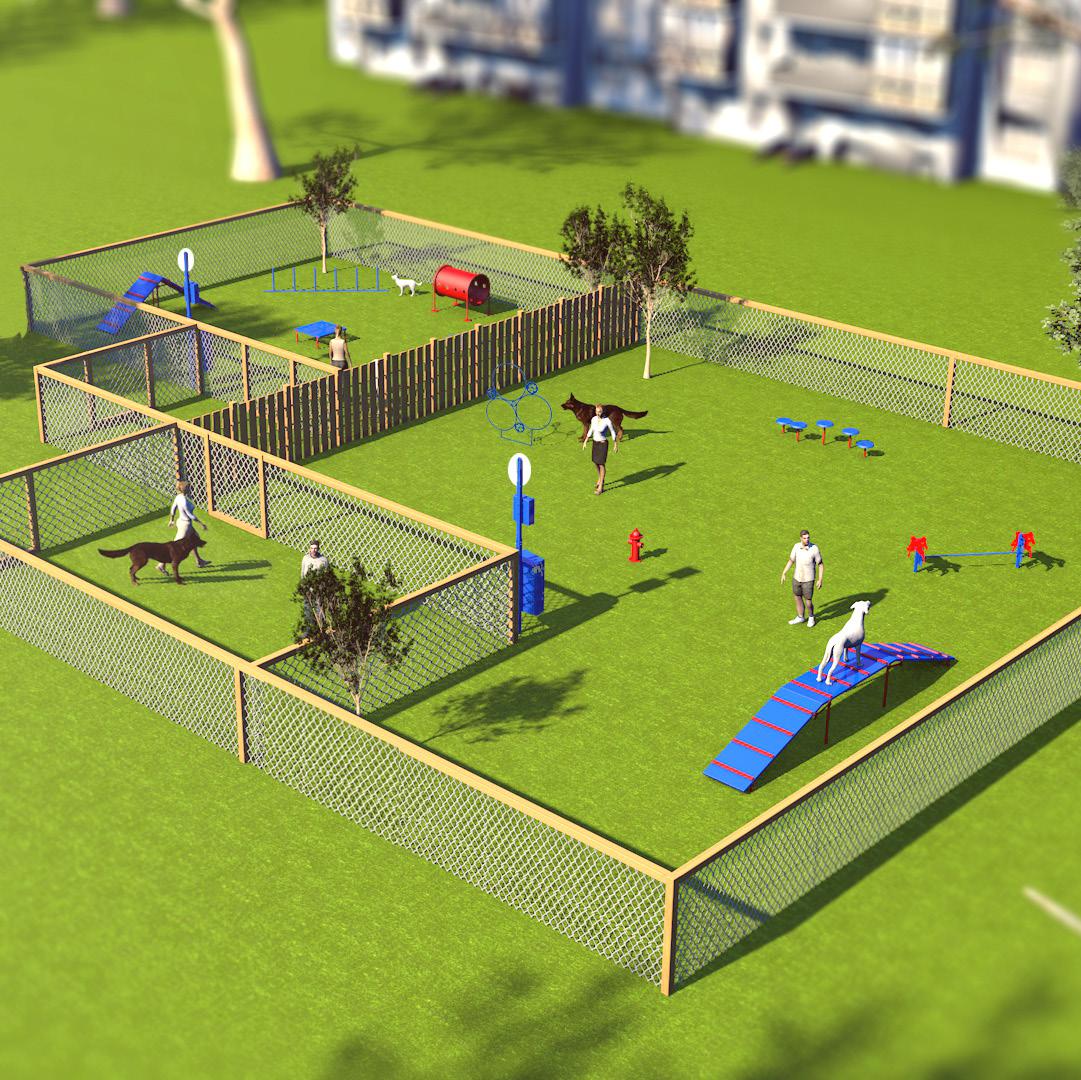
“ Once you have had a wonderful dog, a life without one is a life diminished.”
– Dean Koontz
Read more at https://iheartdogs.com/our-20-favorite-famousquotes-about-dogs/

Maintaining & Sustaining Your Dog Park
As with any outdoor space, the dog park will have to be maintained. Equipment and fence inspections as well as surface maintenance should be scheduled regularly, while tasks such as mowing, removing waste, and emptying trash should be managed more frequently.
Protecting your Investment with Proactive Planning

Consider a regularly scheduled maintenance inspection, such as closing the dog park once per week to help tend to the maintenance needs and requirements. A regular schedule will also help dog park users understand when the space is closed for inspection and maintenance.
Inspections should be routine, timely, and followed up with action. Have a system in place that ensures an appropriate response to hazards. A hazard is anything that could hurt someone. Serious hazards should be immediately repaired, removed, or taken out of service. The environment is constantly changing; your system should be capable of responding in an ongoing manner. Tip: Daily or high frequency inspections may help with responding to the dynamic environment.
Maintenance is important for many reasons. A well-maintained dog park can help dog owners and their dogs enjoy themselves in a clean, safer environment. Along with helping to promote more physical activity, a quality maintenance program has many positive outcomes.
• Protect your investment — A dog park is a significant investment. It simply makes good economic sense to protect your investment and extend its life.
• Manage risk — Proper, routine, and timely maintenance helps protect visitors from costly accidents, and demonstrates the community’s standard of care.
• Improve visitor’s experiences — When equipment is broken or otherwise unusable, visitors miss the opportunity to be more active, and may not visit again, or pick up after themselves and their dogs.
• Promote community values — Maintained environments are a source of pride for the community and an expression of your community’s values.
• Control expenses — Timely and preventive routine maintenance procedures helps control expenses by reducing upkeep and replacement cost, enabling more accurate budgeting.
45

Equipment Inspection & Maintenance
Because dog park equipment is subject to changes from use, abuse, and climate, it must be inspected on a regular basis. The frequency of inspection will be determined by many factors including equipment age, usage, materials, climate, and vandalism. Regardless of sitespecific attributes of the park, two types of inspections should be performed on all dog parks: low frequency and high frequency.
Low Frequency Inspections
Often performed quarterly or semi-annually, low frequency inspections are in-depth investigations of the equipment. This inspection requires a staff member to be knowledgeable about dog park equipment. An example of this type of maintenance would be checking that all bolts are properly secured, and that no equipment is damaged. If damage is found, immediate repairs should be conducted or equipment should be removed/replaced. Check for sharp points and edges. Use judgment to determine whether or not a point or edge could harm dogs or people; generally, all edges should be smooth and rounded. Pay particular attention to rough edges on hardware, worn or cracked materials, splintered wood, and rusted or cracked metal.
High Frequency Inspections
Often performed daily or weekly, high frequency inspections look at frequently changing conditions caused by use, weather, and/or vandalism. During a high frequency inspection, check for sanitation issues and the presence of trash and debris in the dog park. If any hazards are discovered, inspection staff should follow the appropriate procedures such as completing documentation, taking the area out of use, and/or correcting the problem.
Surfacing Maintenance & Replenishment
Surfacing maintenance will be dependent on the material used. Here are some general recommendations based on the type of material used in the dog park.
Unitary Surfaces
For all unitary surfaces, inspect the surfacing to ensure no cracks, punctures, or other damage has occurred that will require repair. Look for general wear-and-tear, paying close attention to high impact areas. Damaged areas should be patched by a certified installation crew to the same standards of the original installation. Look for foreign materials, which can be blown off or picked up.
46

Use a blower or vacuum to remove loose debris.
Hose off the entire dog park area to remove dirt and loose debris as needed.
Regularly remove loose debris such as sand, dirt, and small stones to help reduce slip hazards. It is also important to use the proper cleaner to remove problem deposits or spills from unitary surfacing. Some of the more common surface stains are bird droppings, chewing gum, and scuff marks. When treating stains, always wear gloves.
Turf Products
Basic precautions and care will ensure that the turf will maintain its appearance and performance for many years. Proper maintenance can do a lot to protect the investment for future use. It is suggested that maintenance personnel brush the surface monthly. This process involves using a power broom or a push broom. The operator should sweep against the fibers to stand the blades of turf up. Use a specialized cleaner for sanitization. As needed, top-off infill to fill in low spots. Keep surface free of leaves, grass clippings, or other debris. A leaf blower works well to help keep the surface clean. Ensure you are only blowing surface debris and not removing the infill.
Kennel Tiles
Hose off the entire dog park surface to remove dirt and loose debris, or other foreign elements as needed. On heavily stained isolated spots, while surface is damp from hosing, apply a sufficient amount of a mild household or commercial
detergent. For adequate coverage, use a handheld spray bottle, scrub thoroughly with a 10inch medium bristle scrub brush and repeat as necessary on extremely tough stains. Rinse thoroughly.
Loose-fill Materials
For all loose-fill surfaces, check to see if the surfacing is loosely packed and covering all appropriate areas. During routine inspections, regular raking of material is recommended in heavy use zones. Raking alone may not be sufficient so top-off materials may be necessary in order to maintain the proper depths in heavy traffic areas. Placement of wear mats can help reduce displacement in these areas. Remove any foreign objects such as glass, rocks, and litter and discard these materials.

47
Maintenance Considerations
Additional maintenance may be needed or required depending on the site, its amenities and surfacing, and usage.
• Tending to surfacing – filling holes and/or re-seeding
• Mowing grass
• Hand weeding/tending to landscaping (do not use toxic weed spray)
• Removing dog waste
• Spraying/hosing down equipment, furnishings, trash receptacles
• Refilling disposable waste bags and hand sanitizer
• Emptying trash receptacles
• Inspecting fencing for damage
• Tending to bacterial growth on fencing
• Inspecting gates and locking mechanisms
• Inspecting equipment and amenities
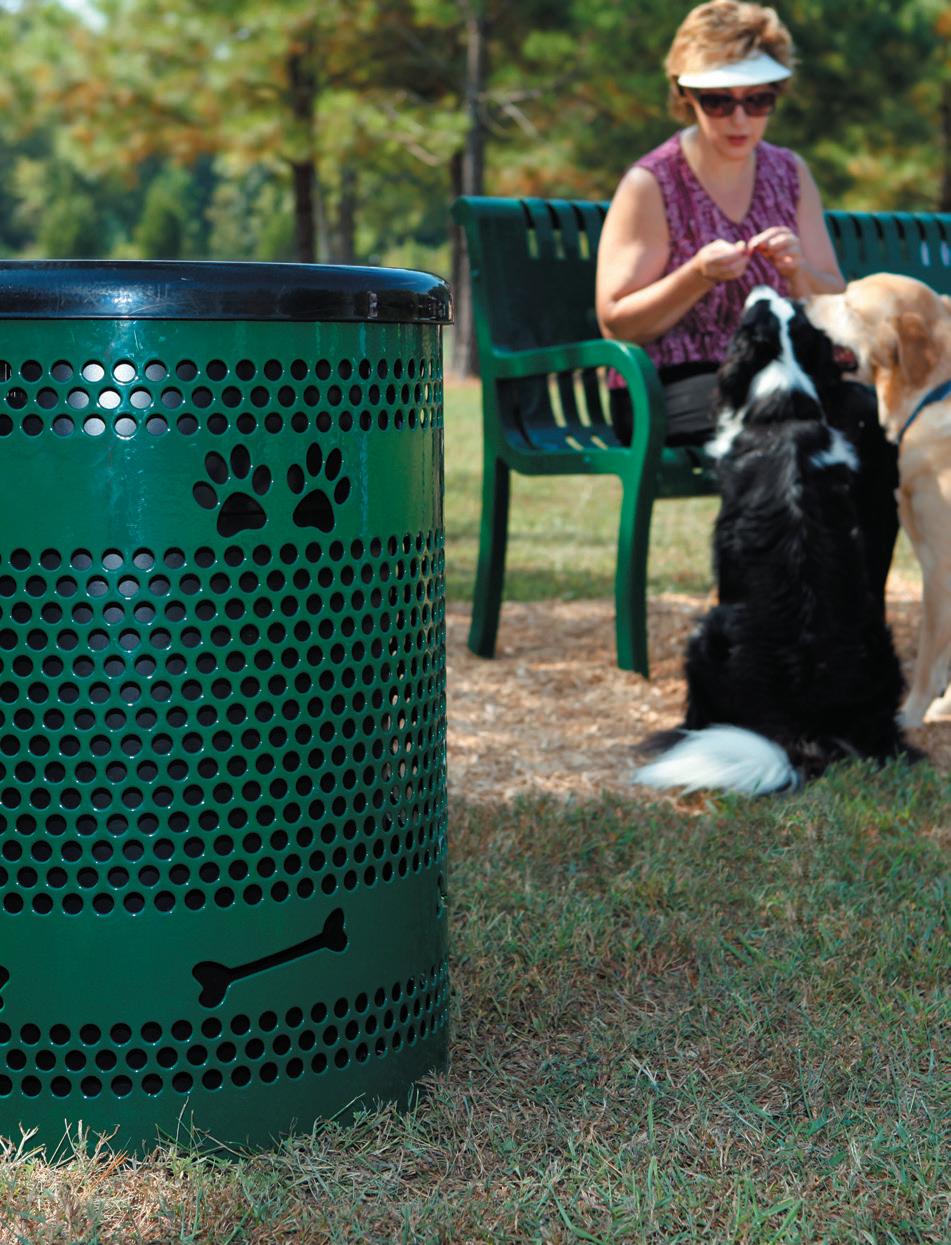
Weed Control
When maintaining the area, weeds may need to be addressed. It is a best practice to avoid any type of pesticides to help ensure dog safety. As an example, the city of Eugene, OR, maintains a pesticide free program for their park system. While pesticides may need to be used, they are a last resort for noxious or invasive weed species. To reduce the need for pesticides, the park staff employs mechanical techniques, such as mowing, propane weed burning, hand weeding, and sealing cracks in hardscape, before using pesticides. They also utilize mulch to encourage weed free areas. They try to augment their staff with volunteers, youth groups, master gardeners, and others willing to help keep the park free of weeds.
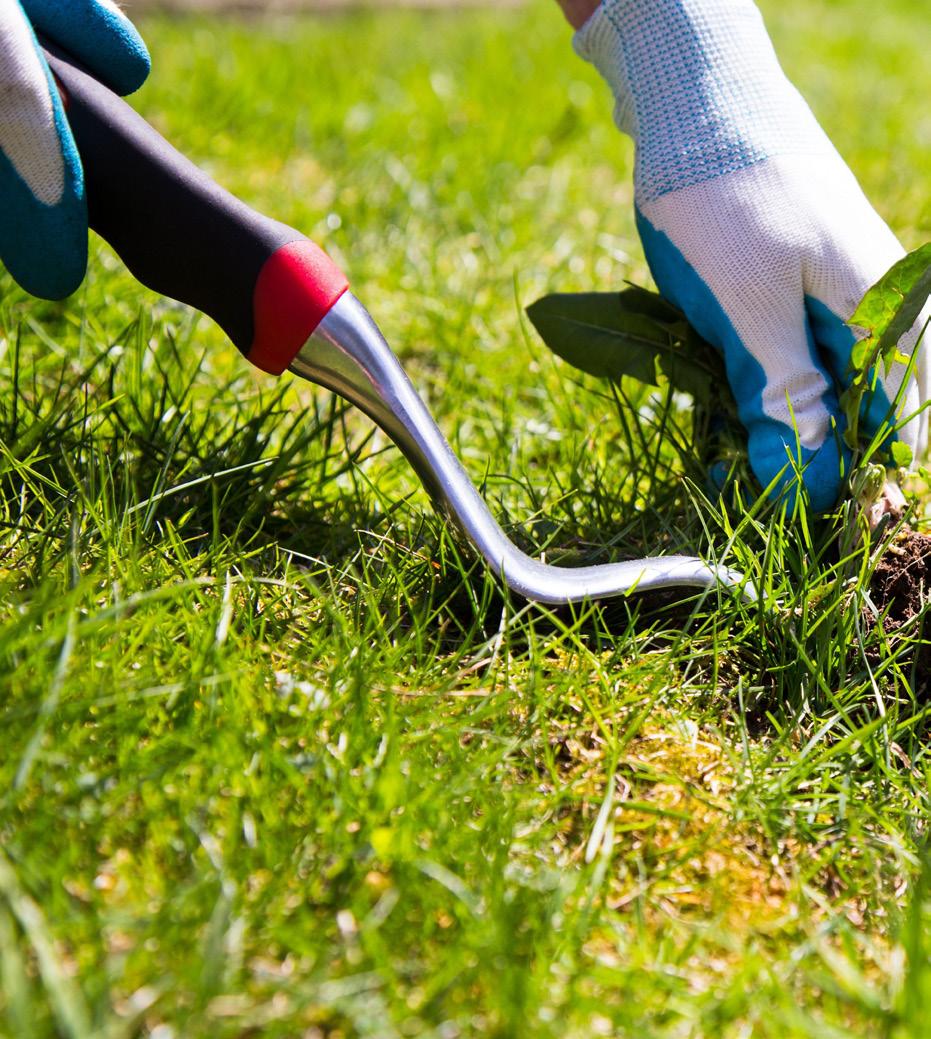
Weeds need sunlight to thrive, and if you take it away from them, they will inevitably die. This is just one of the reasons why the use of mulch is a viable weed control option. Besides mulch, utilizing turf or permeable, poured rubber surfacing in key areas of the dog park can help control weeds by creating a barrier that is difficult for weeds to penetrate.24 Consider using this method along fence lines to avoid the need for weed control, as rotary trimmers can damage fencing.
48
Properly placed trash receptacles can help prevent litter at the site.
Planning & Community Engagement Strategies
Great dog parks begin with community support. The most successful dog parks consider how they will gain the community’s support through events and fundraising efforts as well as a marketing plan to promote usage. Once the dog park is open, keep the community involved through special events that involve dog owners, dogs, and even those that do not own a pet. Providing an array of opportunities for people to enjoy themselves and others is of importance to create a more cohesive community. Well-planned programming can also be instrumental in increasing awareness of the park.
Planning & Implementation Considerations
In order to facilitate a successful dog park, it is important to involve the community in the process. The community can assist in identifying the needs and exploring additional mechanisms, which can result in long-term success. According to guidelines publicized by The AKC, Doglopedia, and others, the following are some of the most successful strategies when designing a dog park.

Identify a core group of committed dog park activists
Utilize social media and word of mouth to identify a core group of dog owners who are committed to a new dog park, and are willing to work together to see it through to the finish. These may be people you already know, or you can put a notice in the local paper to help identify them. Be sure the group understands that they will be responsible for steering the effort, including meeting with public officials, making presentations and diffusing issues that may arise.
Hold a public meeting to increase support
Once the core group is identified, a larger community meeting will help you spread the word to other supporters and enthusiasts, as well as solicit ideas and suggestions. Encourage people to write letters in support of a dog park to public officials and the media, and to make presentations to community groups whose backing would be valuable. Remember, your group will need to work positively and enthusiastically with local agencies, opponents, and others in order to be successful.
49
Write a clear mission statement
A mission statement becomes your “marching orders” and the guiding statement of your purpose. Detail the need and purpose of the park, stressing the benefits to dog owners, their canine companions, and the greater community. As an example, the Braintree Dog Park Association in Braintree, MA states “We aim to establish a fenced-in, off-leash dog park for well-behaved canine citizens to exercise in a clean, safe environment without endangering or annoying people, property or wildlife.”
Demonstrate need
Gather statistics on the dogs and the people in your community. What are your community demographics? How many would use a dog park? Who currently uses city parks and who doesn’t? Downplay the “dog factor” and emphasize people, as they will be the decision makers. Census data can be a great resource for this part of the project.
Demonstrate support
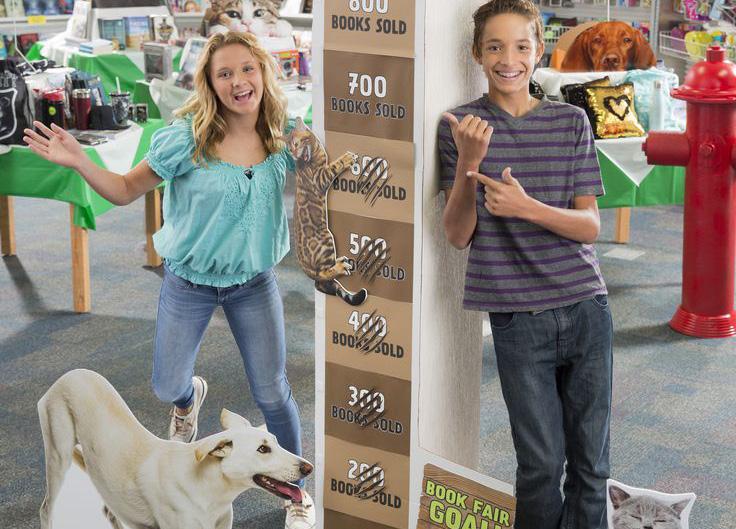
In both Belmont and Redwood Shores, CA, park advocates found that a simply worded request circulated on a petition helped convince city officials that there was both a need and widespread public support for a responsibly run dog park. Place petition gatherers at supermarkets, pet supply stores, and other high-traffic areas. Enlist the support of local veterinarians, groomers, dog walkers, and other advocates. Consider using online petition services like change.org to help gather signatures.
Create a budget
Determine how much it will cost to construct and maintain the park including costs for fences, garbage removal, lawn maintenance, drinking water, field drainage, lighting, benches, surfacing amenities, and a pet waste station. Accurate information will be vital in your fundraising efforts.
Solicit input and seek approval
Talk with the proposed park’s neighbors before talking to city hall. Pay attention to any red flags that may arise. Do not disregard these issues, instead come up with solutions to them. With good will and cooperation, neighborhood issues can usually be resolved.
Once the initial planning steps are completed, it’s time to write a proposal. It should include the mission and goals of the project, the proposed location, funding needs, as well as maintenance and enforcement outlines. Committee members will be expected to establish and enforce reasonable health and safety rules for the park, and these should be included in the proposal as well. Be sure the proposal also includes a demonstration of need and support. You should have this information from your initial planning strategies.
When you’re ready, request a hearing with city government to discuss your proposal. Have carefully selected, knowledgeable, and articulate members of your core group present the plan, clearly expressing its many benefits to the community and calmly addressing any issues. Be prepared to deal with a range of concerns, including the risk of dog fights, dog bites, noise level, parking and traffic needs, liability issues, and maintenance. Help people understand that the park will have rules to address these issues, and the benefit of dog parks in dog socialization. Have a plan to address legitimate issues, like traffic and noise.
Most importantly, be patient and flexible during this period. Dealing with city government can be time consuming, but your persistence will help ensure follow-through. By working with your team, the community, and city officials to reach a workable solution for all, the community will reap great benefits!
50
(Photo courtesy of Scholastic.com)
Partnerships & Fundraising
Securing funds is one of the most important criteria in building and maintaining a dog park. Potentially, funds may come from a municipal budget, private funding, sponsorships, partnerships, fundraising, or a combination of the aforementioned. Forming partnerships with like-minded organizations can help raise funds, as well as form potentially symbiotic relationships to share responsibilities and costs. Sponsorships are a great way to enlist businesses to fund your dog park in exchange for meaningful advertising opportunities. Additionally, an array of grant programs are available to help communities enhance local dog parks, add amenities, or help support the dog park friends group. Some ideas are listed in this chapter, for additional information, refer to the resources section of this guidebook
Public/Private Partnerships
Municipalities can partner with private businesses in a number of ways, including funding, supervision,
and maintenance of the dog park. All of the nine established dog parks in Fairfax County, VA are public/private partnerships, developed in cooperation with sponsoring organizations of pet owners. The sponsors are the agency’s liaison between users and local residents, Animal Control and the Police Department. They monitor and clean up the facilities, publicize dog park rules, and report maintenance needs to the Park Authority.
Grants and Awards
There are some significant grants and prizes available for building and renovating dog parks. At the time of this publication, an annual contest sponsored by PetSafe awards five monetary prizes to worthy projects—the top winner receives $100,000 and four runner-ups are awarded $25,000 each to fund their projects. Community funding grants can also be found at Petsmart, Petco, and Target. Refer to the Resources section for more grant sourcing ideas.

51
Dog Walk
The popular method of raising money through a walk is not limited to humans. Organize a walk for both owners and their dogs. Walkers can provide a donation based on how long they walk, or entry fees can be collected from anyone that wants to participate. Additionally, extra money can be raised by selling doggy bags to owners that forgot theirs, helping prevent your walk from becoming littered.
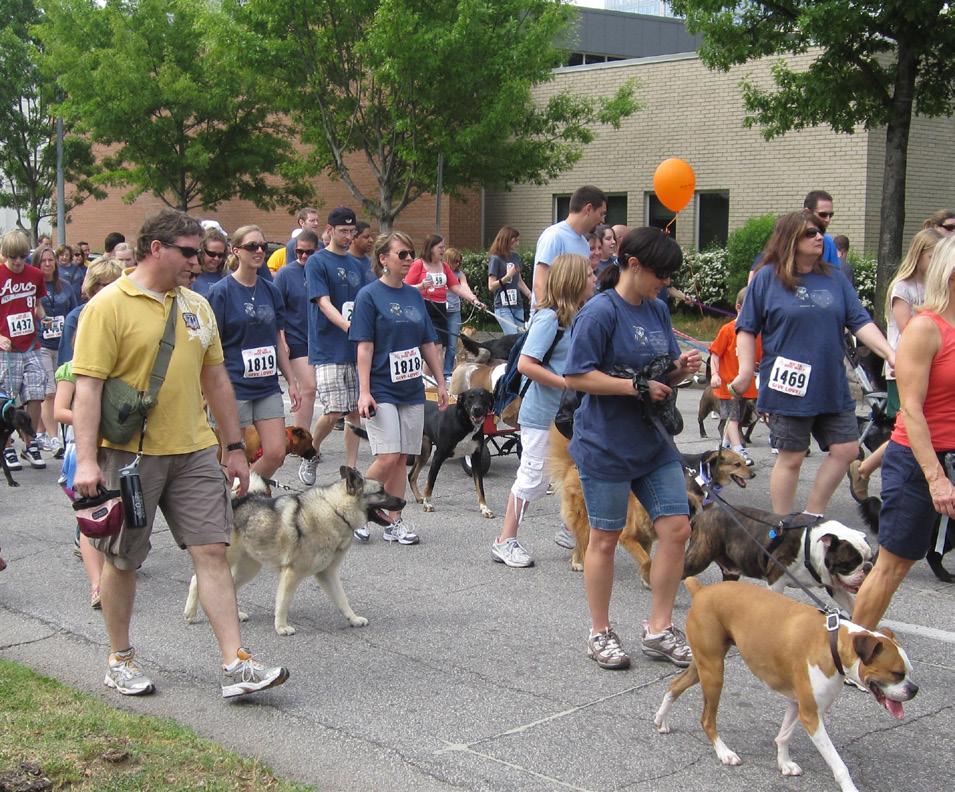
Artistic Dog House Auctions
This strategy entails enlisting local artists who would volunteer their time and abilities to leave their mark on these unusual canvases. Other artistic dog-related items can be included to offer a wider range of price points. Those dog-art pieces could be auctioned online, by phone, or as a silent auction at a planned event.

Dog Wash
A dog wash fundraising event is very similar to a car wash fundraiser. Set up different dog-washing stations complete with water and grooming supplies. Mobile groomers may want to participate and even volunteer their time to help with supplies and advice; or you can even have volunteers do the washing, leaving the grooming to the pros.
Cocktail Party
Consider hosting a cocktail party for a cause where a fee is charged at the door. Sell tickets for admission, serve cocktails and appetizers, and top the event with a silent auction. Inviting local caterers to volunteer could also help with this type of event.
Sponsor Plaques / Fence Planks
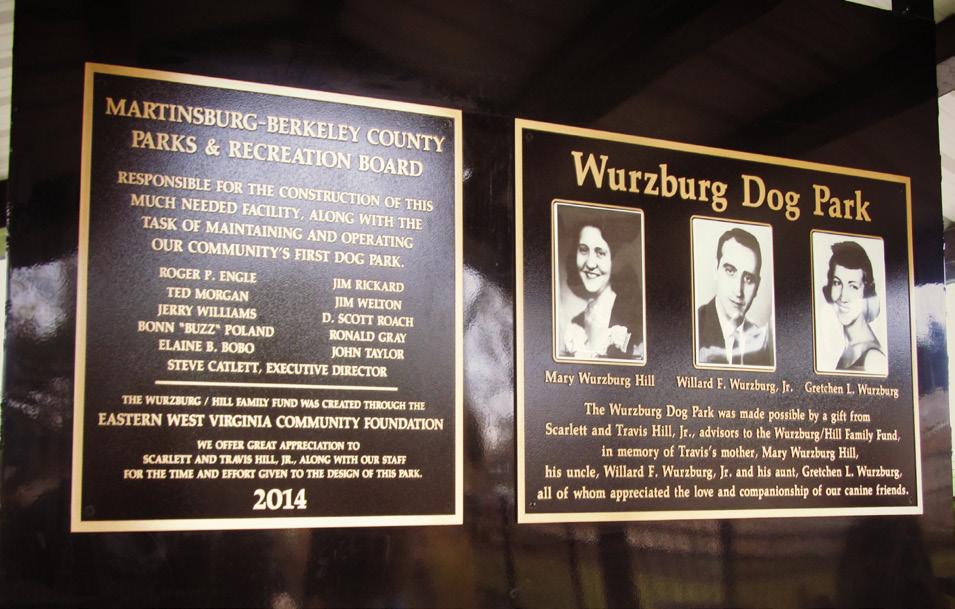
A section of the dog park can be designated for commemorative plaques/fence planks with sponsors’ names to let others know who helped fund the park. Decide on a plank design and understand engraving costs to ensure the effort is profitable.
Memorial Gardens
The dog park at Marymoor Park in King County, WA, helps support their 40-acre leash-free facility through their Pet Memorial Garden. The garden is dedicated to celebrating and honoring a living, lost, or deceased pet. The memorials include dedicating benches, trees and plantings, and installing pavers. Each remembrance option is paid by the donor, the money contributing to maintenance of the park.
52
(Photo courtesy of loveblue.com)
(Photo courtesy of unusualplaces.org)
(Photo courtesy of mbcparks-rec.org)
Sponsorship Campaigns
Start your sponsorship recruitment by writing letters to area businesses. Explain your project and the need for a new dog park, including all of the research you have done. Outline options for giving, either Bronze, Silver, Gold, or Platinum sponsorship levels, or break down the dog park plan into individual components, with the sponsorship cost of each item listed. If there are logo branding opportunities, be sure to show potential sponsors where these will be located.
Flower, Plant, and Seed Sales
Call upon the local wholesale florist or greenhouse for their assistance in this very popular event. Offer mums in the fall, poinsettias for winter, single roses or carnations at Valentine’s Day, lilies, geraniums, garden seeds in the spring and corsages at Mother’s Day. By using pre-sale forms, you will not be “stuck” with hundreds of extras at the end of your sale. However, do order a few dozen spares for pickup day. This eliminates shortage problems and allows for added sales during pickup.
Auctions
Choose a live auction with an auctioneer or a silent auction. You can limit donations to certificates only (gift certificates for dinners, oil changes, furnace cleanings, etc.) or auction off merchandise donated by local retailers, grocery stores, nearby hotels and resorts, travel agents, and sports teams. Publish a list of all items to be auctioned, their donors, and their retail value. The high bidder gets the item and the entire amount paid for that item benefits your dog park fundraising effort.
Pancake Breakfasts, Spaghetti Dinners, and Potluck Suppers
School cafeterias, churches, or community social halls could serve as the site for these gatherings. Remember that community involvement is crucial to the success of a dog park, and there is no better way to involve a community than by feeding them. If you are concerned that you lack the know how to execute such an undertaking, check with the service organizations in your area who likely have experience in this type of event.
Media Sponsorships
Invite the local media to participate in your dog park project in two very important ways. First, ask them to be the voice of your project, informing the community of upcoming events, and keeping everyone posted on the fundraising progress.
Secondly, suggest in lieu of a cash donation to your project, a donation of advertising space (or time, in the case of radio or television) for major donors. This serves as an additional incentive for businesses to donate, as they will not only receive the gratitude of the community, but also free advertising with your media sponsors.
Concession Sales
Is there a major sports or civic arena nearby? If so, there may be an opportunity to staff a concession booth with volunteers, and receive a percentage of the sales as a donation to your project. There are many other fundraising ideas such as gift wrap and candy sales, garage sales, car washes. You will find that a community working towards a common goal will get behind these efforts wholeheartedly, as they will directly benefit.
Fee-based Parks
One way to help fund the ongoing maintenance and upkeep of a dog park is through membership fees. These can be assessed via a tag the dog must wear for admission, or a passkey in the case of unattended dog parks.
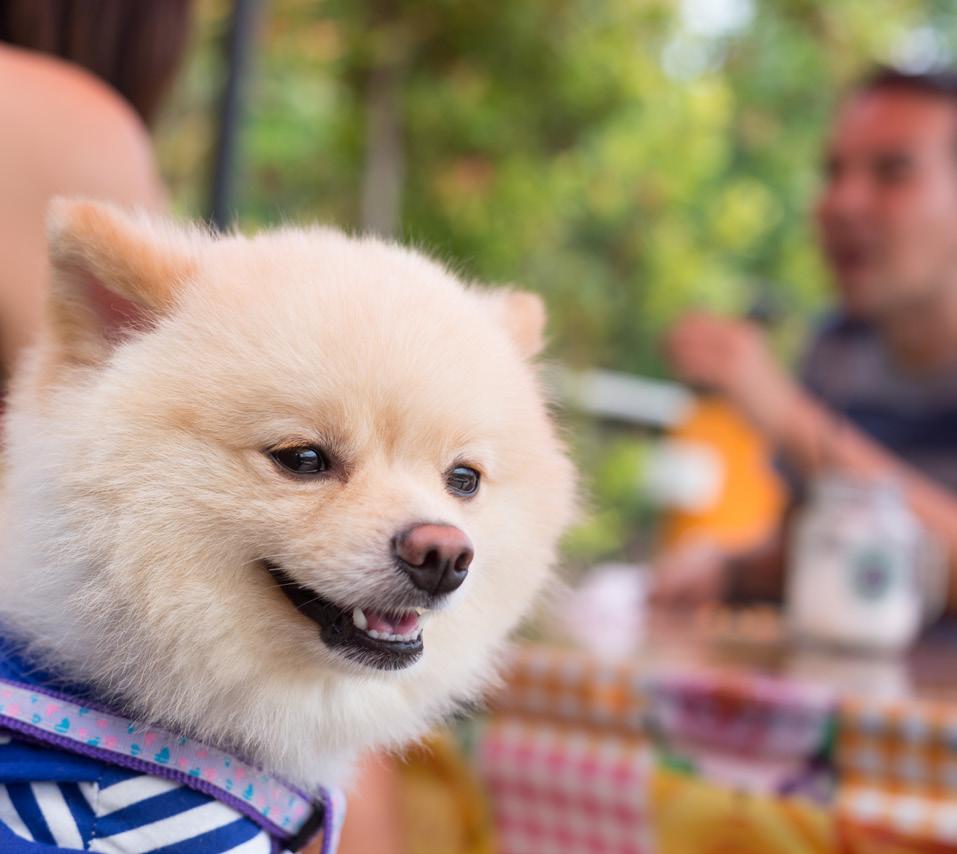
53
Membership versus Free Dog Parks
There are varying advantages and considerations for having a members only dog park versus free-toall dog parks. Consider these observations and your unique resources when making a decision about revenue opportunities.
Membership-based Dog Park Free Dog Park
Purpose Revenue generating opportunity Free community access
Amenities and Size
Rules
When paying for a membership, the dedicated areas and spaces are generally larger. Some dog parks could be as big as 4.5 acres or larger. They may include additional amenities like benches, shaded areas, rinse centers, pools, and other amenities that may be hard to find in free dog parks.
These dog parks tend to have less rules since they may have a dog park caretaker that maintains the grounds.
Cleanliness
When paying a membership for a dog park, either monthly or annually, a portion of the fees goes towards cleaning; while cleaning is still up to the owners, the attendants take care of unwanted waste and general maintenance of the grounds (i.e., mowing).
Hours
Security
Most membership-based dog parks may only allow access during certain hours. This may be because membership-based parks rely on before or after hours to perform regular maintenance and inspection.
Membership-based parks may have high vinylcoated safety gates with separate entrances/ exits. This prevents dog from escaping and from getting hurt or injured. In addition, these dog parks generally have good lighting and may have on-site attendants.
Visitors
These are more exclusive than free dog parks as some individuals may prefer not to have to pay, therefore, crowding may not be an issue –providing owners and dogs to get to know each other. However, urban dog parks may attract more people than the ones in other areas, especially during weekends when the weather is nice and people want to be outdoors.
Free dog parks may not include as many amenities as a membership-based dog park as it may be difficult to fund those features. In addition, while there may be some large free dog parks, they may not be as well-kept as the membership-based ones. However, this could be prevented by forming a “friends’ of the dog park” committee as this group could be potentially engaged in grant writing to make the space larger and include things such as agility equipment, benches, etc.
Rules at free dog parks may not be as enforced as membership based dog parks. At these parks, there may be rules posted at the entrance of the park as there may not be an on-site attendant and no one to clean up after visitors.
Many free dog parks are maintained by the dog owners and it is up to them to pick up after their dogs. While most free dog parks are clean and properly maintained, there are some that are not; dog waste and even broken toys and trash may be found.
Most dog parks have well stated hours of operation. However, some free dog parks may allow entrance 24/7.
Entrance gates may present the single most difficult issue when visiting a dog park. Some free parks may only have one gate which may make it difficult when entering/exiting the premises. Some others may lack in maintenance which may result in holes in the fences or ground that may prevent dogs from being contained.
These types of parks may have regulars, which means they will visit often, creating networks of people and dogs.
54
Marketing for Success
Marketing is a very important element in the overall success of a dog park to ensure that people know where to find the park, the hours it is open, and other useful information. Marketing need not be expensive, but ensuring you connect with the places where dog owners are available is critical for success.
Bulletin Boards
Many entities that offer services for dogs have onsite bulletin boards where other pet related businesses can post their information. Check with local veterinarians, boarders, groomers, shelters, and pet supply stores. Many services will utilize the bulletin boards, so make sure your advertisement is bright, colorful, and noticeable to differentiate from others. One way to do this is to create an 8 ½” x 11” color flyer, then fold the bottom 1/3 up to create a pocket. Insert business cards with the
relevant information (location, hours, etc.) printed on them so dog owners have an easy way to take your information with them.
Brochure Stands
Dog related businesses may also offer the option to leave trifold brochures on the counter. If so, stands can be purchased inexpensively at office supply stores, and word processing programs will generally have a template to create brochures.
Adoption Events
Check with local shelters and pet supply stores for their schedule of adoption events. This is a great way to connect with new and existing pet owners and tell them about dog parks. If your park is feebased, offer a one-day free pass to familiarize new attendees with the dog park.
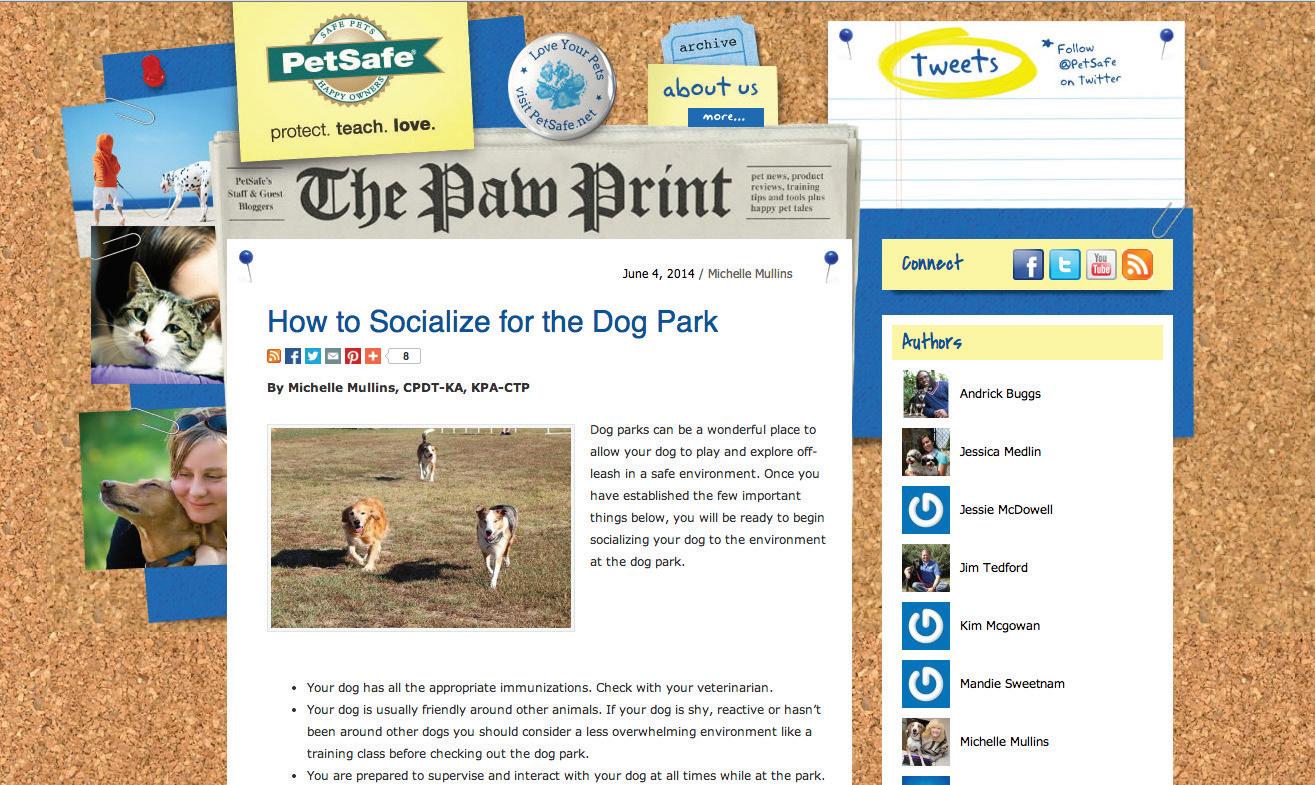
55
Dogs are not our whole life, but they make our lives whole.”
- Roger Caras
Social Media
Social media outlets like Facebook®, Twitter® , Instagram®, etc. can be valuable tools in building a dog park’s clientele. Utilize these websites to promote events at the dog park, and then invite people to attend. Dog owners love to share photos of their pets, so promote photo submissions and keep the pages fresh with images of people and their pets having fun at the dog park! You can even hold contests to promote usage, new membership, and other social events.
Website
In addition, consider having a dedicated website for the dog park, to provide visibility to the location, upcoming events, and serve as an easy way for visitors to find you. Add your dog park to databases already in existence (see resource section) where individuals can search for dog parks near their residence or when traveling. There are even free smart phone apps to locate dog parks.
Website Listings
Searching for “dog-friendly” online will result in a list of additional websites that promote dogfriendly locations across the U.S. Listing your dog park on these sites helps to demonstrate that your community welcomes dog owners. Pet owners who prefer to bring their four-legged

family on vacation will often rely on these sites as a resource for finding things to do in a destination city, so be sure your dog park is included, along with a link to your site to highlight upcoming events and programs.
Local Media
Local interest television shows and news outlets may offer another option to promote your dog park. Contact local TV stations and inquire about their schedules, often the local interest shows revolve around a theme, so contacting them at your earliest convenience may help generate interest in a pet related episode. If you can bring a (well-behaved) dog to the station with you, people love to see pets on TV. If the station will allow you
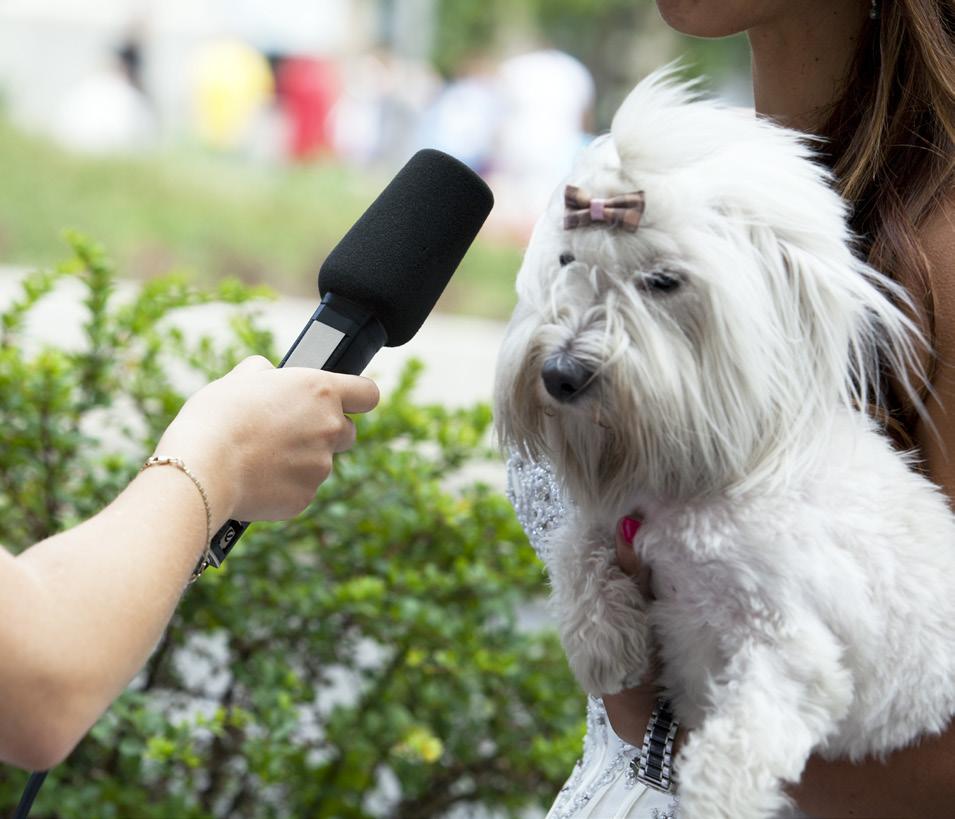
56
http://www.spiritanimal.info/funny-dog-quotes/ “
to use the taped segment (or link to it) be sure to use your social media outlets to further promote the show.
Newspapers (print and/or online) may allow you to submit an article about the park, contact them and be sure to ask for their publication guidelines in advance so you can adhere to any writing style guidelines they have in place. If your city has a magazine, don’t forget to contact them for editorial opportunities.
Video
Don’t underestimate the power of video! There are a number of meaningful ways to use it, and you don’t have to be a professional videographer, in this age of social sharing, videos made on a mobile phone are an accepted norm. Some ideas include videoing people and their pets using your facility (be sure to ask them first and record their response) to show the range of equipment and amenities your dog park offers. You can also do profile videos on pets that commonly use the dog park. Also video special events held at the dog park, like parties or dog training, so that people can see what those events are like and are compelled to attend the next one.
Videos can be hosted on your website, on video channels like Vimeo® or Youtube®, and through social media outlets like Facebook®
Carry Business Cards
Besides posting them on bulletin boards at local dog-related businesses, having business cards on hand in an important tool in marketing the space. You never know when you will meet someone interested in using or promoting the dog park, and by having a business card with the address, website, hours, and other relevant information printed on them, you don’t have to rely on someone’s memory, or whether they have time to record the relevant information.
Sell Merchandise
You may want to enlist the public to serve as walking billboards by creating a few inexpensive items branded with your dog park information. Consider caps, keychains, license plate frames
and dog bandanas as they are inexpensive, generally have low minimum orders, and are not size dependent.

Paid Advertising
You may also want to consider using paid advertising to help publicize your dog park, especially when it first opens to help people know it exists. Banner ads, and using keywords to help make your website appear in searches are two easy to use online options, and by keeping your target area local, shouldn’t be overly expensive. If your city has a magazine or advertising circular consider placing an ad announcing your grand opening.
Compelling Connections
Remember that no matter which outlets you choose to promote your dog park, creating a compelling connection with dog owners is critical for success. Rather than the typical homemade black and white brochure, remember that your advertising needs to clearly state WHY your dog park is a valuable element to the dog and its owner. Consider maximizing the usage of emotional pictures, and utilizing colored fonts for headlines and call outs for creativity.
One great way to “tell the story” is to profile a dog and its owner, and/or include testimonials from people who use the dog park. Peer reviews are one of the best tools you have to build trust with new users. A good marketer knows where their target customers are and then reaches them there with a compelling message that states the benefits for both dog and owner. This strategy is useful throughout all your marketing collateral, from brochures, to websites, to social media.
57
Programming the Space
Consider providing the community with special programs and events that will further involve dog owners, dogs, and even those that do not own a pet. Researchers stated that, “8% of all pet owners and 11.9% of dog owners indicated they took part in community or social activities involving their pets.7” There is an untapped population eager to be part of events with their dogs. Take advantage of the opportunity.
8% of all pet owners
Took part in community or social activities involving their pets
11.9% of all dog owners
Doggy Birthday Parties
Many parks and recreation departments rent their spaces for birthday parties. This allows them to charge a small fee to generate extra revenue that is then invested in the park system. The same could be done in dog parks. If a shelter or a picnic table is available, consider renting the space for those owners that would like to celebrate their loyal companion’s birthday. In addition, partnering with others in the area to provide packaged birthday options could be a great partnership to create awareness of other dog related businesses in the community.
Training Classes
Offering agility or obedience training classes is another way to provide the dog owner community with the opportunity to spend more time outdoors with their dogs. Agility training can also be a revenue-generating prospect for the owner of the dog park.
It is important to ensure that hired trainers are certified and possess the qualifications needed to provide the service. The United States Dog Agility Association, Inc. (USDAA) is the largest authority for the sport of dog agility. They offer three different certification programs: Championship program, Performance program, and Junior Handler program. Visit their webpage for a searchable database of USDAA Licensed Groups, and other agility guidelines (see the resource section for contact information).
Social Events
In Los Angeles, the Friends of Hermon Dog Park offers a monthly happy-hour or “yappy hour” at their dog park. This initiative developed from a need to let individuals know about the dog park; over time it evolved into an event for people and their dogs to meet and socialize. Throughout the years, they have developed other programs such as “Howloween” and the Big Peanut Butter Lick-off. Additional special events could include educational workshops, health clinics, or even festivals. Consider developing regular programming to build participation among locals.

Beyond the dog park, consider organizing other events that welcome dogs or even include them as a central part of the organization. Even those individuals that do not own a dog may have the opportunity to enjoy the interaction with dog owners and their dogs.
58
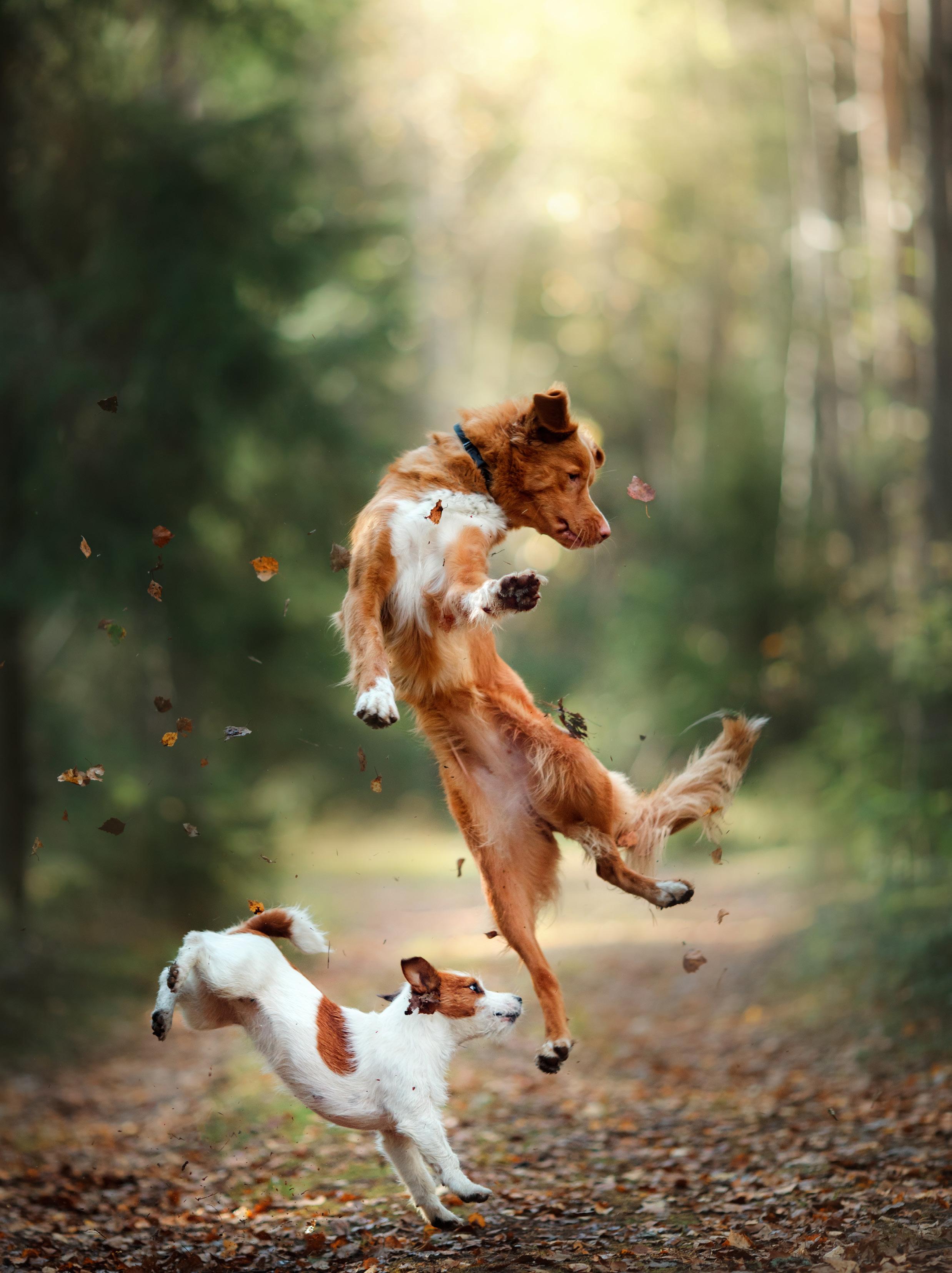
CASE STUDIES
The following case studies illustrate how a variety of organizations have embraced the demand for dog parks and created meaningful environments that benefit people, dogs, and the surrounding community.
Increasing service for stress-free travel
Buffalo Niagara International Airport
Learn about how and why providing dog parks and pet relief stations at airports is beneficial for travelers and their companions,
Yappy hour and more, putting the FUN in fundraising
Charleston, SC
Charleston County Parks & Recreation Commission’s case study provides information on how to creatively market the dog park to generate revenue and to serve dogs and dog owners alike.
Transforming an underused floodplain into a PAWpular dog park
Stockbridge, GA
Learn more about how the City of Stockbridge, GA established their first ever dog park in an underused area. With some planning and design, they were able to turn this space into one of the most visited parks in the system.
Embracing the needs of residents and donors through conscious planning and land use
Gahanna, OH
Gahanna, OH was faced with some challenges in one of their parks and with the right planning, the Parks and Recreation Department was able to turn the environment into an inviting dog park that is now one of the most visited parks in the system.
PAWineers of the RV Park Industry
Lake George, NY
Lake George RV Park spent 8 years researching the best design options for their dog park. After realizing their customers valued dogs as important family members, this state-of-the-art RV park designed an amazing 10,000 sq. ft. synthetic grass area which includes agility equipment, a misting fire hydrant, dog wash stations, and even a vending machine.
A unique partnership for increasing dogs’ and dog owners’ physical activity
Vancouver, Canada
Physical activity in humans is very important as it benefits the whole individual and this is true for dogs as well. Learn more about how a unique setting and dog training partnership increase dogs and dog owners’ physical activity, increases the bond between them, and make people happier than ever.
60
Increasing services for stress-free travel
Buffalo Niagara International Airport
With more and more people traveling with their pets, it’s no wonder that airports have become popular locations for dog parks or pet relief areas for smaller spaces. Even for pets that are used to traveling it can be a stressful time, especially in busy airports and after long flights. As most airports require non-therapy dogs to be in a carrier during both their flight and time spent in the terminal, it’s no surprise that many airports today are making an effort to provide services to people and their dogs. As a result, dog parks and pet relief areas can be found outside and/or inside many major airports throughout the U.S.
Some airports are going above and beyond, and increasing services for pets, as well as opportunities to interact with a pet in times of stress. One example is Buffalo Niagara International Airport. As with many airports, they have a dog park located outside of the secure areas of the terminal, so that travelers can allow their dog to stretch and play prior to and after exiting from secure areas. These dog parks provide a much-needed respite where dogs can get relief before heading out on a flight, or a car ride home.
In addition, Buffalo Niagara is one of a few airports in the US that offers a therapy dog service. The therapy dog program started at the airport about five years ago when local volunteers noticed that other airports had started offering the service, geared towards helping customers de-stress while waiting for their flights. Whether
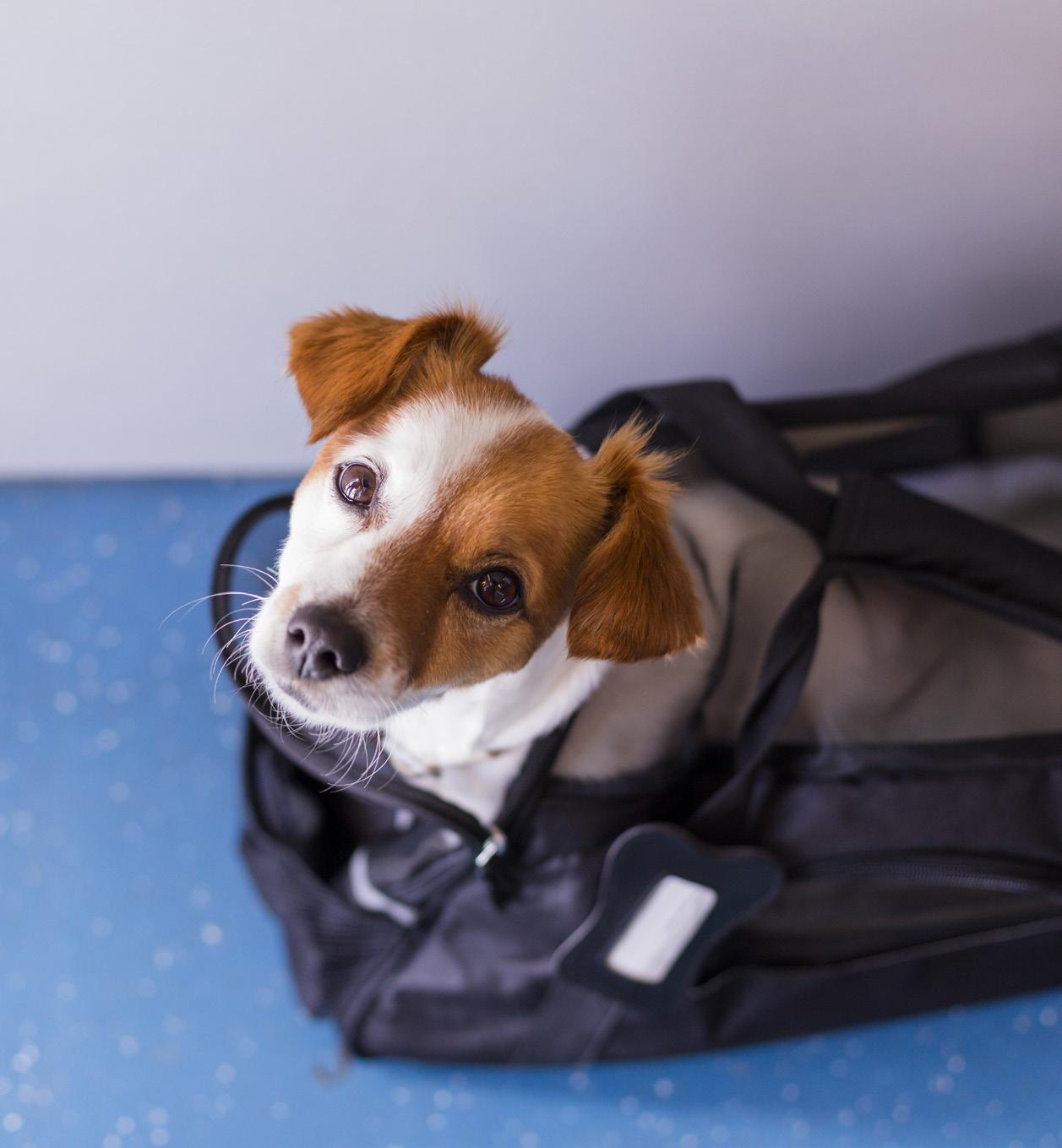
These dog parks provide a muchneeded respite where dogs can get relief before heading out on a flight, or a car ride home.”
61
a flight is delayed, a traveler is dealing with a personal crisis, or children need playtime with a furry friend, airport therapy animals provide a small reprieve, and their popularity has seen programs pop up in airports around the world, from the U.S. to Canada, and recently to the U.K. Debbie Braun, the head of the SPCA’s Paws For Love program, said she had seen an article about therapy dogs at the airport in San Jose, Calif., and she thought this could work in Buffalo. “It’s a great stress reliever,” Braun said. As a reluctant traveler herself, Braun researched her idea and brought it to the attention of Bev Halligan, customer service superintendent for the Niagara Frontier Transportation Authority at the airport, who in turn presented the idea to William Vanacek, the NFTA’s director of aviation. The idea was approved and therapy dogs started going to the airport in November 2013, and Buffalo became one of the first half-dozen airports in the country to offer this service. While they are technically “at work” while at the airport, these dogs and their handlers appreciate the services a dog area can provide as well.

Post-Security Relief
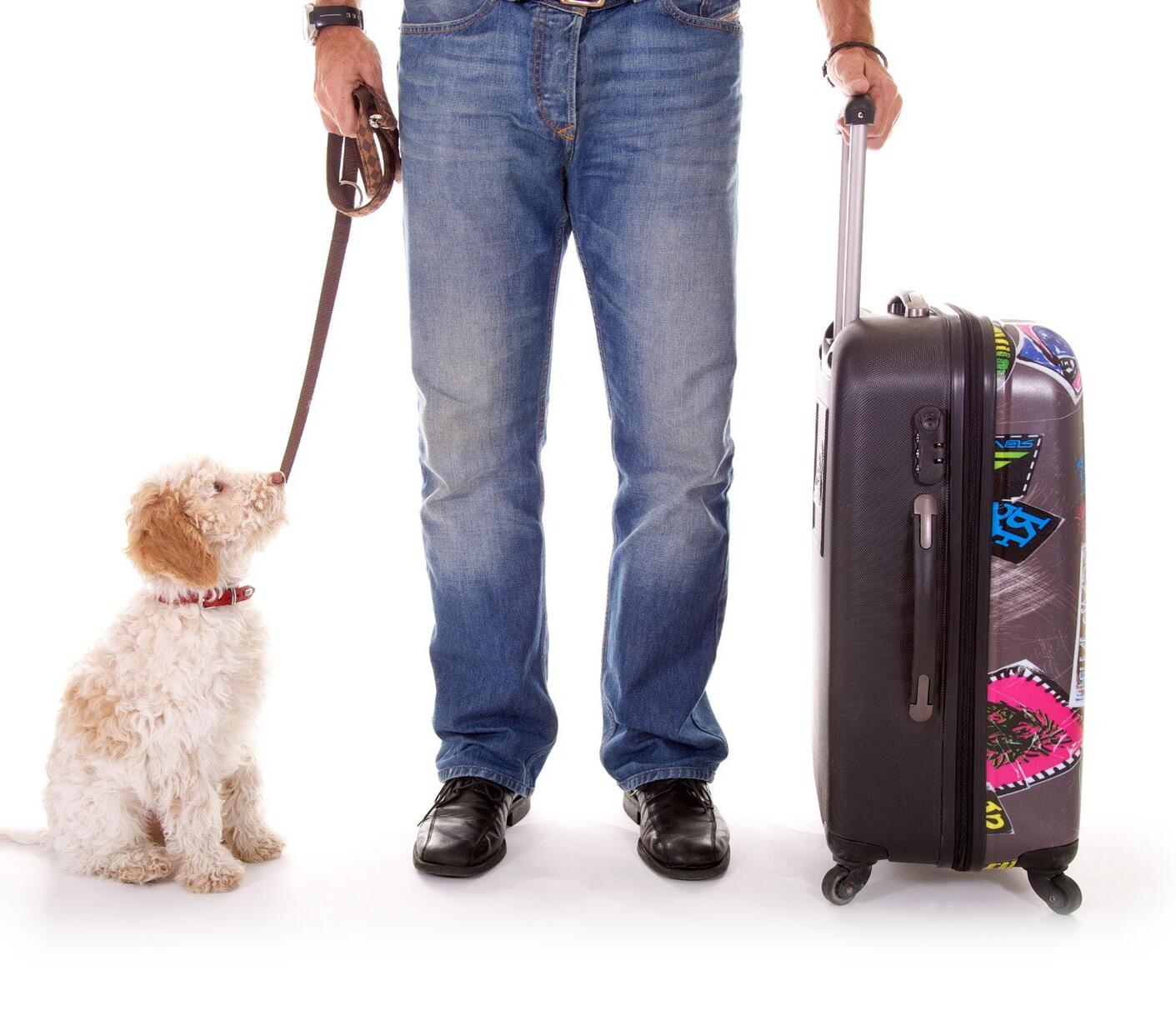
While the outdoor dog park at Buffalo Niagara is a great help to dog owners at the airport, those who have just emerged from a long flight or are making connections may not have the time or opportunity to leave the airport to find this dogfriendly area. To help in this regard, Buffalo Niagara has recently added an indoor dog area, located between airport gates 11 and 14, to provide a much-appreciated stop to dogs and their owners. “We are offering it to help our many service/dog owners and make the airport as pet-friendly as possible,” Helen Tederous, spokesperson for the Niagara Frontier Transportation Authority. The area utilizes colorful equipment, a waste station with bags, and “Pup Turf” a special surface treated with antimicrobial properties. Opened in 2019, the area is already well received by those traveling through Buffalo Niagara International Airport. They join a number of airports, such as Altanta Hartsfield or Los Angeles, CA, increasing postsecurity dog relief services, in order to ensure that all travelers are as comfortable as possible.
62
Yappy hour and more, putting the FUN in fundraising
Charleston County, SC
In Charleston County, dog parks are seen as much more than just places to let dogs release energy and roam off-leash; they are seen as spaces and destinations where people can meet others, enjoy the outdoors, relax, be physically active, and spend a good afternoon with their best friends –their dogs. Today, there are a variety of creative offerings that promote the park system goals while also generating capital to support the dog park sustainability efforts.
Charleston County Park & Recreation Commission (CCPRC) operates three dog parks in the Charleston vicinity. Their off-leash dog parks are located within larger regional parks in James Island County Park, North Charleston Wannamaker County Park, and Mount Pleasant Palmetto Islands County Park. Interestingly, each one of these three dog parks serves a diverse user group with their own unique set of goals and interests. Each frequently hosts events that bring people together in meaningful ways to promote socialization and physical activity.
Tom O’Rourke, former Executive Director of CCPRC, emphasizes that dog owners are not a homogenous group; therefore, when organizing events, it is important to consider the needs and interests of each group. He stresses that, “it isn’t about the dogs, it’s about the customer,” referring to dog owners. He goes on to explain that, “it’s more than just the dogs having fun … Are the people having fun with one another? It’s about people socializing and interacting. You can’t forget that part.”
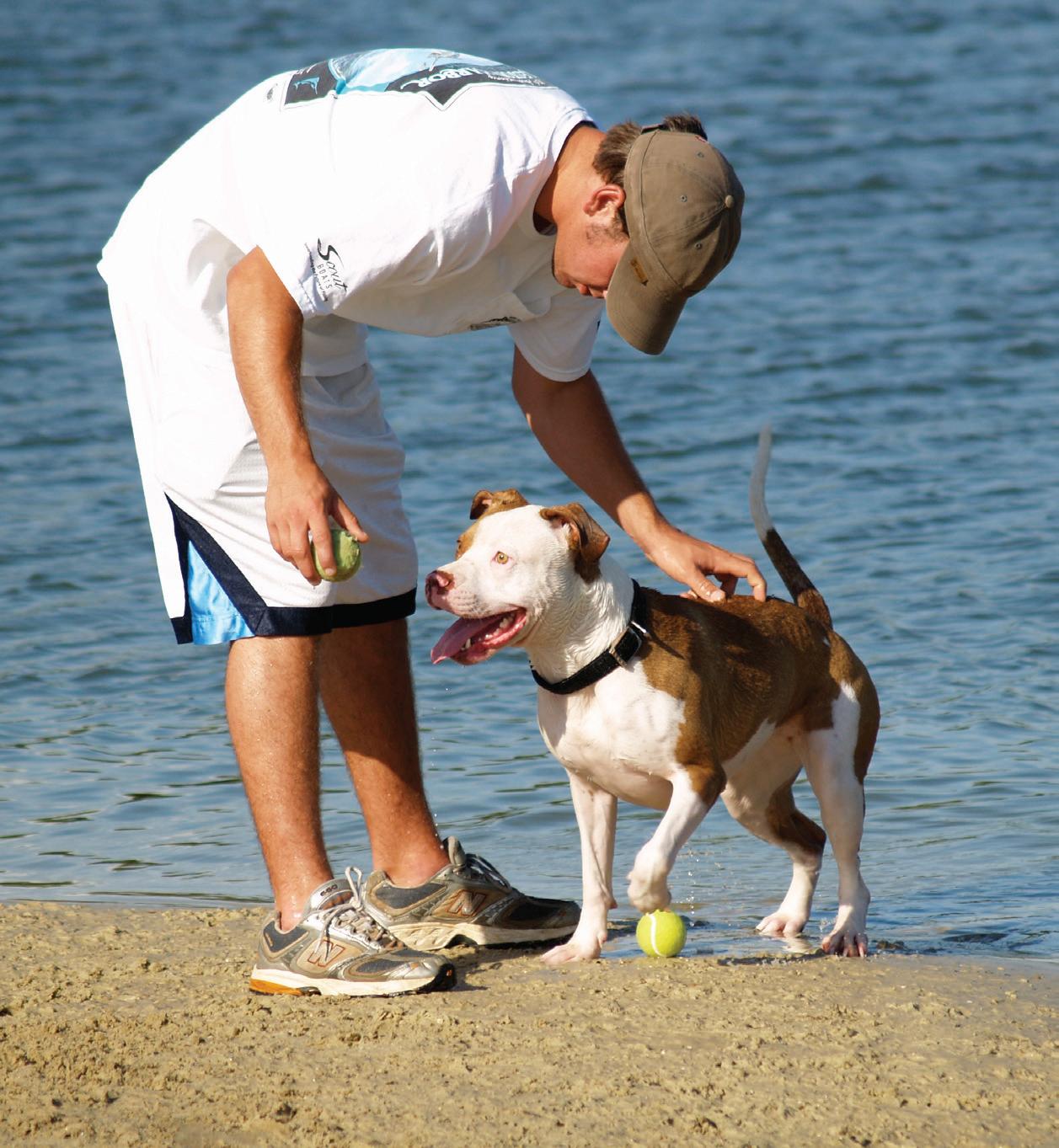
It’s more than just the dogs having fun … Are the people having fun with one another? It’s about people socializing and interacting. You can’t forget that part.”
- Tom O’Rourke former Executive Director Charleston County Park & Recreation Commission
63
Every month from, May till October, CCPRC hosts Yappy Hour. For a small entrance fee, this happyhour event includes live music from local bands, beverages, and food. In 2017, a total of 866 people and 706 dogs attended this event raising $4,754 in revenue and $1,170 in sponsorships. Another similar event held during the warmer months from May till October was Pups, Yups, & Food Trucks where local bands, beverages, and food trucks target a different group of individuals and their dogs. This last event was attended by an average of 150 people. In 2013, this event raised $4,500 in revenues and $1,800 in sponsorships; however, this event was later replaced by Bark in the Park – Oktoberfest.
Other events include Pet Fest, and Dog Day
Afternoon. Pet Fest, usually held during the last weekend of March, offers exhibits, demonstrations, experts, and entertainment. It provides an opportunity for local organizations and businesses to highlight their causes, products, and services in a pet-friendly environment. Their Dog Day Afternoon event, held in September at Whirlin Waters Adventure Water Park and Splash Island Water Park, brings dogs and dog-owners together for a unique experience before the water parks close for the season. Of course, only dogs are allowed in and around select water park features, no human swimming. St. Paddy’s Pawlooza (held in the Spring) and Bark in the Park (held in the Fall) occur in and around the dog park at Wannamaker County Park. These mid-sized events share similarities with both Yappy Hour and Pet Fest.
The former Top Dog contest was a program that picked a mascot as the CCPRC agency model. All the people in the community, with or without dogs, were invited to campaign for their favorite dog on Facebook or the agency’s website, driving traffic into the CCPRC’s own website to vote. O’Rourke explains that this simple strategy “creates much stir in the community” and a sense of belonging. The dogs’ pictures, bio’s, and stories are also featured on the website. O’Rourke adds “the dogs are often rescued dogs... adding to that feel-good aspect.”
Events are held to generate revenue and to sustain the maintenance and upkeep of the dog park. O’Rourke provides more information
regarding revenue generation by stating that dog parks “have to be operated with the same passion and creativity as a waterpark, athletic complex, or community center.” There are many other programmatic events that can be held once every year or multiple times a year such as volunteer cleanups, obedience classes, dog nutrition classes, or outreach activities where individuals may prepare care packages for K9 military units.

Bark in the Park!
Pets are encouraged to bring their owners to one of Charleston’s newest pet celebrations. A costumefriendly event offering pet exhibits, demonstrations, experts, entertainment, and more. Pet owners enjoy music, tasty food, and plenty of beverages. Pets must be restrained/leashed when not in the dog park. In 2017 a total of 637 people and 323 dogs attended the event raising $5,752 in revenue and $3,976 in profit after expenses.
64
Transforming an underused floodplain into a PAWpular dog park
Stockbridge, GA
The City of Stockbridge, GA opened its first offleash park in March 2014. Of the three parks the City manages – Clark Park, Gardner Park, and Hidden Valley Park – Clark Park is one of the city’s most popular parks with two pavilions, restrooms, a walking track, grilling area, a newly installed playground, and the new off-leash dog park.
Clark Park is the only one of their parks that offers separate fenced-in areas where small and large dogs can roam freely in their designated spaces. About 1 acre of the 11.8 acres was designated for the dog park, providing a new recreational space for community members and their pets.
Drainage considerations were certainly a top priority as the dog park was located in a repurposed floodplain. The Public Works department was able to work through the challenges by installing walking paths, sitting areas, and plants at the lowest part of the park. They installed the main agility equipment in higher zones. On a particularly wet area, an underdrain system was installed to help divert storm water to a pond which now results in more effective drainage after storms.
The dog park is located in a semi-wooded area and features three separate double-gated entrances. Two areas are designated for large dogs (over 20 pounds) and one area for small dogs (under 20 pounds), which helps protect the smaller dogs from the larger ones. Mulch and grass are used as surfacing and existing oaks

The dog park has been much needed. Stockbridge citizens have been requesting it for some time and now that it’s open, it has proven to be very successful.”
- Kevin Walter Public Works Director City of Stockbridge, GA
65
(Photo courtesy of visithenrycountygeorgia.com)
and pines are used for natural shade. Black vinyl coated chain link fence was installed around the perimeter of the park to further designate the area and promote security.
Benches, water stations, and agility equipment are additional design features that further enhance the park experience for dog owners and their dogs. Adjacent to the park is ample parking, restrooms, and a pavilion for those visiting the park.
The City Council had initially authorized capital funds under SPLOST III (Special Purpose Local Option Sales Tax) for a dog park in the city of Stockbridge but then had to pass an ordinance to allow its construction since this was the first dog park to be created in the area and current city codes did not allow dog parks.
City council members approved an amendment to the city code in December 2013 to allow an off-leash dog park within the Stockbridge city limits. The city council was successful in establishing the designated off-leash area for dogs within public city parks to serve the recreational needs of residents who own dogs without disregarding the rights of those residents that do not own dogs.
The establishment of this new off-leash dog park provides a variety of benefits for the citizens and the community at large, such as exercise and social interaction for dogs and their owners. According to Kevin Walter, Public Works Director, “The dog park has been much needed. Stockbridge citizens have been requesting it for some time and now that it’s open, it has proven to be very successful.”
At first, the dog park was to charge a small fee to the public as other dog parks in the county do; all dogs using the park were to be registered with the Stockbridge City Clerk’s office and eventually pay a registration fee. Although this was the original plan, they have decided to offer it free to all people in the community.

Clark Park - Dog Park Rules
The special off-leash area is one of the most popular features of Clark Park. Rules for visitors include:
• Use of the park is at your own risk
• Owners are responsible for the actions of their dogs
• Owners must clean up after their dogs
• Aggressive dogs are not allowed and must be controlled and/or removed
• No more than 2 dogs per owner
• No dogs in heat are allowed
• The small dog enclosure is for dogs less than 20 pounds
• Both gates must be closed and latched after entering or exiting the area
• The only food allowed of any kind is bite sized dog treats
66
Embracing the needs of residents and donors through conscious planning and land use
Gahanna, OH
Near Columbus, OH, the City of Gahanna Department of Parks & Recreation created a new dog park at Pizzurro Park. Community members had been requesting an off-leash dog park in the area and the redevelopment of Pizzurro Park offered the opportunity to grant the request and create a positive experience for the community.
Up until 2007, a small fenced-in area in an undeveloped park served as a dog park, and partially funded by a private citizen group, Pooch Playground, Inc. Due to its popularity and heavy use, it was often muddy and overcrowded. In 2007, the area was eliminated when the site was redeveloped into a community park and the City’s day camp program. At the same time, Pizzurro City was considering how to maintain the underused park in a flood plain along Big Walnut Creek.
While Pizzurro Park offered a shelter, two ball diamonds, basketball courts, a playground, canoe access, and fishing, the 23 beautiful acres of remote parkland had acquired a reputation for undesirable activities, creating discontent with donors and the community. To re-energize the park, assuage concerns, and fulfill the need for and off-leash dog area, Gahanna Parks & Recreation created a new plan. With the establishment of a Dog Park Advisory Committee (DPAC), the Department actively sought community input on how to make the space most beneficial and
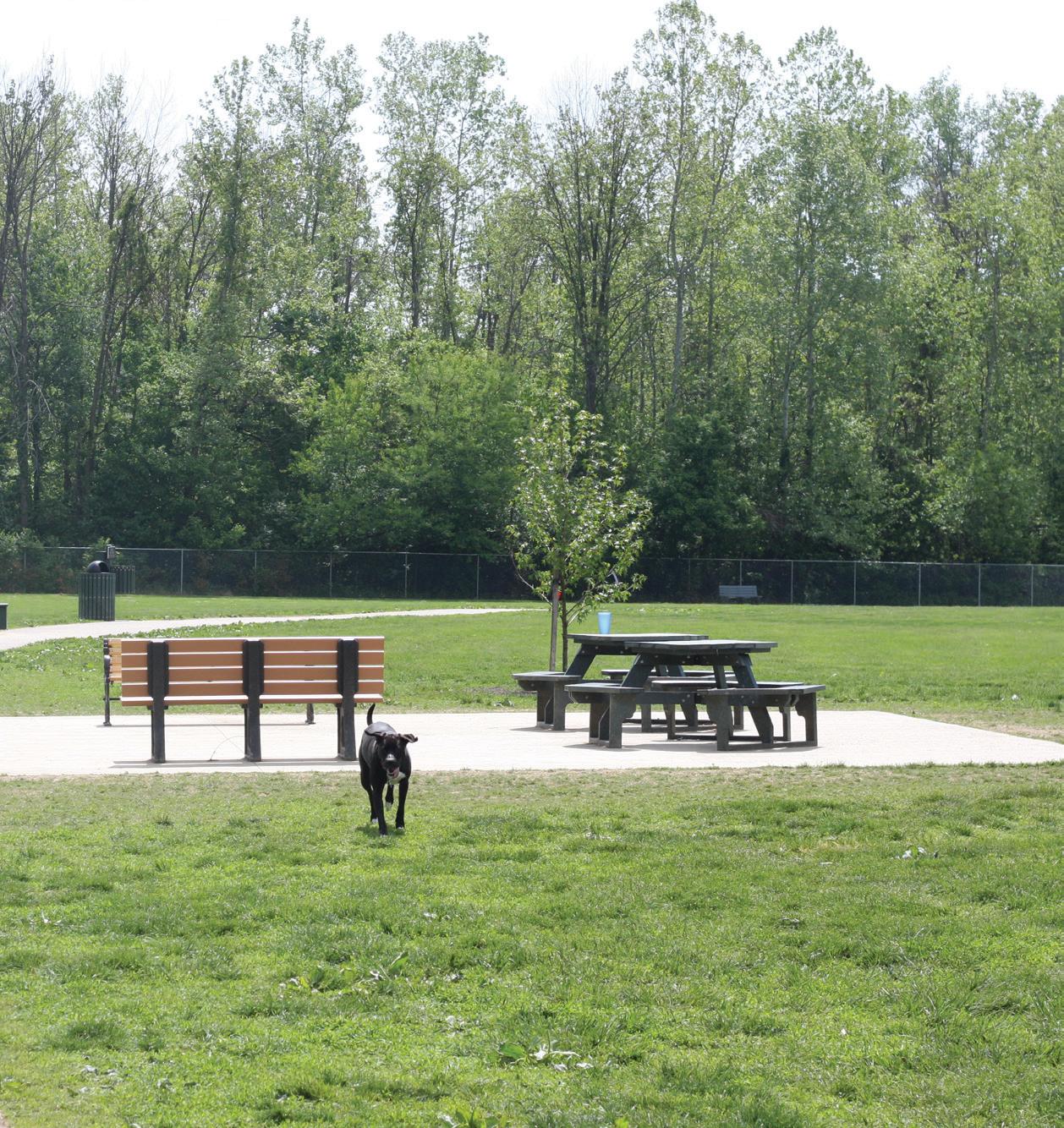
I’ve lived here for several years, but have never felt like I was a part of the community. Then, the city built this dog park where I come everyday and have met a lot of people. This park has become my community.”
- Dog Park User Pizzuro Park
67
enjoyable. The DPAC consisted of community members, local dog park advocates, Parks Board members, city administration, and members of Pooch Playground, Inc. DPAC discussions led to the identification of user group priorities and allowed the Department to balance the desired design attributes with the resource requirements.
The new site replaced two softball fields with a fouracre fenced area with 6’ chain link fencing (some of which was existing around the old outfields), sitting areas, waste stations, double entry gates, and paved paths to ensure accessibility. The new dog park includes four distinct areas: a shaded and fenced area for dogs 25 pounds or less; an agility area for all dogs; and two larger areas for dogs over 25 pounds. The larger areas can be operated separately or together as one large space, and when maintenance is being done in one area, the other remains open. Adjacent to the dog park, the Department preserved the existing playground, basketball court and shelter. A frequent visitor to the park stated, “I love that the Gahanna dog park has a paved trail within the park, and a sitting area to bring a laptop to work or socialize with other dog owners. I really get excited about going to the dog park and seeing how happy my dog gets. She is such a character and I know she brings joy to other dog owners who get to pet and play with her.”
The entire park area is free to the community and while the park occasionally closes due to high water, Pizzurro Park is now one of the most visited parks in the City of Gahanna. The Department of Parks & Recreation maintains the space daily, provides turf care, and regularly inspects the fences and gates to ensure user safety. The park is on the priority list for snow removal because of year-round site use. User groups are often observed proactively self- policing: enforcing rules such as waste removal, confronting and reporting undesirable behaviors, and contacting the Department quickly to allow for speedy resolution of concerns.
The original dog park advisory committee members, park donors, and the community provide positive feedback about the site. Resident Lynn Vermillion, Dog Park Advisory Committee, and daily park user, mentions a story about an
experience she had one morning talking with a young lady whom she did not know. The lady said, “I’ve lived here for several years but have never felt like I was a part of the community until the city built this dog park. Now, I come every day and have met a lot of people. This park has become my community.”

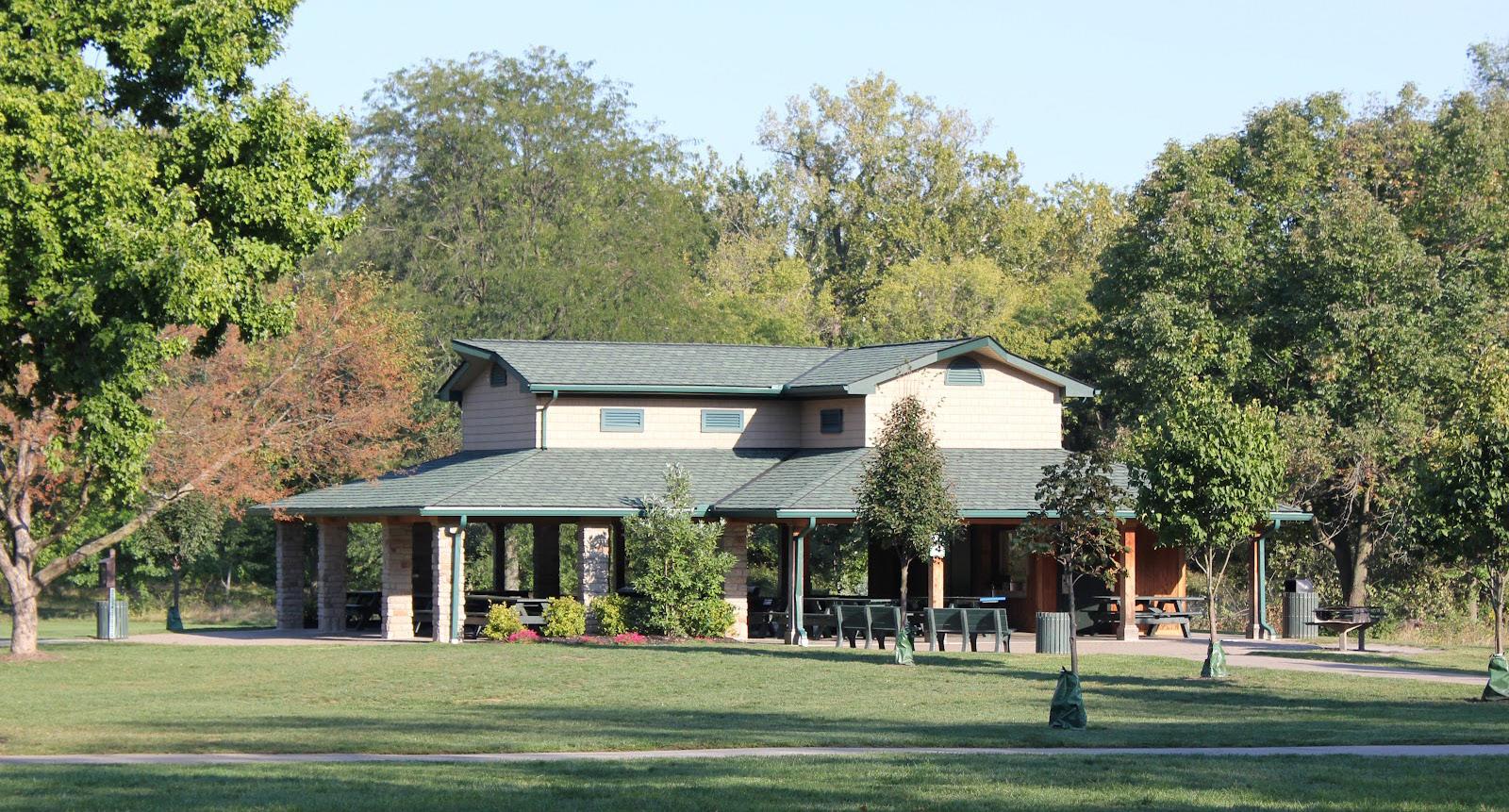
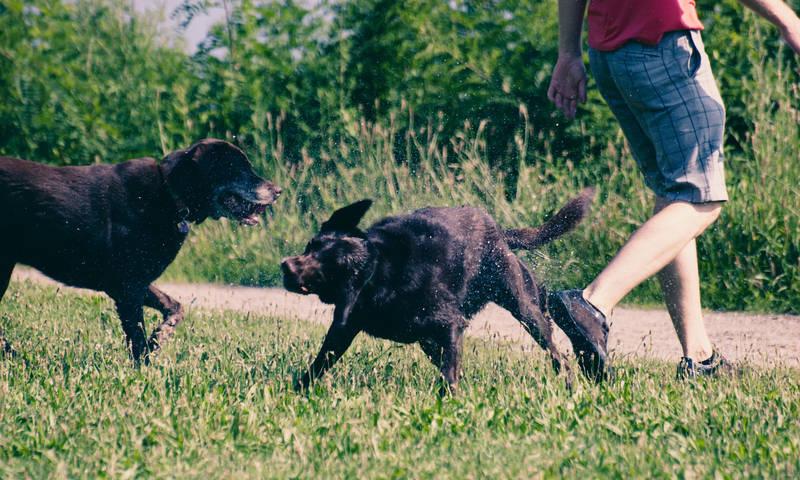
68
PAWineers of the RV park industry
Lake George, NY
Founded in 1966 by the late Vic King and his wife Jessica, Lake George RV Park is an awardwinning RV camping resort in New York and has been a model in the industry for more than 45 years. For many years they have been creating new park offerings that go beyond guests’ expectations. They have even received the highest rating from the campground inspectors at Good Sam Travel Guide (previously known as Woodall’s and TrailerLife). Lake George RV Park is one of few campgrounds in the United States to have met the newest rating criteria: 10/10*/10, the highest rating possible in the categories of facilities, restrooms, and shower cleanlieness and environmental and visual appearance. In addition, the park was one of only 42 campgrounds, RV parks, and resorts across the country to earn an all- around “A” grade in the seventh annual GuestReviews™ satisfaction survey of independent parks.
The RV Park, currently managed by President/ CEO Dave King, Suzanne Hunsicker, and their families, sits on 120+ acres and offers 400 RV campsites, fully equipped with 30 and 50 amp hookups, water, sanitary, cable TV, and Wi-Fi at each campsite. The park also offers an extensive list of onsite amenities, including an indoor heated pool, 3 miles of paved trails that connect to the Warren Country Bike Trail system, 4 playgrounds, movie theaters, live entertainment theater, horseshoe pits, fitness center, private ponds for fishing and bumper boats, and trolley service to the surrounding area.

An estimated 60% of guests bring their dogs with them to the RV park. As dog lovers, we understand that dogs are like children, and there’s nothing worse than having to leave your ‘child’ behind when you go RVing.”
- David King President/CEO,
Lake George RV Park
69
The tradition of designing new amenities to meet the needs of their clients and going beyond expectations continues today. After 8 years of extensive research, implementing a customer survey that showed guests were requesting a space for their dogs, and studying the market trends, Charlie’s Bark Park was developed.
The onsite off-leash dog park, recreation area, and pavilion is a “must-see” destination at Lake George RV Park. Reserved for registered guests only, the 2 acre off-leash dog park offers walking paths, a 10,000 sq. ft. synthetic turf play area, a spray fountain, agility equipment, and other elements that are sure to get tails wagging. The fully enclosed park has areas designated for both large and small dogs. In addition, the pavilion located at the dog park’s entrance houses a dog wash station, pet treats vending machine, and accessible restroom.
Charlie’s Bark Park was designed with dog lovers in mind. According to CEO David King, “An estimated 60% of guests bring their dogs with them to the RV park. As dog lovers, we understand that dogs are like children, and there’s nothing worse than having to leave your ‘child’ behind when you go RVing.”
Lake George RV Park has always welcomed dogs but the idea was to “create a whole park specifically for them. We feel this will be a game changer, and will increase our solid base of loyal and returning campers every season,” King said. The dog park was built in an underused area but centrally located within the RV Park. The already existing natural buffer zone to other surrounding spaces made it the perfect location, providing a barrier to unwanted noise for adjacent guests.
Even when the cost of Charlie’s Bark Park exceeded what most would invest in a dog park, the “over the top” dog park, which King says is an industry first, has exceeded the expectations of management, dog owners, and non- dog owners alike.
Maintenance is minimal thanks to highly responsible pet owners that clean up after their dog companions and police others to do the same. The RV Park maintenance staff picks up
the trash regularly and cleans the restrooms daily. Other maintenance practices include irrigation at the entrance of the dog park once or twice a week for upkeep.
Lake George RV Park offers an array of programming for guests; in the future, they hope to be able to offer programming for guests’ dogs by scheduling yoga classes (Doga) or agility 101 training classes. Also coming soon, they have invited mobile groomers in the area to bring their trucks to the park. This will be an opportunity to test new programming at Charlie’s Bark Park.
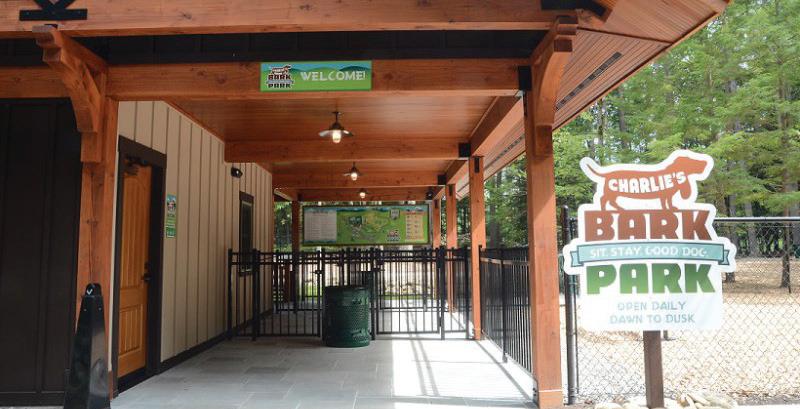
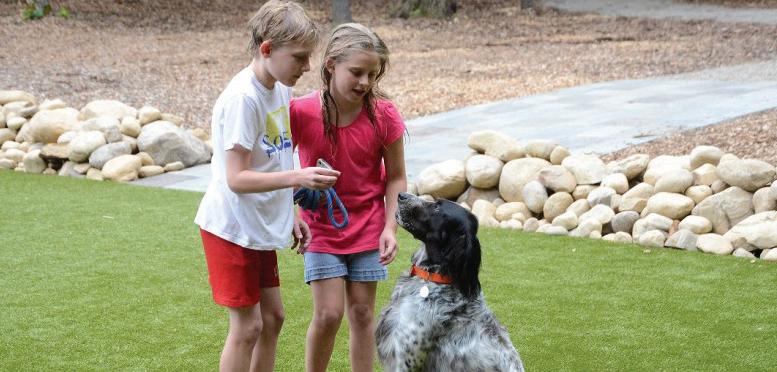
Charlie’s Bark Park – Vending
A vending machine dispenses the following:
• Locally made dog treats
• Milk bone dog treats
• Tennis balls
• Shampoo
• Frisbees
• Toys
• Grooming combs
• Dog shirts
• Dog glasses
70
A unique partnership for increasing dogs’ and dog owners’ physical activity
Vancouver, Canada
Obedience and agility classes are beneficial for both dogs and dog owners by allowing them to be physically active while learning new skills. Obedience classes for dogs provide structure for the dog while agility classes provide them the much needed physical and mental exercise. This is especially true for dogs that live in urban settings and may not have enough space to exercise, run, and play freely.
Someone that understands this well is Simone Ritter, dog agility trainer at Oh My Dog! in Vancouver, Canada. After adopting her dog, a rescued Portuguese Podengo named Jiaozi, Simone noticed he was experiencing behavioral issues including fear of other dogs. When the situation was not improving, Ritter started to research what she could do to address her dog’s condition. During the process, Ritter realized two things: 1) she loves dogs, and 2) she wanted to help not only her dog but other dog owners in similar situations.
In 2009, she was certified through The International College of Canine Behavioural Science to provide obedience and agility training classes. Simone makes one distinction though, she holds agility classes for fun, not for competition. Ritter states, “Dogs respond well to games and mental stimulation; when they are shy, anxious, or fearful, obedience and training classes allow them to come out of their shell. Agility classes can make them feel more confident utilizing the agility equipment while being rewarded for their skills.”
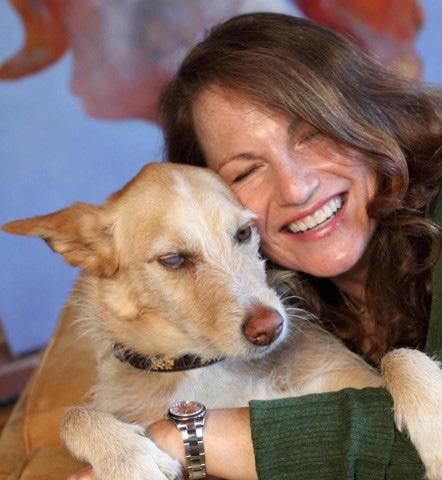
Dogs respond well to games and mental stimulation; when they are shy, anxious, or fearful; obedience and training classes allow them to come out of their shell. Agility classes can make them feel more confident utilizing the agility equipment while being rewarded for their skills.”
- Simone Ritter, Dog Trainer
71
In Vancouver, open spaces for dogs to roam freely or to hold agility classes is limited. Ritter wanted to provide an opportunity for dog owners to learn how to lead their dogs throughout an agility course, even if only for fun. This resulted in a partnership with Oh My Dog! (www.ohmydogtraining.com), a well-rated training and overnight boarding facility that utilizes humane strategies to eliminate unwanted behavior. Oh My Dog! had the space to hold obedience and agility classes, so it was a natural partnership for both parties. At this point, Ritter invested in new agility equipment to install in the existing outdoor green space at the facility. She chose a free range concept design for her space as it provides plenty of opportunities for both dog owners and dogs to be physically active. She chose to include wave posts, a hurdle, an A-frame, a bridge, a table, a jump, a vented tunnel, a set of platforms and a teeter totter as it allows for a wide range of motions, skill practice, and training exercises.
Classes are held from May through August or September (depending on weather). The weekly group classes are one-hour long lasting for

six weeks at a time. She also offers obedience classes, puppy group classes, and private inhome training. Classes start with an overview of safety, proper warm up exercises, impulse control, and rear body awareness before dogs move to the agility equipment.
Reflecting on why agility classes are important to a dog’s development, Ritter shares how exercising helps dogs release stored energy, especially for high-energy dog breeds. In addition, classes allow owners to bond with their dogs, teach them about basic obedience commands, and keep them calm and focused. She adds that most dogs enjoy the agility and obedience classes.
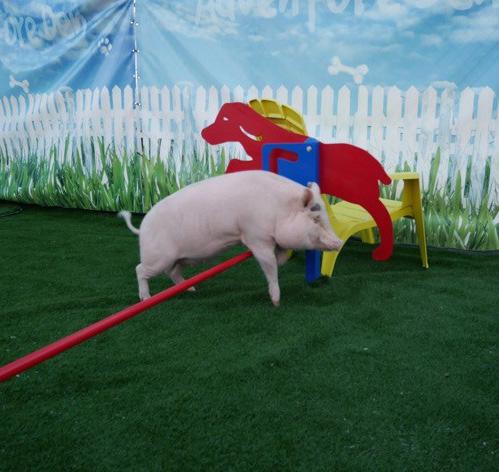
Oh My Pig!
Not only do dogs enjoy her agility classes, there is also Wilbur, the resident pig at Oh My Dog!, who enjoys working out with the dogs. Sometimes, other pigs are brought in to the daycare where they enjoy time with each other practicing their skills.
72
References & Resources
1. The Trust for Public Land. 2019 City Park Facts. Washington, DC: Center for City Park Excellence;2019.
2. Lee H-S, Shepley M, Huang C-S. Evaluation of off-leash dog parks in Texas and Florida: A study of use patterns, user satisfaction, and perception. Landscape and Urban Planning. 2009;92(3):314-324.
3. Tipping E. 2018 State of the Industry: Annual Report on the Managed Recreation, Sports & Fitness Industry. Recreation Management. Palatine, IL: Recreation Management; June 2018.
4. The Humane Society of the United States. Pets by the numbers. 2017; http://www.humanesociety.org/issues/pet_overpopulation/facts/pet_ownership_statistics.html#.UuaKNLROlEY. Accessed May 29, 2018.
5. American Pet Products Association. Pet industry market size & ownership statistics. 2017; http://www.americanpetproducts.org/press_industrytrends.asp. Accessed May 29, 2018.
6. The Humane Society of the United States. Pets by the numbers. 2013; http://www.humanesociety.org/issues/pet_overpopulation/facts/pet_ownership_statistics.html#.UuaKNLROlEY. Accessed January 27, 2014.
7. Wood LJ, Giles-Corti B, Bulsara MK, Bosch DA. More than a furry companion: The ripple effect of companion animals on neighborhood interactions and sense of community. Society and Animals. 2007;15(1):43.
8. Anderson K. Barking up the right tree: Tips & trend from today’s dog parks. Recreation Management. Vol 2010; January 2010.
9. Coleman KJ, Rosenberg DE, Conway TL, et al. Physical activity, weight status, and neighborhood characteristics of dog walkers. Preventive Medicine. 2008;47(3):309-312.
10. Cutt H, Giles-Corti B, Knuiman M, Burke V. Dog ownership, health and physical activity: A critical review of the literature. Health & Place. 2007;13(1):261-272.
11. Hart LA. The role of pets in enhancing human well-being: Effects for older people. In: Robinson I, ed. Waltham book of human-animal interaction: Benefits and responsibilities of pet ownership. Tarrytown, NY: Pergamon; 1995.
12. U.S. Department of Health and Human Services. Physical activity and health: A report of the Surgeon General. Centers for Disease Control and Prevention;1996.
13. U.S. Department of Health and Human Services. Health, United States, 2012: With special feature on emergency care. 2012.
14. Dall PM, Ellis SLH, Ellis BM, et al. The influence of dog ownership on objective measures of free-living physical activity and sedentary behaviour in community-dwelling older adults: A longitudinal case-controlled study. BMC Public Health. 2017;17(1):496.
15. Healthy Pets. Could this be the ideal baby boomer pet? 2015; https://healthypets.mercola.com/sites/healthypets/archive/2015/10/23/dog-ownership-health-benefits.aspx. Accessed June 5, 2018.
16. Graham TM, Glover TD. On the fence: Dog parks in the (un)leashing of community and social capital. Leisure Sciences. 2014;36(3):217-234.
17. Gelbach C. Barks and recreation: The latest dog park trends to please your most loyal patrons. Recreation Management. Vol 2013; April 2013.
18. The Humane Society of the United States. Dog parks and their benefits. 2014.
19. Barker RT, Knisely JS, Barker SB, Cobb RK, Schubert CM. Preliminary investigation of employee’s dog presence on stress and organizational perceptions. International Journal of Workplace Health Management. 2012;5(1):15-30.
20. United States Dog Agility Association *(USDAA). Rules and regulations: Obstacle requirements. 2018; http://www.usdaa. com/rulesReg_ObsReqs.cfm. Accessed May 29, 2018.
21. American Kennel Club. Establishing a dog park in your community. 2008.
22. U.S. Department of Justice. ADA design guide: Restriping parking lots. 2013; http://www.ada.gov/restripe.pdf.
23. UC Davis School of Veterinary Medicine. UCD toxic plant garden. 2018; http://www.vetmed.ucdavis.edu/ccah/dogs/toxic-plant-garden.cfm. Accessed May 29, 2018.
24. City of Eugene Oregon. Pesticide-free park program: Pesticides and Eugene’s Parks. 2018; https://www.eugene-or.gov/633/Pesticide-Free-Parks-Program. Accessed June 5, 2018.
25. Choron S, Choron H. Planet dog: A doglopedia. New York, NY: Houghton Mifflin Company; 2005.
73
Resources
American Kennel Club www.akc.org/
American Pet Products Association www.americanpetproducts.org
American Society for the Prevention of Cruelty to Animals (ASPCA)
www.aspca.org/pet-care/animal-poison-control/ toxic-and-non-toxic-plants
Animal Legal & Historical Center www.animallaw.info
Bark Park – Dog exercise equipment www.dogparkproduct.com
Bring Fido www.bringfido.com
Committee for a Coastside Dog Park (CCDP) www.coastdogs.org
Designing a Model Dog Park Law www.animallaw.info/articles/ddusdogpark.htm
Dog Goes – Dog park database www.doggoes.com/dog-park-usa
Dog Park Locator
iPhone app itunes.apple.com/us/app/dog-parkfinder-plus/id372419544?mt=8
Android app www.play.google.com/store/apps/ details?id=com.parkbark&hl=en_US
Dog Park Locator Apps www.techwalla.com/12000015/these-4-apps-willhelp-you-sniff-out-the-best-dog-parks
Harrison Forbes, Animal Behavioralist, Dog Trainer, Author www.harrisonforbes.com
Humane Society of the United States secure.humanesociety.org/
Parkology
www.parkology.org/ (provides amount of dog parks per 100,000 residents among other information once city has been selected)
Pet Poison Hotline www.petpoisonhelpline.com/ poisons/ or 800-213-6680
Planet Dog: A Doglopedia (Book) ISBN-10: 0618517529
Redwood City Responsible Dog Owners. Nancy Morales, 650-369-4991, pmsearch@best.com
So You Want to Build a Dog Park? A Comprehensive Guide for Municipalities and Private Entities. From Susyn Stecchi, DogParksUSA, www.dogparksusa.org
The Kennel Club
www.thekennelclub.org.uk/
Trupanion – Guidelines for dogs in the workplace https://trupanion.com/pet-care/pets-in-theworkplace/getting-started
United States Dog Agility Association, Inc. (USDAA) www.usdaa.com
Wagtown www.Wagtown.org/
Funding Sources
Doris Day Animal Foundation
www.dorisdayanimalfoundation.org
American Humane Society Grants www.americanhumane.org/program/grants-awards/
List of Animal Welfare Funding and Fundraising
www.library.wisc.edu/memorial/collections/grantsinformation-collection/resources/animal-welfarefunding- and-fundraising/
Nutro Room to Run
www.nutro.com/about-us/nutro-communityinitiatives
Petco Foundation Grant Opportunities
www.petcofoundation.org/for-partners/investmentopportunities/
PetSafe Foundation
www.petsafe.net/barkforyourpark/
PlayCore Funding Source Tool www.playcore.com/funding
The Stanton Foundation Dog Park Grants
www.thestantonfoundation.org/canine/dog-parks
Walmart Community Grant Guidelines
http://www.walmart.org/how-we-give/localcommunity-grants

74









 Harrison Forbes Animal Behavioralist, Dog Trainer, Author www.harrisonforbes.com
Harrison Forbes Animal Behavioralist, Dog Trainer, Author www.harrisonforbes.com













 The Humane Society of the United States suggests a 1-5 acre space, however, smaller dog parks can be as successfully designed considering limitations in available space.
The Humane Society of the United States suggests a 1-5 acre space, however, smaller dog parks can be as successfully designed considering limitations in available space.

















































































































